AD&D: 2nd Edition by PurpleXVI
Did I mention this book is packed with fucking sweet art?
Original SA post AD&D: 2nd Edition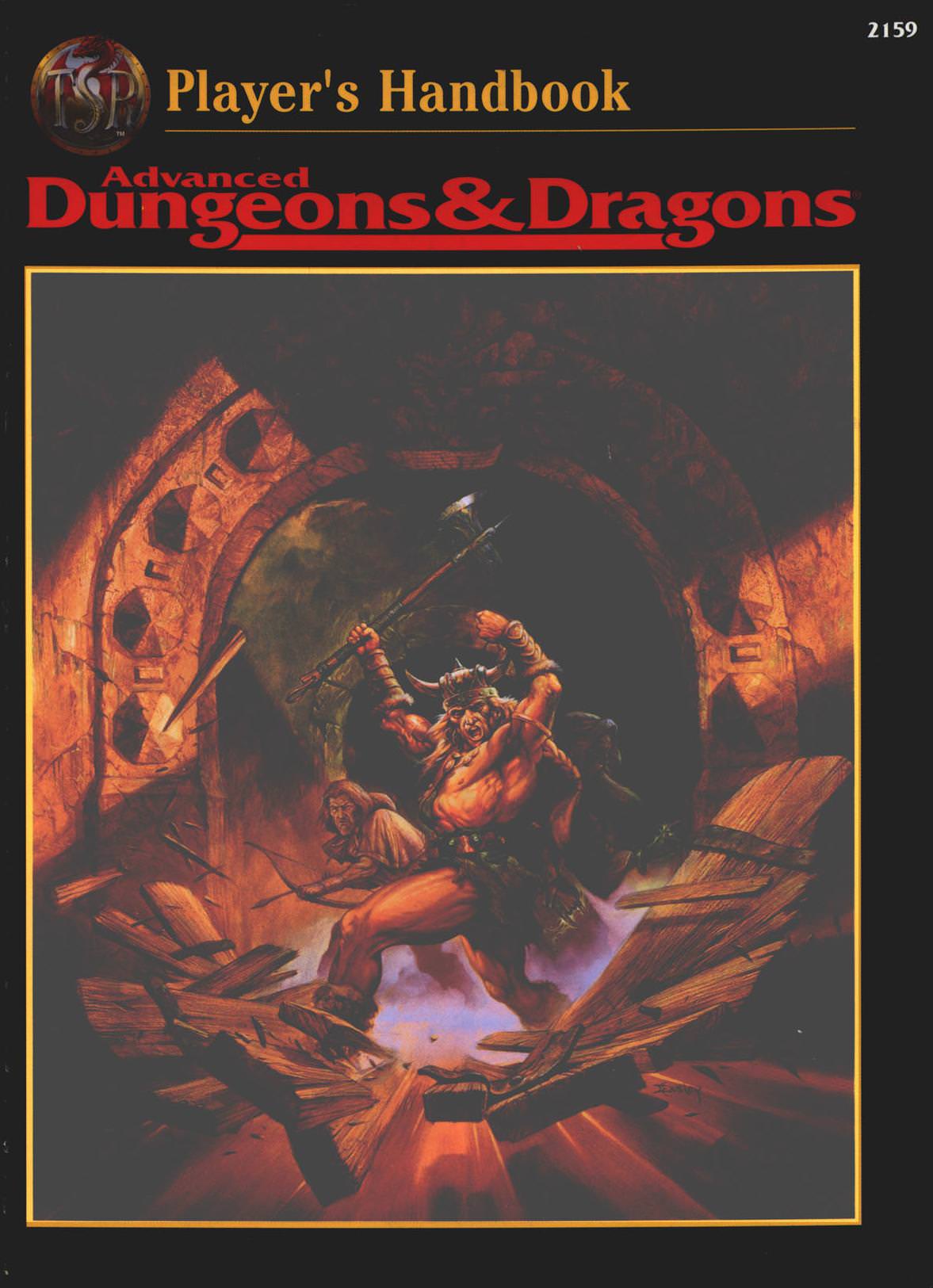
Welcome to AD&D: 2nd Edition. While I can appreciate things about, almost, every other edition of D&D, this has always been the one that's been special to my heart. Not because it was my first, that was the actual first edition playing in a Dragonlance game when I was like... eight, or so. Not entirely because of all the cool settings and expansions for it, though they did play some part. But because, to me, it's always felt like the D&D that was closest to getting it right. And I could write a rambling, happy essay about what I felt they got right.
Halloween Jack posted:
Sure, especially if you can compare it to other rulesets. Seems like some old-schoolers have very strong feelings about 2e that are based more on the overall trends in campaign settings during that period rather than the actual ruleset.
But I think what's more interesting is what they got right that I feel other editions didn't, which is probably a good starting point for reviewing 2nd ed. Because the corebook, even the monster book and the DMG, are completely void of any actual setting. There's an assumption that you'll be playing in something medieval-verging-on-renaissance, with some magic and monsters and heroes, but that's it. No world map, no great conflicts, no premade NPC's, nada. All that was the realm of the various sourcebooks you could snag, of which we've seen a few reviewed(Birthright, Dark Sun and Planescape for sure). So without some compare and contrast, it's a pretty dry matter if you haven't experienced and aren't hype for it.
And I'll be honest: I'm probably one of the very few people who actually love 2nd ed. In a way it's kind of the "lost" or "forgotten" edition. The old schoolers are big fans of BECMI and older, champions of OSR, and consider 2nd ed a muddled, over-complicated build on top of their perfect game(sorry if I'm misrepresenting anyone, but these are the OSR guys I know). People who came in with 3rd ed or 4th ed make fun of Thac0 and consider it a game for the die-hard grogs who've yet to get with the times. Fuck 'em, though, 2nd ed is the best D&D we got, and it has the best cover that any of the PHB's ever got.
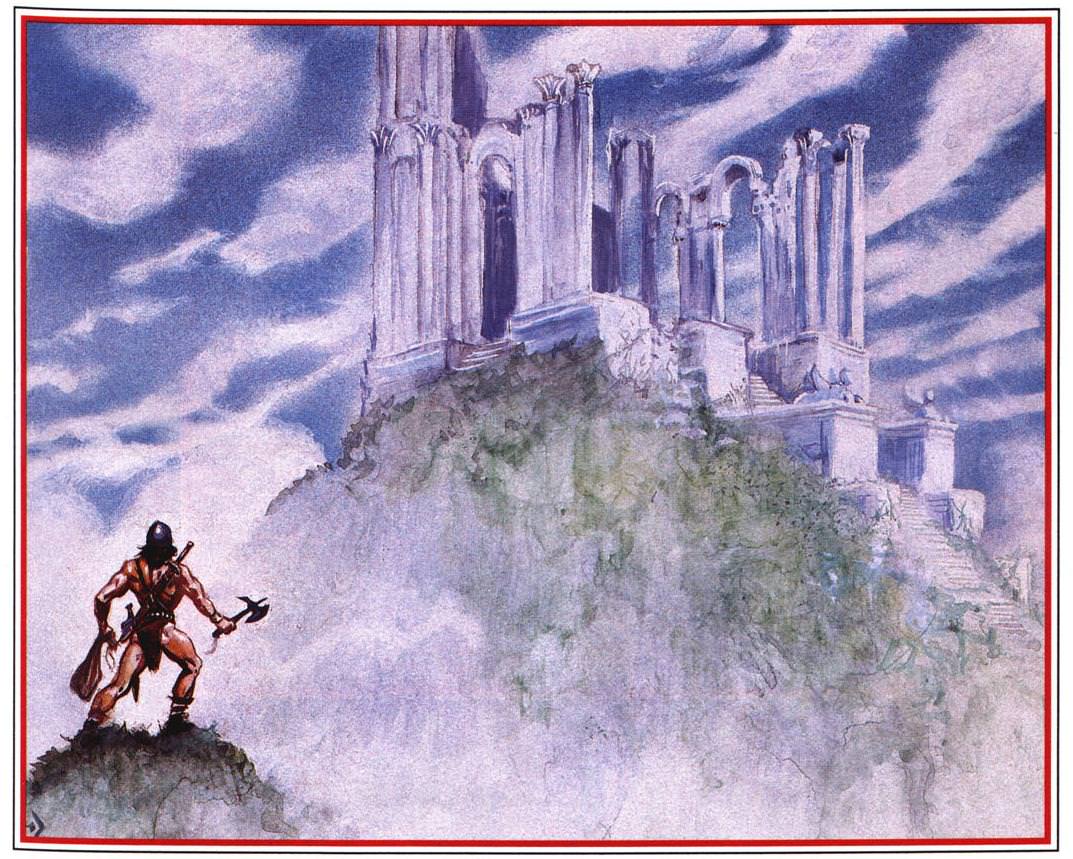
Did I mention this book is packed with fucking sweet art?
The Real Basics
Like most books, it's got a foreword(even in 1995 they were struggling to figure out what was actually core to D&D when making a new edition, if you can believe it), and then the usual "hey man, let's get you playing some games"-bit. It encourages people to just jump into the game with some experienced players and learn the ropes as they go along, and then describes, for the complete newcomer, what a roleplaying game is, and what the goal of one is.
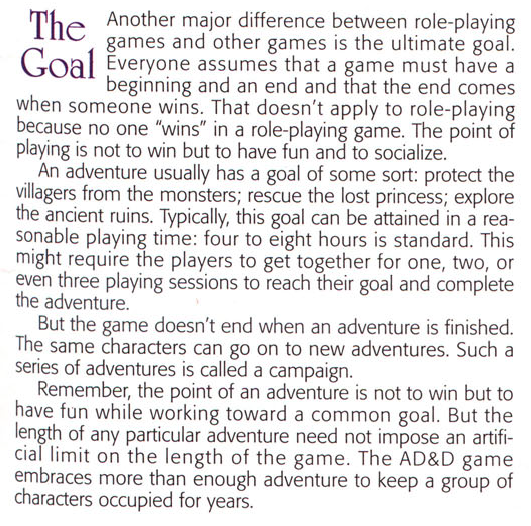
These images are from a scan of a book, so sometimes they'll be a bit slanted, my b
I think it's one of of the few, if not the only time, I can recall a game describing the purpose of the game as being fun. There's also an example of play which I'm not going to copypaste, except to say that it actually captures pretty well what a game is like(except that no one's playing a wizard, there's always someone playing a wizard, it's a constant).
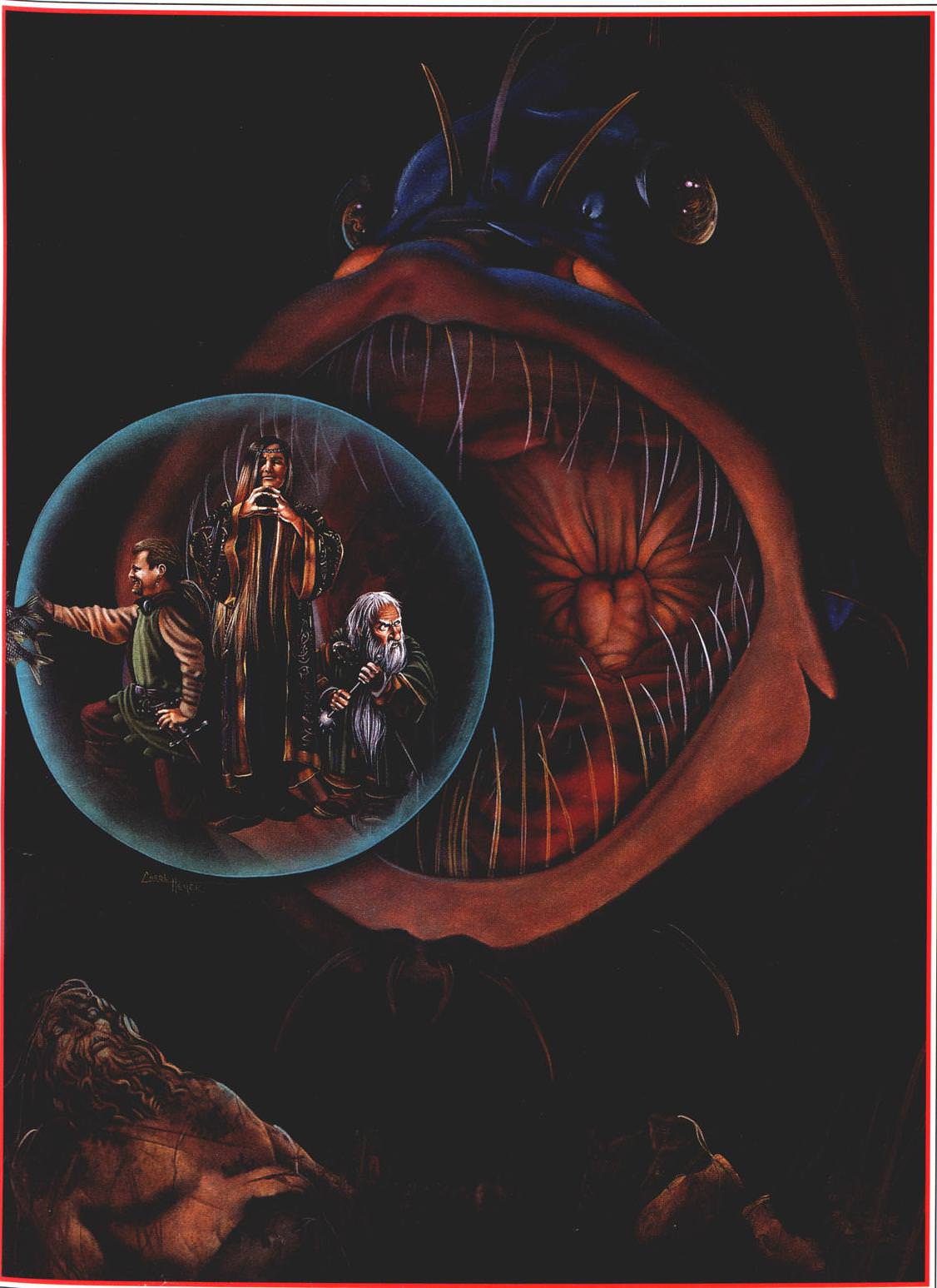
If you can believe it, quite a few of the art pieces in the book illustrate an adventurer about to have a very bad day
Chapter 1: Player Character Ability Scores
Ability scores are more or less the heart of any character, so for a book focused on creating adventurers, it's a natural starting point. We're given 3d6 down the line as the basic rolling method for generating stats(Method I), but it comes with commentary on what sort of characters it'll generate and then we're immediately given another five methods to use, II through VI. And already here, we've got what, to me, really feels like a major departure from at least the later games... the commentary. It's heavier in the DMG than in the PHB, since the DMG is really all about explaining the reasons for the decisions the devs made, and the consequences(both good and bad) of altering them in certain ways. But the fact that we're actually told, "oh, this method will generate these sorts of characters" and "that method will give you more powerful PC's," so on. It makes you feel like the designers were actually pretty aware of what they were making.
As for the stats themselves, there will be no surprises there for folks coming in from earlier editions, but compared to the later editions, there are some serious deviations. Not in what the stats are, it's still Strength, Dexterity, Constitution, Intelligence, Wisdom and Charisma. But rather in what the stats provide. Because from 8 to 14, most of the stats provide nothing. No advantages, no penalties such that you'd notice. It helps give a sense that the guy with 16 Strength isn't just 50% stronger than the guy with 14 Strength, getting a +3 instead of a +2. But that the 15-and-upwards crowd are notable, standing out and being able to do stuff that others can't easily accomplish.
It's also where we get some of the shit show that is 2nd ed's dark side. I mean... well...
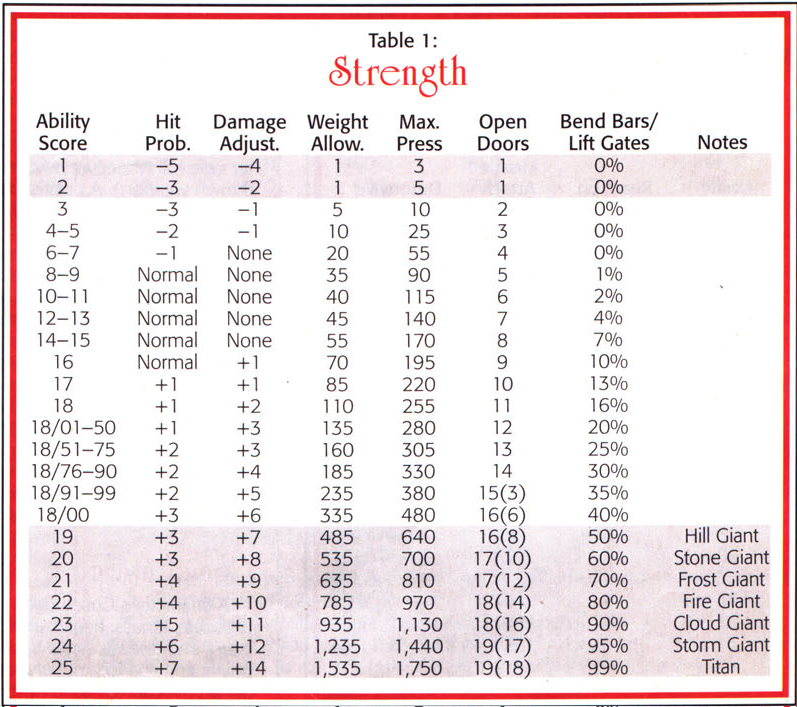
Strength is probably the worst example, but seriously. You've got both percentile dice and D20's involved in resolving things just for one stat. Even just for rolling it, if it's a Warrior(Fighter, Ranger or Paladin).
But aside from that, if you're not familiar with 2nd ed, but are familiar with the later eds, you might wonder: What's the big deal? A high Strength gets you +1's and +2's just like in the later editions, except that the game apparently doesn't expect your Strength to scale quite as far. And you've almost hit on the point, because the lack of scaling is the point. In the later editions, there's no upper scaling for anything, essentially. Not for stats, armor, saves, save DC's or attack bonuses, but 2nd ed uses an extremely bounded scale. 20 is the upper limit for Thac0, while AC essentially caps out around -10 in the most extreme of events(but more realistically probably around -5, and it'll almost never be quite that low).
This means that the +1 to hit that you'd laugh off as being the result of a garbage newbie trap feat in 3rd ed is fucking sweet in 2nd ed. Because of the bounded scale, it'll almost never be less than a straight +5% chance to hit. The bounded scales will have other, important consequences, but they're for later chapters. But suffice to say that the bounded scales are part of what'll always keep the early D&D editions above the later ones to me, because there's no room for any stat bloat or difficulty scaling to make your theoretical badass a practical wimplord. That +10 you ended up getting will never end up being pointless because the DC just scaled up another ten points, too.
Another thing that fell out of the rulebooks after 2nd ed is the Prime Statistic Bonus(tm). Basically, every class had one or more stats that were their Prime stats, Strength for a Fighter, Dexterity for a Rogue, Intelligence for a Mage and so on. If they had a 16 or better in that stat, they got a flat +10% to all XP gained. It didn't make an awful lot of sense, and if your stats were randomly rolled it kind of smacked of double-benefiting someone who might already be pulling well ahead because of a lucky roll of triple six or similar. It feels like one of those things that slipped through as nostalgic carry-over without really being considered.
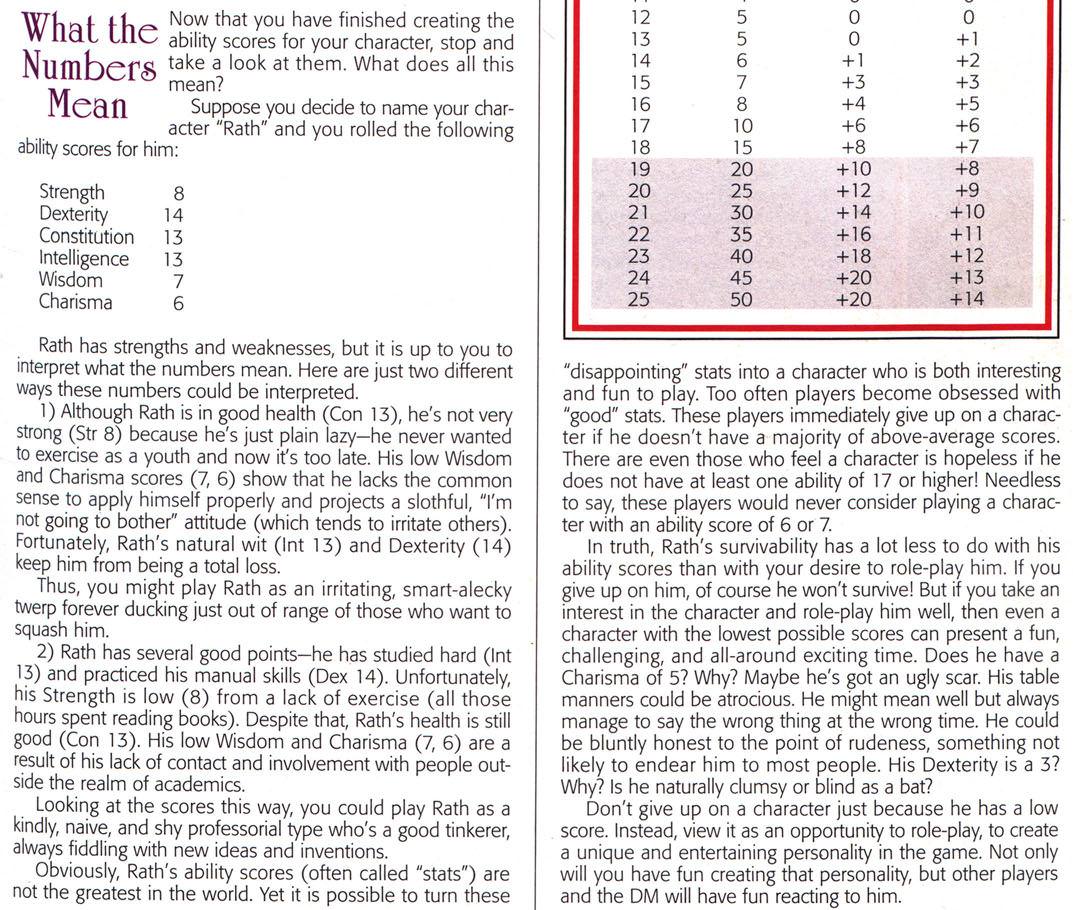
Analyzing Chapter 1: Player Character Ability Scores
Original SA post AD&D: 2nd Edition
It occurred to me that I spend an awful lot of time lauding the 2e AD&D DMG, and also that the DMG for its first ten or so chapters is more or less running commentary on the PHB. So why not do both at once? Do a chapter of the PHB, then the relevant chapter of the DMG(in the same post if at all possible). Let's try that out now.
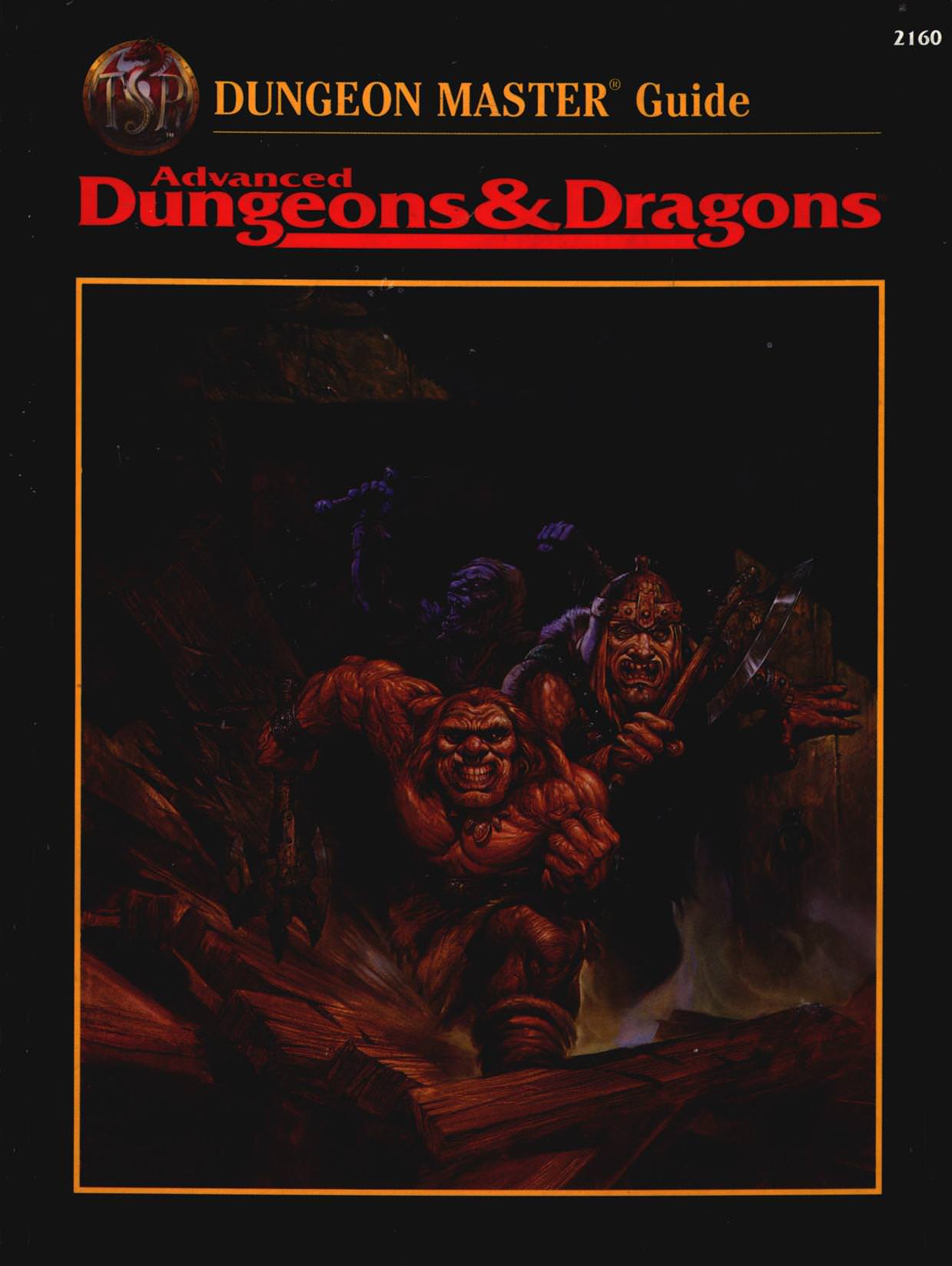
Analyzing Chapter 1: Player Character Ability Scores
Chapter 1 of the DMG is more than just an in-depth of the possible stat generation methods, though those are in there as well. It starts out by going over the potential stat generation methods we got in the PHB, describing their pros and cons. 3d6 down the line, for instance? Fast and simple, players don't need to do much planning or worrying, but getting bad rolls may discourage some players. The more complex methods(like 4d6-drop-lowest-and-arrange) are mostly described as being disadvantageous due to potentially hitting players with choice paralysis or:
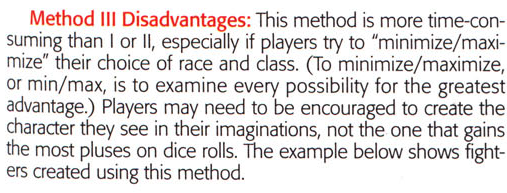
Simply the fact that people might start aiming for power when they have an opportunity to actively do so, rather than aiming for an interesting, possibly flawed, character. Other analyses get downright philosophical about the game itself:
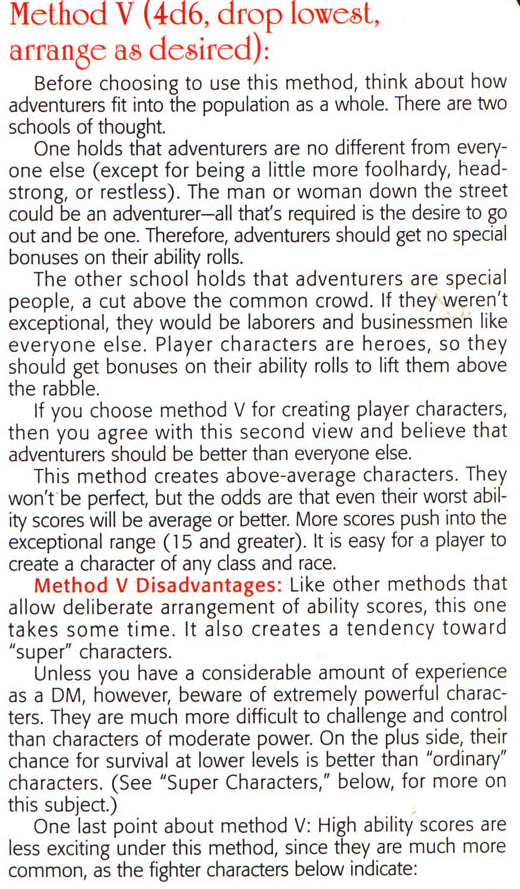
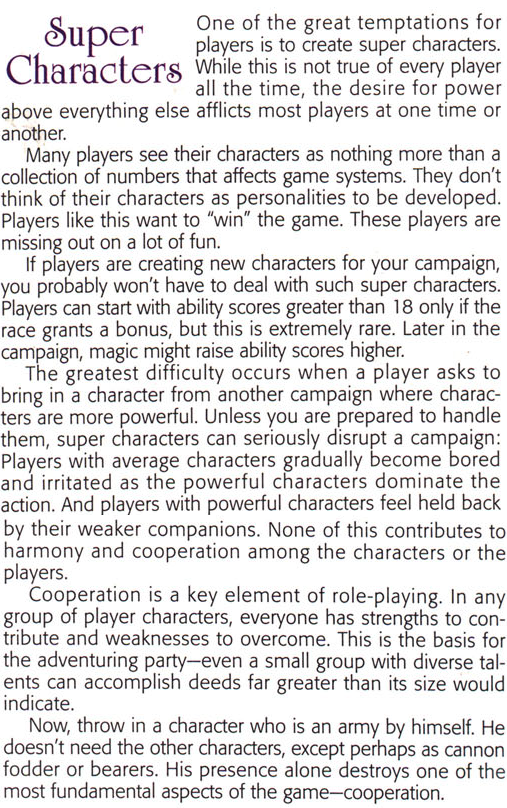
I just love the book so much for insights like this. It's probably stuff that a lot of us have internalized over the years, so to us it isn't particularly earthshattering, but we're roleplaying veterans. Imagine being a new player and getting hit with this bombshell? I don't remember any other game ever capturing the spirit of roleplaying, and the issues with it, this concisely and without being pretentious before. It feels like 2e AD&D's DMG is unique in that it actually understands the players, and predicts the irrational behavior that can sometimes break otherwise-rational systems. Like players reacting to the feeling that their character is hot garbage just because they didn't roll all bonus-granting stats or similar.
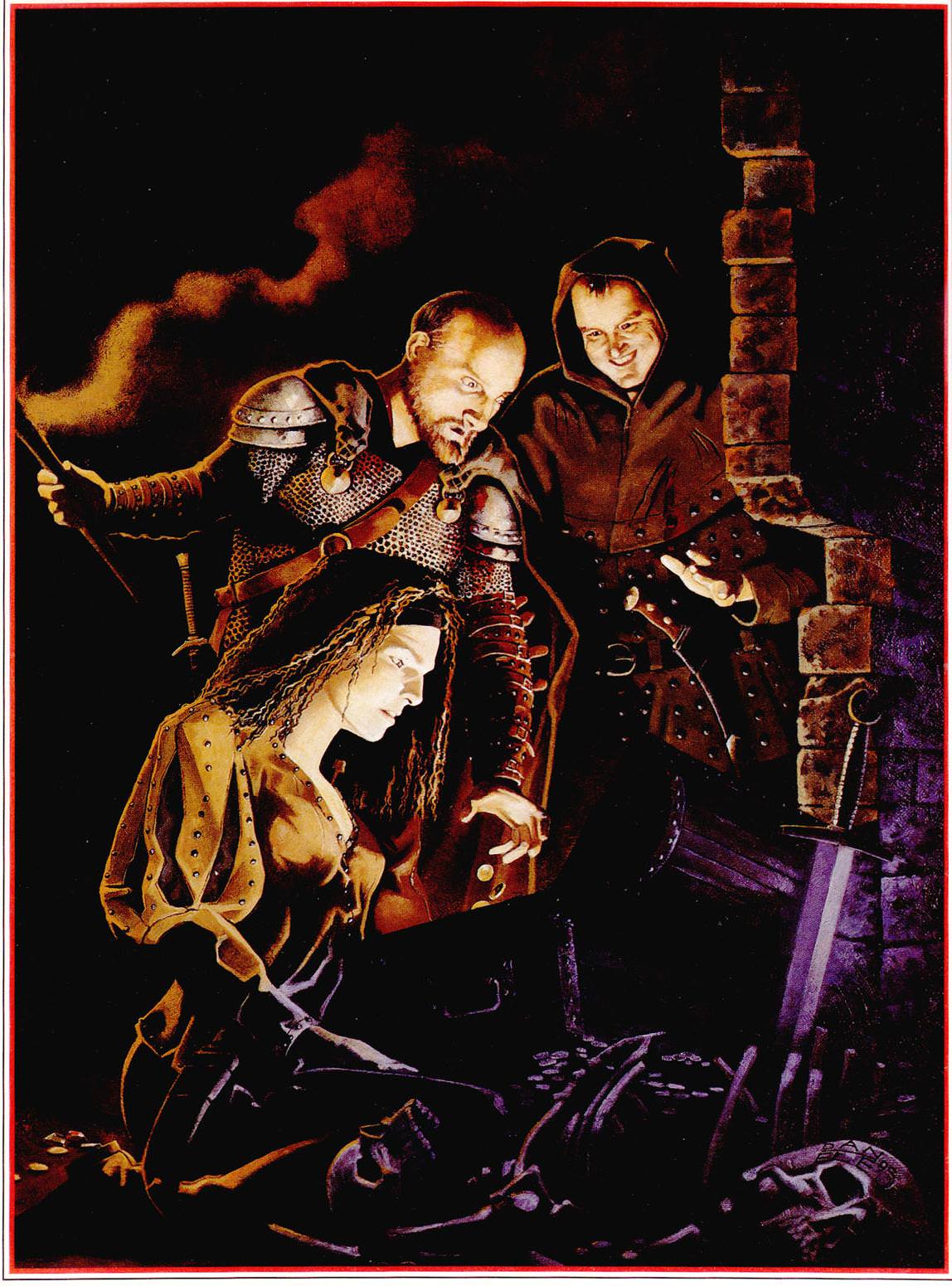
It also addresses a few things that I've never really had to deal with before, like players bringing in a PC from another campaign, which I can't imagine many GM's these days struggle with... but I can see the relevance in the sense of "my last so-and-so GM let me do X, why won't you let me do X?" and GM's still needing to take a stand against that sort of thing. Or the issues inherent in players running multiple characters in the same world/campaign("no, Joe the half-elf isn't going to loan Johnny the level 1 half-orc you just rolled up his +99 Vorpal Doom Avenger Blade. Or tell him the secret to the Riddle of the Level-Granting Sphinx. I don't care if they're both your characters. No dice.").
It also branches into some advice for GM's on how to help players come up with backgrounds(without forcing the GM's ideas on them) and how to deal with complicating backgrounds(the examples given are players who want to start as noble scions or as heirs to large fortunes). The suggestions are to either forbid it, if it'd ruin the game(like if Johnny Half-Orc starts with a million gold and just pays NPC's to adventure for him) or to play asshole genie with the players(though the game also suggests not to repeatedly do this or push it too far). Guy wants to be the son of a duke? Fine, he's got a noble title... but his dad was or is up to his ears in debt and the player's hounded by debt-collectors, so he might not want to mention his title too loudly.
Not much more to chapter 1 of the DMG, so let's get back to the PHB for Chapter 2.
Chapter 2: Player Character Races

I believe 2nd edition AD&D was the last edition of D&D to have demihuman minimum stat requirements, and I think it's one of the parts of the game that I've never experienced anyone actually using. No matter what other fiddly, minor rule someone's been insistent on making use of, no one's ever cared about someone playing an uncharismatic elf or a weak dwarf. Core AD&D eventually got expanded with a lot more playable races, just about every setting added two or three, in the same way that every goddamn book for 3e added two or three more classes, but at launch, it had a pretty limited complement: Human, Elf, Half-Elf, Dwarf, Gnome and Halfling. Three tall options and three short options, in other words.
I think this is also part of what makes the following editions feel so cluttered to 2e AD&D players. Extra race options were usually limited by game world(no playable Thri-Kreen frolicking around Cerilia, for instance, nor was Athas clogged with Aasimar and Tieflings), so you had a tight handful of racial options for the most part, and while a few settings modified the class options, it was, again, usually one or two local additions(which tended to also be combined with some universal options being limited or missing. Athas had Gladiators, but no Paladins. Cerilia had its half-thief spellcasters, but pure actual mages were extremely rare in turn, and so on).
Anyway. Dwarves, Gnomes, Elves and Halflings get stat modifiers(Elves and halflings are agile, dwarves are tough and gnomes are smart), while humans and half-elves get jack shit(for now, they have something to make up for it later), and everyone who isn't a human gets to see in the dark. One thing, again, that stands out here compared to the later editions is that every stat bonus is balanced by an equivalent stat malus. Elves get +1 Dex? Well, they also get -1 Con. Gnomes getting +1 Intelligence? Suck up a -1 Wisdom in return. At the risk of sounding like an old man complaining about kids these days, that also feels like a change in philosophy going onwards: As rarely as possible hand the players a drawbacks, instead focus entirely on giving them piles and piles of bonuses. From 3e onwards, players will basically never start with a stat on a level that gives a penalty unless they choose to, outside of a few extremely niche starting options.
Dwarves, Elves, Humans and Half-Elves we're probably all familiar with, Halflings get top billing in a few settings and gameworlds(WFRP, Middle-Earth, Athas and even Cerilia), but Gnomes are sort of the odd one out. They're less clearly based on anything Tolkien wrote(and, let's be frank, that's where most classic Fantasy gaming has its roots, flavour-wise) and thus have less of an obvious hook for most players. I can understand why they got phased out for a lot of worlds and settings. Reading their pitch, they mostly seem like a non-divine version of Tom Bombadil, living out in the woods and being able to learn the languages of badgers and other woodland creatures, as well as being somewhat fond of pranks.
Generally, though, mechanically, the races are kind of lackluster. They're all more or less humans except shorter/skinnier/fatter/more agile/longer-living. None of them really have any exceptional differences to them(mostly just some saving throw bonuses to some of the rarer saving throws you'll ever encounter. How often does some evil dude bust out a wand or rod?), though the +1 Dexterity for Halflings and Elves is somewhat broken compared to the other advantages, since a Dexterity upgrade yields a lot more advantage than a Constitution or Intelligence upgrade(Dwarves and Gnomes respectively) for most characters. Outside of some optional rules and stat checks, Intelligence is really only relevant to Arcane spellcasters(and even then primarily only for spell-learning), and +1 Con will at most produce +1 HP per level. Both of those can be good, but a +1 Dexterity can result in a +5% additional chance to dodge any attack(+1AC) and/or a +5% additional chance to land any ranged attack. Piddly small-change in the later editions, but huge in 2e.
After the races, the same chapter also dives into our character's "basics," that is to say: Age, Gender, Height and other stuff like handedness. It's generally described as entirely aesthetic, though a sufficiently advanced age can start accruing physical negatives and mental positives(oddly enough no amount of age will make us go senile). It's worth noting that all human adventurers with a randomly generated age start at between 16 and 19 years of age, meaning that all default human adventurers are literally teenagers and some of them have barely even finished getting all their permanent teeth.
Analyzing Chapter 2: Player Character Races

The DMG starts out strong by hitting on something here that the PHB has yet to hit on, but which I've hinted at: The advantage of humans and, to a lesser extent, half-elves. That would be racial level limits. Basically, only humans can reach any level in any class, while half-elves are for some reason unbounded as Bards. Most of the other core races have one or two classes where they can hit level 15 or 16, and the rest they barely reach level 10 in(for some later additions in other games, it can be even worse. Some of the Player's Option races have barely any classes they can actually advance in), not to mention that most races have a lot of classes(usually specialist classes, but sometimes something as basic as a thief, cleric or mage) which they can't even be.
Rather than just telling us this is how things are, the DMG decides to explain why it is as it is. Firstly, it's to give humans an advantage: Unlimited potential. Secondly, it's to give the races some flavour. Like the coolest, most badassest dwarves will be Fighters, elves excel as Rangers and Mages, halflings as Thieves, etc. And thirdly... it's to explain why humans, with their barely-100-years max lifespan are somehow the most populous and powerful race in most settings, rather than the elves and gnomes who easily rack up multiple centuries of training and experience if they don't die to violence or some other unnatural cause.

Personally, I've always adhered to the racial limitations on what classes can be played, but I've never actually tangled with the racial level limits, because dear God, who's actually run a campaign for that long? It's just never come up. But I appreciate the reasoning behind it. I'm one of those assholes who always wanted my setting to be internally consistent to the extent that if we applied the rules to everyone and everything, all the time, we'd come up with a sensible result. This is probably some sort of deep-seated psychosis and I should be locked up.
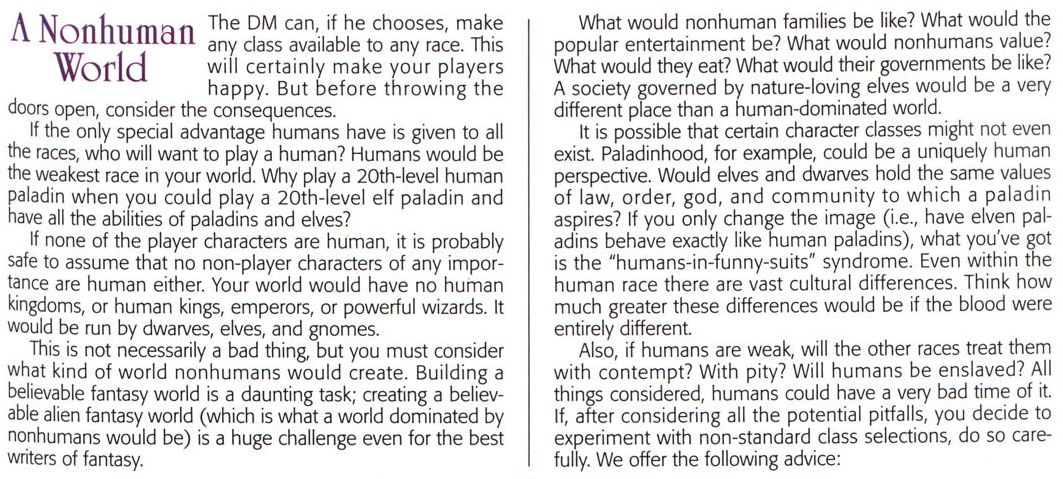
But as is usual for the DMG, the designers aren't happy to just lay down the law and demand we play their way. Instead, they argue for why they believe their way works... and then suggest what we could do if we don't want to work with it. They're giving us optional rules, mutators, for the game to let us tailor it to our liking, based on their game design experience. For instance, we could let demihumans advance to their max allowed level... and then simply double-cost them advancement for levels beyond that. Or only let demihumans with exceptional prime ability scores advance beyond their starting limitations. Or we could just scrap the limits and say "to hell with it, I'm running this game my way." and the developers don't try to shame us for it.
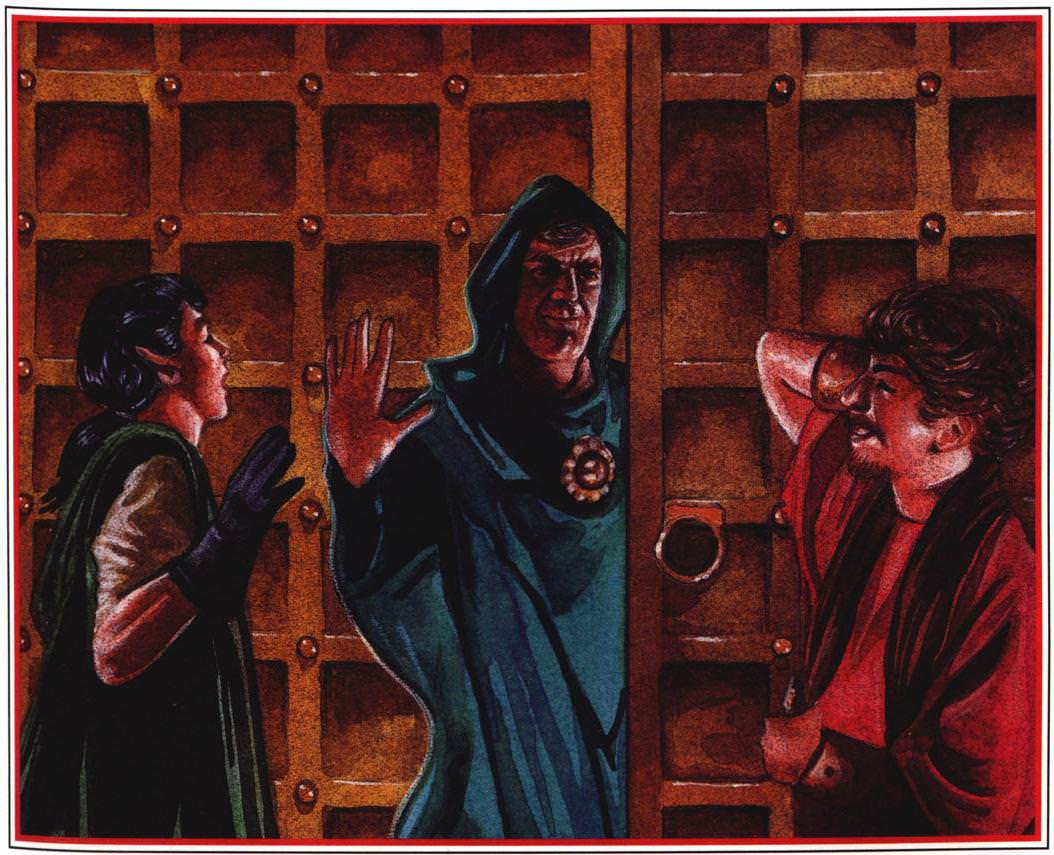
There's also a short section following this that I've literally never experienced anyone using: The create-your-own-playable-race section. It's basically a flowchart for determining whether a non-playable race would make sense, how you can determine why, for instance, Illithids or Wights would be poor choices, while letting someone play an Orc or a Centaur would be more workable. It can be summed up as: Do they have any exceptional abilities that would unbalance them? Can they play well with others(i.e. aren't required to eat other PC's for sustenance)? Can they adventure with the rest of the party(this is phrased as "do they have legs" and "can they move around on land and enter dungeons")? Followed by a few questions that we can use to establish what stat bonuses they should have(and what penalties) as well as what classes that it'd be appropriate for them to have access to.
In time (Player's Option) we'd get a more robust system for introducing new races to the game without having them previously statted out by a setting book, but that's some years off yet.
Next up: Classes and analysis of same.
Chapter 3: Player Character Classes
Original SA post AD&D: 2nd Edition
Chapter 3: Player Character Classes

Essentially, rolling up our abilities and selecting our race has been the prep-work for picking our class. Figuring out what our guy's good at doing, and then further narrowing the field by picking a race which may or may not qualify for parts of the selectable options. We're probably all familiar with the options ahead and broadly familiar with how they work based on how their later-editions incarnations function, but how they precisely function and interact isn't quite the same, nor is the starting selection.
For combat, we've got the Fighter, Ranger and Paladin. For priestly stuff we've got the Cleric and Druid(as well as an "Other," we'll get into that later). For wizardy stuff, we have the basic Mage and the Illusionist(and once more an Other). Rogues are represented by the Thief and the Bard. Notably, we're missing 3rd edition regulars Barbarian(instead of being a fully-fledged class, it's now a "kit" introduced in later supplements. In general, "kits" were stuffed into supplements where they wanted to offer minor variations to a class without completely rewriting it word for word with the addition "and he can do 1d4 damage with a fish wielded in his off-hand, but only on tuesdays under a waxing moon."), Monk(this game has unarmed combat for everyone but, uh, oh boy. It's a fuckin' ride that I have no idea how anyone thought was a good idea. No one spoil it for the people who haven't dealt with it before.) and Sorcerer(that might make Mages somewhat less hugely vulnerable and fragile).
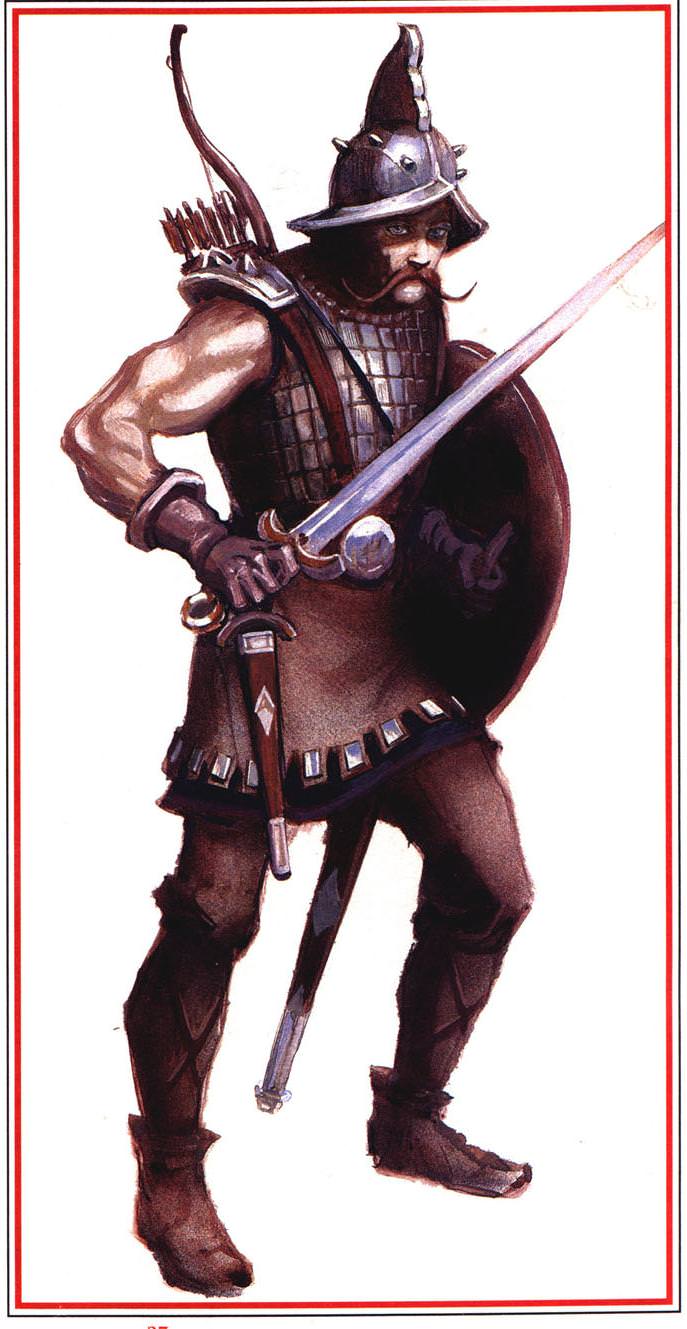
Clearly, 2e AD&D has the best "iconic" Fighter art
Fighter
Ability requirements: 9+Str
A laughing stock from 3e and a good while into the future, the 2e Fighter is a force to be seriously reckoned with, even compared to Paladins and Rangers. Fighters level up faster than Mages but slower than Clerics and Thieves(yes, this game has different XP progression tables for each class), have the potential to have 2.5 times the HP of a mage, without even counting that all warriors can get a higher HP bonus from Con than anyone else, if they roll well(and considering that HP progression stops at 9th level, becoming instead a generic +2 HP per level, the Mage will never progress to the Fighter's durability, even in the high-level ranges), upgrade their ability to hit stuff every level(all non-Warrior classes have to wait longer between Thac0 improvements), gain super-strength if they reach 18 Str(if a Fighter, Ranger or Paladin has 18 Str, they roll a percentile die for superstrength that can more than double their strength bonuses in a best-case scenario), is the only class that can Specialize in a weapon(giving them further early-game combat advantages in both damage and ability to hit, and a greater increase in rate of gaining attacks in the late game. Not even Rangers and Paladins get to specialize.) and, as the classic Fighter advantage, if he owns a decent property at 9th level(or thereafter) he attracts an elite troop of fighting dudes whose leader will even come with his own magic items and is about as strong as a PC in his own right.
Fighters can also use all weapons and armor, and unlike 3e, Dexterity bonuses to Armor Class aren't capped by wearing heavy armor. So a dexterous Fighter in heavy armor can be nearly impossible for physical attackers to land a blow on.
Fighters are not to be fucked with, and once we get to the Mage and poke a bit at how 2e spellcasting works, we'll learn why.
Paladin
Ability Requirements: 12+Str, 9+Constitution, 13+Wisdom, 17+Charisma. Must be Lawful Good.
Paladins are seriously rare in 2nd ed AD&D. You need to roll really awesome stats, and then, if you're using a roll method where you get to assign them as you want, you have to expend one of your best rolls on Charisma. Charisma's hardly useless if your GM actually rolls for NPC reactions, it adds some modifiers which distinctly increase the chance of NPC's either being friendly when approached peacefully or choosing to run away if approached threateningly. Like a Fighter, they can use all weapons and armor, improve their Thac0 every level, gain percentile Strength if they have an 18 Str and have the best HP die available. The Fighter advantages they don't get include Specialization(at high levels the +1 to hit isn't such a great loss, but the bonus to damage per hit if specialized in a melee weapon, as well as lost extra attacks can really matter), don't attract 9th-level followers and they level up more slowly.
In return, they can Detect Evil at will, gain a +2 to all Saving Throws(this is MASSIVE), can't be diseased, gain the ability to heal a decent amount of HP per day, can cure diseases, radiates an aura of Protection Against Evil(since a Paladin will probably largely fight Evil things, this translates into a more or less constant AC bonus unless enemies are hitting him with arrows from range), can turn Undead at higher levels, can cast Cleric spells at higher levels, can summon a his horse from any range and if he gets a Holy Sword he can just twirl it around to destroy hostile magic.
The cost for this, aside from tossing away what's probably your best roll... you have to tithe 10% of everything you loot to your church, your henchmen must be Lawful Good, and of course there's the Paladin Code. It's very vaguely termed. If you perform a Chaotic act, you gotta do penance for it. If you do an Evil act, boom, paladin status gone. You become a Fighter who doesn't have Specialization or 9th-level followers. Considering how vaguely it's termed, without some sort of agreement between the GM and Paladin player what constitutes an Evil or Chaotic act, it's not hard to see where the stories of GM's being out to ruin paladins comes from. Though the game does mention that it has to be done knowingly and willingly, so your GM can't make your Paladin fall because he thought he was contributing to an orphanage being built when the entire fund was in fact being embezzled to commit war crimes.
Ranger
Ability Requirements: 13+Strength, 13+Dexterity, 14+Constitution, 14+Wisdom. Must be some flavour of Good.
Rangers get the usual bevvy of Warrior abilities such as being hard to kill, being able to wield anything, wear anything and being good at hitting things. In addition, they get a mixture of Druid stuff abilities, a few Thief abilities and some abilities that are entirely their own. The thiefy abilities only work when not wearing heavy armor, though, making it somewhat of a trade-off whether you want to be stealthy or tanky.
Any Warrior or Rogue class can attempt to dual-wield, but without sufficient Dexterity they're piled on with penalties for doing so. Rangers have no penalty, no matter their Dexterity, which means that a low-Dexterity Ranger can add on a decent amount of killing power compared to a Fighter of equal level and Dexterity. They also get a massive +4 bonus to hit against a chosen type of enemy(orcs, ghouls, etc.). Interestingly enough, Rangers also gain followers, but without the need to build a fortress, and only at 10th level. These 2d6 followers can be anything from a pack of dogs to Treants or even non-Evil lycanthropes. Having a Werebear posse would be pretty goddamn hardcore. Hilariously, the Ranger doesn't get any special ability to communicate with the weirder potential followers, so he may just end up with a dozen Hippogriffs staring mutely at him every night around the campfire while he wonders if this is the night where they decide to turn him into lunch.
Rangers, like Paladins, come with a prohibition against doing Evil stuff, at the cost of their powers of being able to hang out with Bears.
Mage
Ability Requirements: 9+Intelligence.
So, Mages. You know them, you love or hate them, and you expect them to kick ass and chew bubblegum that they summoned from the astral plane. This is considerably less likely to happen in 2e than in 3e, for a number of reasons.
Firstly, Wizards of any flavour get absolutely rock-bottom HP, their Thac0 almost never improves, they can't wear any armor and they have the chumpiest weapon selection of the entire lot. On the bright side, they do have their magic, eventually. They start off with one level 1 spell per day, and unlike Clerics who get bonus spells/day for high Wisdom, Wizards do not get bonus spells/day for high Intelligence(I always houserule that the same table applies to Mages, just so they aren't total dead weight). Secondly, their spells aren't quite the threats they are in 3e. For one thing, any damage taken, ANY damage taken, in the round before the spell fires off means it fizzles and does nothing. This means that a couple of Fighters with fast weapons can repeatedly shove a Mage in a locker until all his spells are fizzles. And then there's how Saving Throws work...
In 3e D&D, a saving Throw is the caster using his stats to impose a DC, with the victim then rolling 1d20+his save to match or beat it, or he's turned into a radish. In 2e AD&D, instead it's a simple roll-over the target's Saving Throw for him to shake off the spell or only suffer half damage or whatever a save amounts to. Only very rarely is the save penalized in any way. This means that high-level characters and monsters are more or less completely immune to anything targeted directly at them. Additionally, there's Magic Resistance, which quite a few high-tier enemies have. 3e had its Spell Resistance, a mechanic that I never quite understood how worked, but everyone assured me it was laughable and thoroughly useless. In 2e, Magic Resistance is no such thing. It's a straight percentile chance to completely ignore an enemy spell. Even if a passed save would normally permit for some sort of partial effect, a successful Magic Resistance check completely negates it, and even if the MR fails, the normal Saving Throw is still rolled afterwards.
So Mages are somewhat less useful in a straight-up fight against the enemy than they are carefully ensconced on the back rows buffing the party's beefier members into being horrifying blenders, modifying the battlefield without directly targeting anyone or using their spells for various out-of-combat utility purposes.
Illusionist/Other
Slightly less useless are specialist wizards(the Others would be the ones that aren't Illusionists). These all have a non-Intelligence stat that they require 15+ or 16+ in, though. In exchange, you pick one school of magic where enemy saving throws are penalized, spells are learned faster and more easily, get a free spell pick from it on level-up to a new spell tier and they have one more spell per day from each spell level that they have access to, which is pretty huge when you just get access to a new level and only have one per day. Even late-game, it's notable, since a given spell-level will cap out at 9 spells per day, so it'll still represent a +10% boost at worst. Oh and then there are the two spell schools you lose access to entirely(Diviners only lose access to Conjuration, and Illusionists lose access to three schools of magic).
Cleric
Ability Requirements: 9+Wisdom
Clerics are awesome, mostly because they feel kind of like a debug mode someone accidentally left in the game. They can wear all armor, wield all blunt weapons, are second only to the Warrior classes in knowing how to bash faces in, automatically knows all spells appropriate to his level(except for a few restricted to Druids), has a vague religion that he doesn't actually need to flesh out, can turn undead, gets more spells per level than a Mage of equivalent level if he has a high Wisdom and once he reaches 9th level, his faith handles half the cost of any fortress he decides to build since it's considered a bastion of the faith.
Now, this is clearly not the class you're meant to play, if you read onwards. The GM is meant to make actual specialist clerics, like Specialist mages, with more limited access to the various spell spheres, customized weapon restrictions(for instance, a Cleric of the Sea Dude might be allowed to wield tridents or some such as a holy weapon) and unique powers(turn undead is really only a placeholder example. Clerics are meant to have thematically appropriate ones for their religion instead). Oh and, of course, they're meant to actually have some sort of religious faith they're meant to follow, uphold and spread.
Druids, for example, despite being stuffed into every setting I've ever seen, are clearly described as an example of a specialist Cleric.
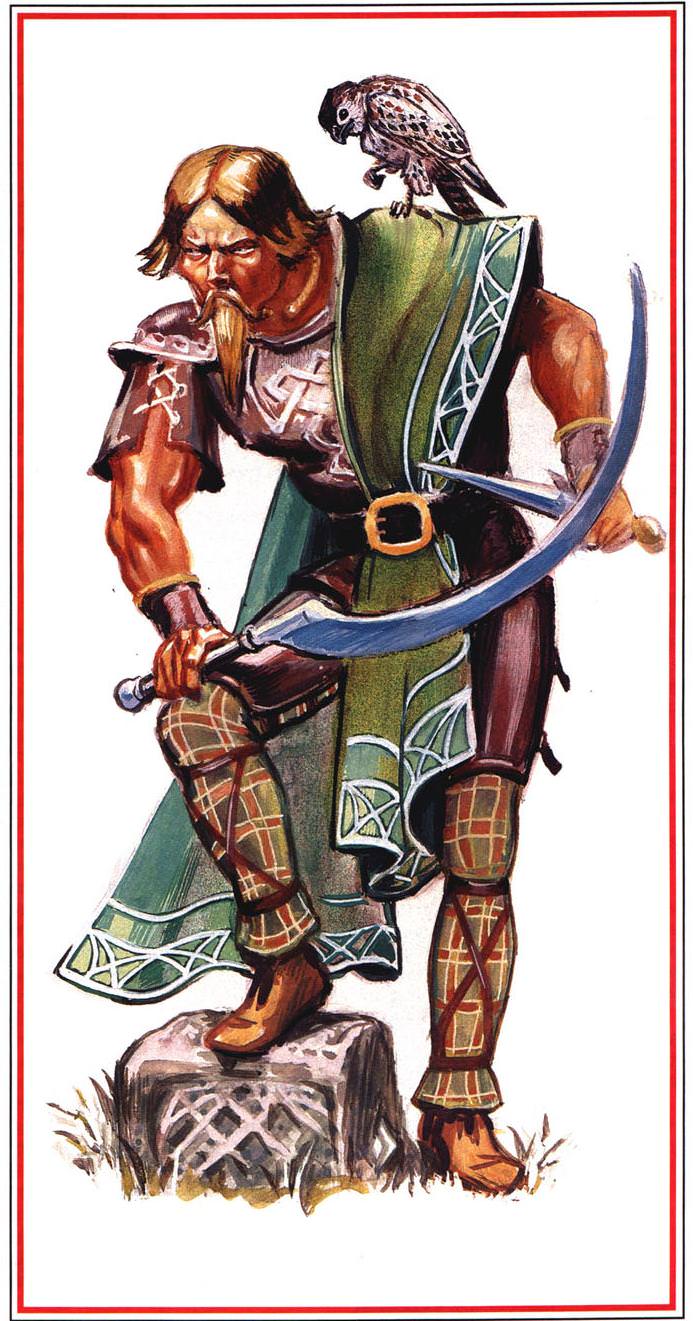
Best get off my lawn, you little assholes
Druid
Ability Requirements: 12+Wisdom, 15+Charisma
Druids are weird. They can wear any armor not made from metal, but their weapon selection is basically the Mage's terrible one with Scimitar and Spear shoved in there. They get access to some of the most commonly used Priest spheres(like Healing) and some ones that are almost never used(Weather?) in exchange for this, and also they're afraid of books and will never read magic books. They get secret druid speak, can look at nymph tiddies without having their brains implode/being charmed, can ID plants perfectly, never leave tracks in the dense woods, learns special woodland creature languages, can shapeshift into natural creatures a few times a day(none of the super-broken shit from 3e, sadly, but 2e bears are significantly scarier, so there's that. Aside from the AC, a Polar Bear is the equivalent of a high-level ranger with an even higher damage output barring magic weapons).
His main limitation is that at 12th level or above he enters a magical Fight Club where he needs to chump on another druid of equal level in a ritual duel to be allowed to level up. At 16th level, you're at the top of the Fight Club, and you can finally move on from it. At this level you're described as being stuck in an extremely dull hell of Druid politics, and your main goal is to gather another half million XP so you can continue advancing, and then hand on your role to some other unlucky chump so the rules will actually let you advance.
Seriously, this class is so weird. Parts of it make great sense and other parts are just whacko.
Rogue
Ability Requirements: 9+Dexterity
Being able to wear up to leather armor, wield short bows and carry long swords, Rogues are actually reasonably capable of holding their own in a fight. Though since they'll probably have pretty solid Dex, they're best suited to bringing out their shortbows and providing fire support assuming they can't backstab some unlucky asshole(2e backstabs are multipliers to the damage done, rather than their own roll of damage dice. It's also entirely possible for a thief to sneak in combat and backstab someone that the Fighter's keeping tied up, and attacking from behind and by surprise will do a lot to outweigh the Rogue's poor Thac0). Their Thac0 is mediocre and their hit die is the second-worst. Aside from that, the Rogue gets access to some pretty useful utility options that no one else does. Anyone can try to hide somewhere, or to move silently, but they'll never be as good as a Thief is. Thieves are also the only class that can deal with traps and locks without brute-forcing them and potentially getting someone killed or getting awesome valuables lost. They're also another of the classes that can recruit cool buddies at high level, in their case of course the followers once they establish a den of ill repute will be Thieves of various flavours.
Thief abilities in 2e AD&D also don't rely on a roll-vs-DC model like in 3e, and are instead just straight percentile rolls. If you roll under your score? You do it. Fuck that trap. You owned it. Only Open Locks really has room for the GM to crank up the difficulty of the roll some, as-written.
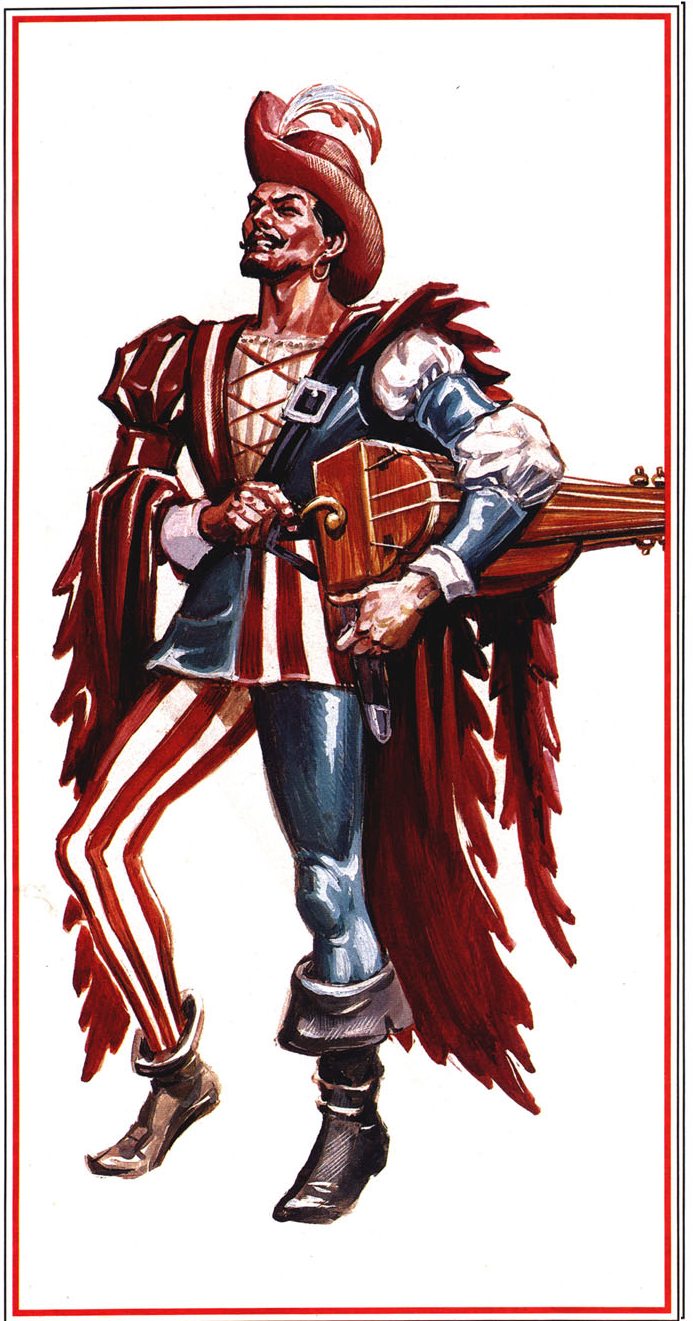
Bard
Ability Requirements: 12+Dexterity, 13+Intelligence, 15+Charisma
Bards are an odd class, though not quite as weird as the goddamn Druid. They come able to use any armor up to chain mail, and any weapon, which makes them decent combatants though they're still stuck with the poor Thief Thac0 and hit dice to hold them back. Additionally, their mage abilities require no armor being worn, and their thief abilities require no heavy armor(chain mail) being worn. They get a handful of Thief skills(mostly the less useful ones) and basically cast spells like a Mage, though they're limited to never getting above 6th-level spells and advance in spellcasting slower than mages do. But if you're not aiming for the top-tier ultra-epic levels, and you want to be a wizard who can do shit when his spells-per-day Vancian allowance is spent, you could do considerably worse than to play a Bard.
The unique ability Bards have is their ability to shift others around on the reaction tables, either towards the friendly or hostile end of the spectrum, using rhetoric, jokes, music, anecdotes, whatever's available. Likewise, the Bard can also buff his allies. It's a small buff, but considering that it can be used once per fight at no real cost, there's no reason not to use it. And early in the game, it can be very useful for making non-primary combatants, like thieves and clerics, catch up with warriors in terms of being able to actually hit the enemy and do damage.
They can also provide loud music to counter any sort of mind control or suggestion spells that rely on verbally giving orders to the victim. He also gets to construct a stronghold and attract fighty followers at 9th level, because why not, that makes perfect sense for a musician with a giant sword.
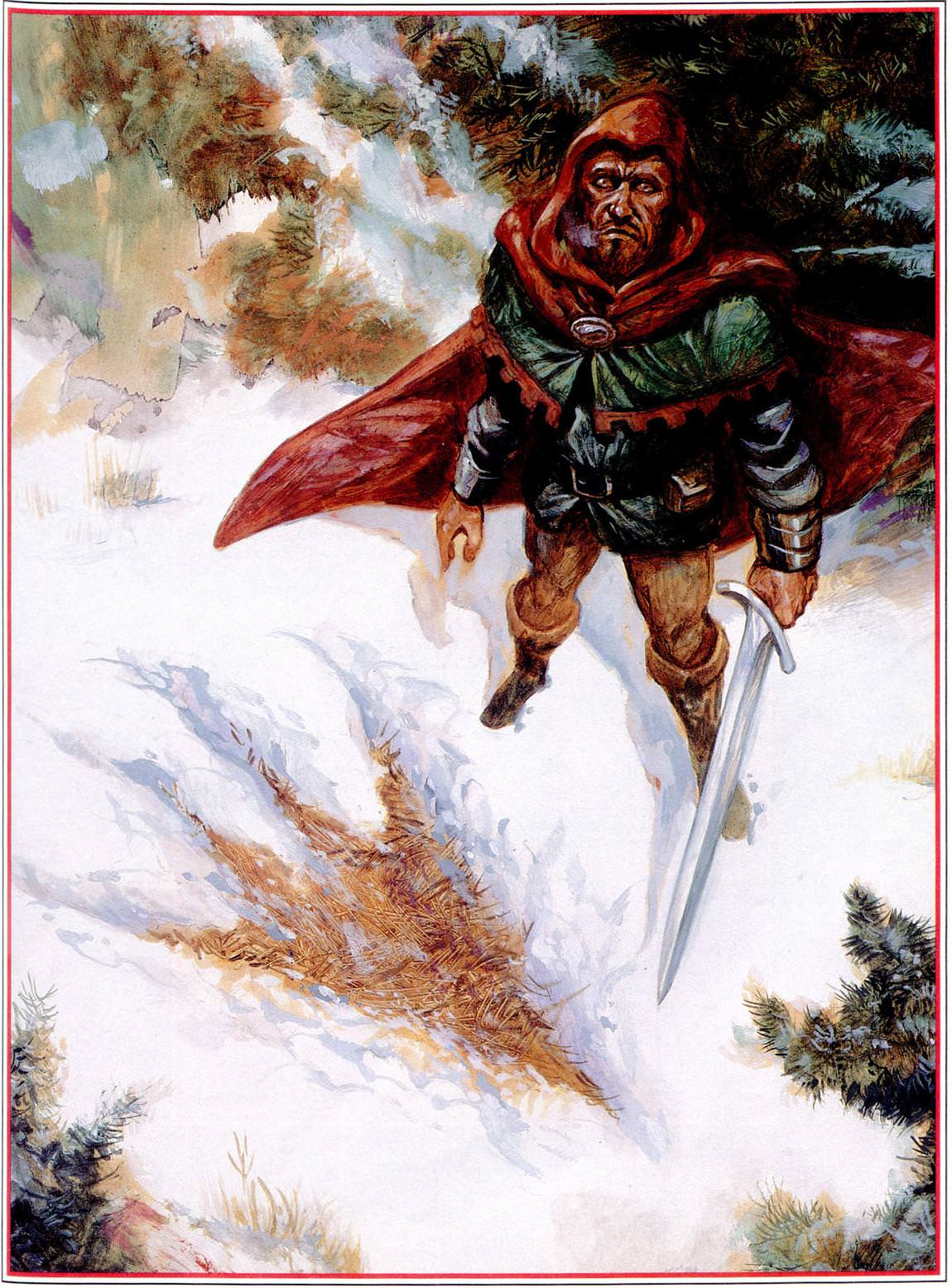
Multi-Classing and Dual-Classing
So personally, I always felt that multi-classing worked better in 2e than in following systems, and that dual-classing was a huge pile of garbage.
Multi-classing in 2nd edition is something only demihumans can do, they combine two or three of the classes they have access to(the exact options they have vary per race), and advance in all two or three of them at the same time, splitting their experience points between them equally. With XP costs generally doubling per level, this means that a two-class multi-class character will usually be one level behind his single-class compatriots in most cases. Generally, the best attributes of either class are brought along when they're training-based(for instance, a Fighter's ability to use all weapons and armor would trump a Mage's ability to use none), but the worst is used when it's ideological(a Cleric's religious weapon limitations would trump a Fighter's training). Best Thac0 is used, and HP is rolled for all the classes but the results are divided by the number of classes involved in the multi-class combo, so it ends up as sort of an average result. A Fighter/Mage still won't be able to cast spells in armor, but could, for instance, bring a bow and be useful at range even when all his spells were spent. A Cleric/Mage would have remarkable spell variety and be a lot less squishy than a Mage. Thief/Mages can back up their thief abilities with spells to make them even better at infiltration and problem-solving. Fighter/Clerics gain spells faster than a Paladin, but level slower than a Paladin or a Fighter and lose some of their weapon variety.
There are a lot of options, and most of them are good!
Unlike dual-classing. Dual-classing isn't good. It's stupid. It's what humans get instead of multi-classing(another flaw, I feel like it should've been the other way around. Let humans multi-class).
Basically, when dual-classing, you advance as normal as a class until you decide to start advancing as another. You are now permanently locked to the level you reached as the first class, that class will never advance again. You keep all HP from the first class, but otherwise everything is as according to your new class(you can still use stuff from your old class in a pinch, but that means a huge XP penalty), until your new class is a higher level than your first class, then all that original knowledge suddenly comes flooding back in. I have a hard time thinking of any cases where a dual-class is actually good in any way, and not spicy garbage. It's a lot more like 3e multi-classing except it's somehow more shit.
Because this post ran super long, analysis will be for the next post.
Analyzing Chapter 3: Character Classes
Original SA post AD&D: 2nd Edition
Analyzing Chapter 3: Character Classes

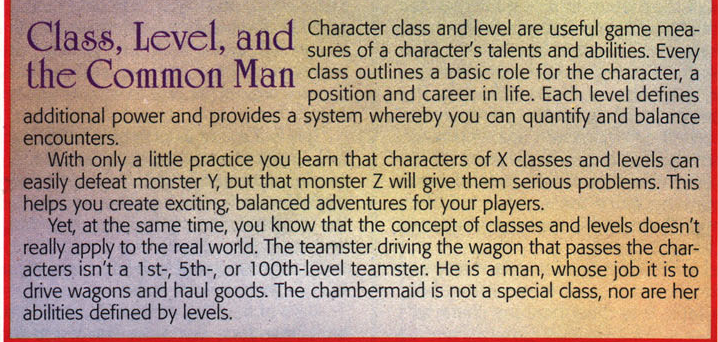
The third chapter of the DMG mirrors the third chapter of the PHB, in that they're both about character classes. Where the PHB is about the mechanics of player character classes, however, the DMG is more about how classes actually fit into the game world, starting off by pointing out that the vast majority of the world's NPC's are un-classed, 0th-level normal dudes and dudettes. They don't have PC classes, and they don't have their own special classes. They might be proficient with a single weapon relevant to their profession(the pikeman knows how to use his pike, the smith might know how to use his hammer, etc.) and probably have some non-weapon proficiencies relevant to their skills(all that time not spent dungeoneering means they can actually learn useful life skills like blacksmithing, herbalism, etc.). Generally they'll have a single hit die's worth of HP and get dropped by a single sword blow or if they get kicked by a horse(probably, though, the game notes, it might be a good idea to give especially important NPC's a bit of extra health so they don't die accidentally... or intentionally if a PC really wants to sabotage the campaign).
Then it moves on to the specific character classes, because if most people aren't classed, who is? And how many are? It goes over the classes in turn, analyzing who might reasonably have character levels(those who might have Fighter levels, for instance, would be hardened mercenaries, members of elite regiments or perhaps some excellent NCO's and officers.). Classes with high basic ability requirements are obviously the rarest, especially as they also tend to come with ethos requirements that further narrow the pool and potentially cause some to drop out. It also points out how classes fit into society, for instance, while the majority of a religion's clergy will likely be 0th-level theologists, the Clerics and Paladins are the ones who actively go crusading for the faith or defend vital holy sites.
The repeated mantra here tends to be that just because someone has a high rank politically, they don't need to have a high rank level-wise. The leader of a thieves' guild could as easily be a 0th-level merchant as a high-level assassin, that sort of thing.
After this, it segues into an early exploration of just what you do with high-level campaigns, pointing out that after a while, just chopping things up is likely going to start getting dull, especially once the players have such stats that they need ridiculous enemies like dragons or demigods to challenge them. Thus a suggestion of slowly twisting the campaign away from throwing numbers at enemies, and towards political maneuvering and intrigue, especially once players hit their Name Level(9th or 10th depending on class) and start accruing followers of some sort. And, eventually, that once players hit or approach 20th level, it may be time to retire them as powerful background NPC's and start over with some fresh characters.
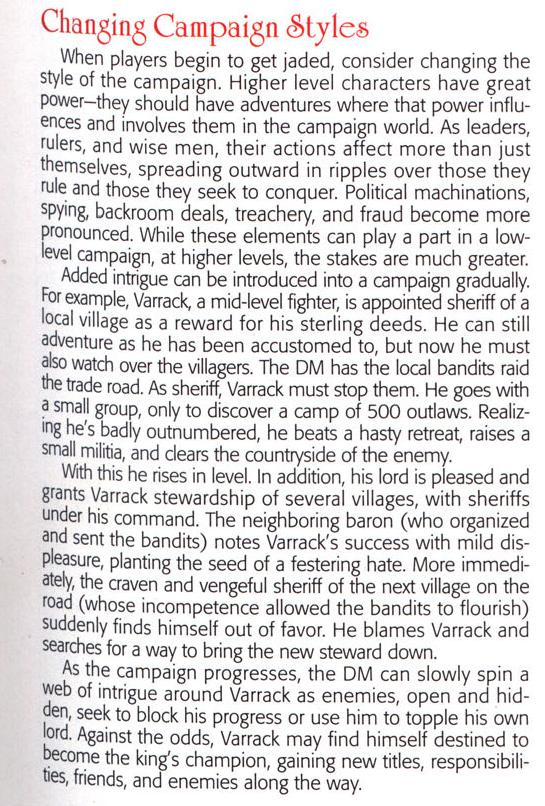
And then what do you do when you create fresh characters? Usually, the game suggests, you start them at level 1, because those are the "formative" period for character personality, but of course, if the rest of the party is higher level, start the character at the same level as the lowest-level party member, so they aren't totally useless.
Mostly this chapter is, therefore, about worldbuilding. The only solid mechanical part of it is at the very end where it has a short section on creating new classes. First it advises against making a new class for everything, i.e. a Vampire Hunter or a Viking are just Fighters with a certain philosophy, a Witch is just a female Mage, etc. etc. but then gives us a rough system for making our own classes. Basically we cobble together elements of all the existing classes, and then use those to come up with an XP multiplier for the class. The more abilities, the slower it levels, essentially, and if we rebuilt an existing class perfectly, it would advance slower than the existing version.
Oddly enough, despite things being more systematic, and thus making it easier to do so, I don't recall anything like that from the later editions. Or, at least, not anything that I ever saw anyone use. 3E had a "making new classes"-bit in the DMG, sure, but it was just "eh, you can make a new class. here's a thing you could make, theoretically. [example follows]" with no sorts of guidelines on how to actually make a new class or really balance it.
Chapter 4: Alignment
Now, alignment... I know that's a thing a lot of people hate about D&D in general. And while I don't mind alignment, and find it to be a useful guideline, it could have been better explained.
For those not familiar with classic D&D alignment, you've got two axes: Good-Evil and Law-Chaos. Good-Evil really just represents selflessness vs selfishness(the game characterizes most evil characters as not being actively malicious, but simply not caring if the actions that benefit them are detrimental to others) and is easy enough to understand, while Law-Chaos is most easily summarized as collective vs individual. Law wants to put everything into an organized system and move everyone at once, Chaos tends to regard organization as irrelevant or pointless(possibly even actively hazardous) and prefers individual action. When faced with Evil actions that are legal through a loophole, the Lawful Good character runs for government or lobbies the existing government to change the law. The Chaotic Good character, meanwhile, is more likely to don a mask and go on a vigilante crusade against those exploiting the loophole.
The alignments that D&D has always struggled with more are the ones that mix in Neutrality. Not so much Neutral Good or Neutral Evil, which are just Nice vs Naughty without any additional flavouring. But Lawful Neutral, Chaotic Neutral and True Neutral have always been the ones that have caused the most problems, from least to most goofy. Lawful Neutral you can somewhat easily define as the bureaucrat who follows the rules because they exist, not because they benefit him or anyone else. Someone who needs to have a system or a rulebook for everything, and who might try to make it more concise and precise, but would never really question whether the rules are needed or need changing so they provide a different outcome.
True Neutral(in some cases just Neutral), covers a wide variety of bases. It covers the people who legitimately just don't give a fuck, or creatures without the intellect for morality(animals, plants, golems, etc.), as well as one of the silliest concepts of all, that being ferocious balance nerds who switch sides at the drop of a hat to obsessively maintain some sort of status quo of the universe. The worst thing this fucking alignment ever gave us was the Rilmani, a group of Outsiders strictly devoted to setting stasis by allowing no changes to happen if they can help it. Fuck True Neutral.
Chaotic Neutral tends to give us fishmalks, lolsorandumb sporks of dooooooooom penguins!!!!! XD types and the like, because the alignment is literally described as often being the alignment of madmen and lunatics. 90% of the time if someone picks to play CN, it's because they want to be able to do whatever whim takes them, without giving a shit about whether it's logically consistent for their character. And sadly the alignment descriptor also backs that up, defining them as going with whatever whim grabs them at the moment.
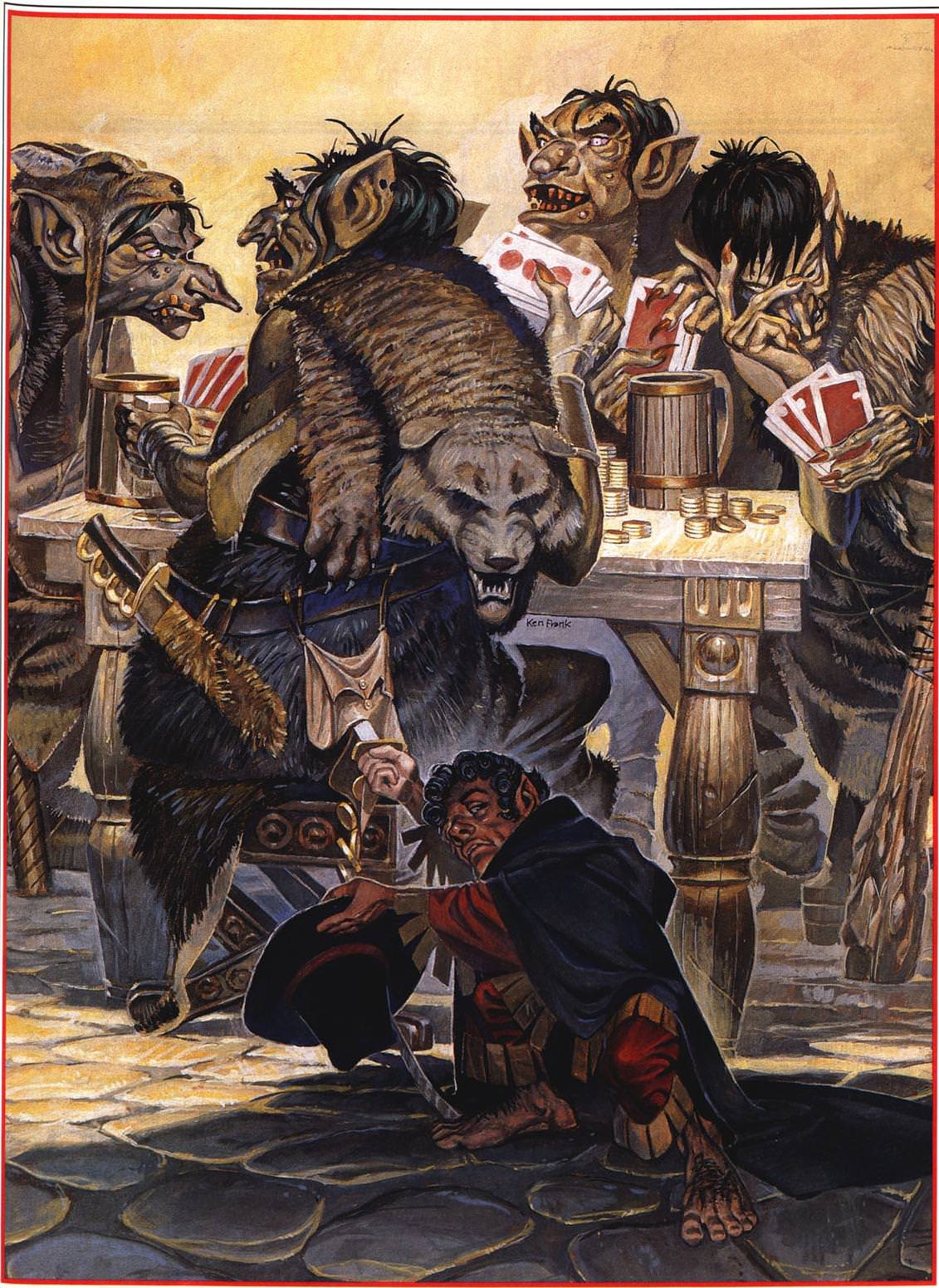
After the explanation of what the alignments are, we're told that it's a good idea not to make a group with too diverse alignments, and then thrown into an example of what a mess that is... with a theoretical group consisting of one player of each alignment. Both how they'd act while splitting the loot and during the fight. It's a good example of how too-divergent alignments can end up in a brawl, but it's not really a particularly good guide for actually playing a given alignment.
Analyzing Chapter 4: Alignment

The DMG approaches alignment from the opposite side of the PHB. Where the PHB is "this is how you play these alignments," the DMG is more about how alignments affect NPC societies/governments(but as a regular 2e GM I can't remember ever actually going: "THIS CITY IS NEUTRAL EVIL" and advancing from there. I'm not sure if anyone ever has, usually regions don't have alignments, people do. They do have an example for every sort of governmental/societal alignment available, though.) and how to deal with player alignment disputes. I like how the first suggestion there is the simple. "You guys have picked alignments that will be fighting like cats and dogs, how about one of you change it up so we don't have this mess?" You know, just talk to your players like rational adults.
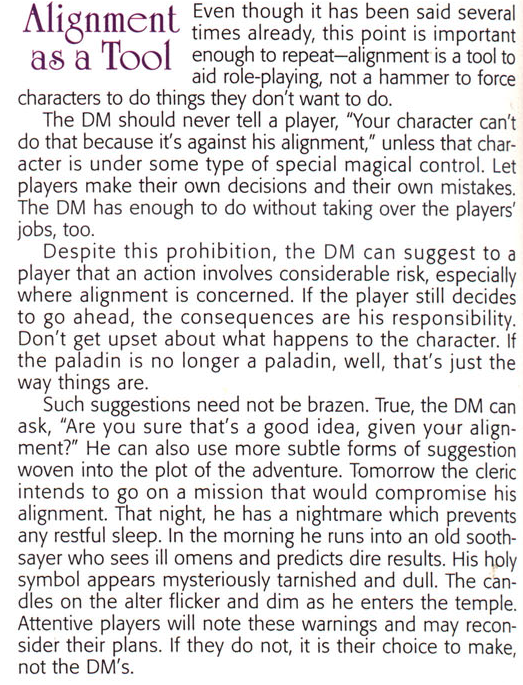
Almost everything that's important to know about alignments has already been said in the PHB, and the DMG here is mostly there to deal with the edge cases that are largely important to DM's and less so to players. For instance, what happens when a magical item forces a new alignment on a player? How effective/precise are Detect [Alignment] spells? How does player alignment change in general? Suggestions for using alignment in a more "classic" way where the entire world is locked in a grand Law vs Chaos or Good vs Evil struggle, rather than many smaller, grayer groups having their own fights, etc.
But, really, what happens when you change alignment? The GM is encouraged to handle it differently depending on the circumstances. For instance, if Joe discovers that he's not having much fun playing a Lawful Good character, and would fit better into the party as Chaotic Good or Lawful Neutral, the GM's encouraged to just go: "Sure thing buddy, erase the old one, write in the new one, and let's get the game on the road." On the other hand, if it's more that the player insists on, say, having his Lawful Good character waterboard everyone he comes across for gossip and secret information, and the GM decides that's enough to flip him over to Lawful Netural after the 20th time, the penalty is twice the XP needed to reach the next level.
I'm not sure I really agree with penalizing players for changing alignment, but if you're going to have alignment in the game, it should have some meaning. Though I feel like I'd rather have rewards/benefits for following your alignment well than penalties for breaching its strictures and philosophy. Carrots usually work better than sticks, after all.
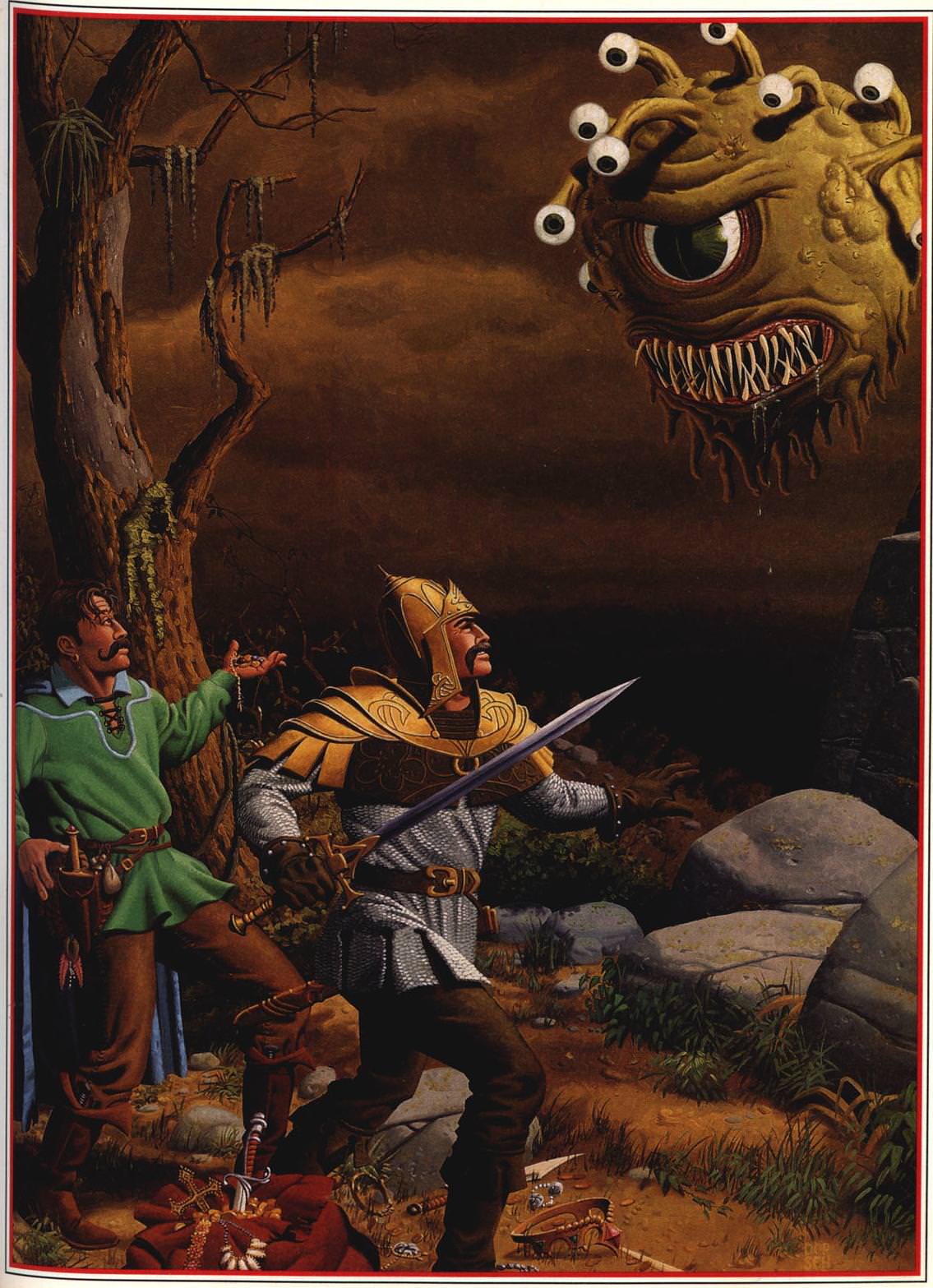
Chapter 5: Proficiencies
Original SA post AD&D: 2nd Edition
Chapter 5: Proficiencies

In 2e, Proficiencies, i.e. combat and non-combat skills other than those baked into your class, are entirely optional, which honestly feels like a bit of a shame, because in basic 2e AD&D, outside of stat rolls and equipment, they're basically the only way to really differentiate two characters of the same race/class combo. I presume there are people who actually treat this section as optional and don't always use them, but I don't know who they are, and as the various supplements advanced towards Player's Option, it started feeling more and more assumed that everyone was using proficiencies, especially once kits and the like got introduced.
Weapon proficiencies, in particular, got heavily expanded on as time went on, and account for a good chunk of the combat potential of pure Fighters, since they're able to access them at a higher level than other warrior-type classes(especially in the basic game, later on they just had an easier time of it, and a higher cap, rather than entirely exclusive access.).
Weapon proficiencies in core 2e are pretty simple. Your character starts with X weapon proficiency slots, and every so many levels he gets another proficiency, based on his class. For instance, the Fighter starts with 4, and gets another every 3 levels, contrasted with the Wizard who starts with 1 and needs 6 levels to get another. Being proficient in a weapon, though, just means that you can use it normally, that you're not taking any penalties from employing it, but what's special about Fighters is that they also get to Specialize. They can invest two slots in a given weapon for a variety of benefits. For any melee weapon, it's a +1 to hit, and considering that it's a straight +5% chance to whomp anything, that's pretty big on its own. Additionally, it's another +2 to damage which is holy shit huge considering that the biggest fuck-a-dude-up we get is the 1d10 of a two-handed sword. For bows and crossbows, it means a massive +2 to hit when used at close ranges, as well as a free attack the instant combat is joined if an arrow or bolt is already prepped to fire.
On top of that, Warrior classes are the only ones who get more attacks per round as they level up... but the weapon they're Specialized in gets a further bonus to the number of attacks and, in fact, it's the only effect it has on thrown weapons, but it allows you to hurl an absurd number of projectiles per round. Most of these will do negligible damage compared to just whomping something with a sword, sure, but if you have sufficient Strength, then keep in mind that thrown weapons also benefit fully from that, and the more attacks you're making, the more times you're adding your Strength bonus. Essentially this means that the guy with the bulging biceps and a bag full of lawn darts is scarier than the guy with a sword as tall as his enemies are. With just a modest +1 to damage, and assuming specialization, it's either 1d10+3(for the big ol' two-hander) vs 4d3+4, i.e. 4-13 vs 8-16, and the differences are just going to keep being exaggerated by level and higher strength.
Anyway, long story short, Fighters can do some silly things with unexpected weapons thanks to Specialization's eyeballed-feeling effects on rates of fire with weapons they probably expected no one would seriously focus on, and considering that 2e doesn't really have DR and as far as I can recall no effects that subtract a flat amount of damage per attack, a swarm of small attacks has no real mechanical disadvantages compared to a single huge swing.
So while weapon proficiencies are what we can use to make the system creak at the seams, how about the non-weapon proficiencies, which I'll abbreviate as NWP's from here on out since I don't hate myself? Well, as anyone could probably have guessed, at this point, they use a totally different mechanic from everything else so far. Because why wouldn't they? Firstly, the way we get them can be determined one of two ways, either the player can randomly roll the occupation they had prior to being an adventurer, which gives them a packet of related skills(for instance a Fisherman would know about nets, sealife and piloting small vessels) or it can use a system similar to the weapon proficiencies where we get a class-determined lump of starting points, and then more points at class-determined intervals to invest.
The latter is further split up into five categories(General, Warrior, Priest, Rogue, Mage) that our class determines our access to(everyone has access to General, and hybrid classes like a Paladin get access to both sides of their hybridization, for instance, General, Warrior and Priest categories for the Paladin). By and large, General is for "flavour," like if you really want Maurice the Bold to be an excellent carpenter or cobbler, alongside a couple of useful skills like riding and literacy, while the class-specific skills are where actually generally handy stuff like Engineering, Healing, Disguise, Forgery, Weaponsmithing and Gem Cutting are.
Each proficiency is related to a stat(often with a modifier) so, for instance, say we want to use Forgery, we would be making a roll-under check against (our Dexterity-1) on a D20. It's also possible to invest multiple slots in a proficiency to get a bonus to it, but considering that no class gets more than 4 to start with, or increases more often than every third level, you're probably better off spreading your slots wide.
Fundamentally it's a good way to make your character more personalized while also increasing their out-of-combat utility. A few well-chosen skills can make a huge difference for a Rogue for instance, allowing them to ply their trade in a hell of a lot of situations beyond cracking locks in a dungeon, while a Fighter familiar with Mountaineering, Survival and Hunting suggests someone who's not unfamiliar with travelling into the wilds and killing monsters in their homes, or perhaps a grizzled veteran with guerilla-warfare experience. As for the actual system they use for it, though... hoo. If you're not using one of the more generous chargen methods like point pools, arrays or 4d6-drop-lowest, then characters' proficiency checks will rarely succeed beyond a 50% chance, and considering that they'll only ever get to boost them by 5% five or so times in an entire 20-level adventuring career, they're flavour, sure, but not reliable tools in any way. It's one of those systems that either need houseruling if you're running the base game, or to be employer in combination with Player's Option to actually make it work. Also for shit like Weaponsmithing it takes almost an entire fucking month just to make a sword, so it's not like you could use it to replace a busted weapon while you're in the wilds or something. Instead all you can really use it for is to make a few bucks during long-term downtime.
Weapon proficiencies suffer from issues we'll see in the next chapter, Equipment, so let's jump right into that.
Chapter 6: Equipment
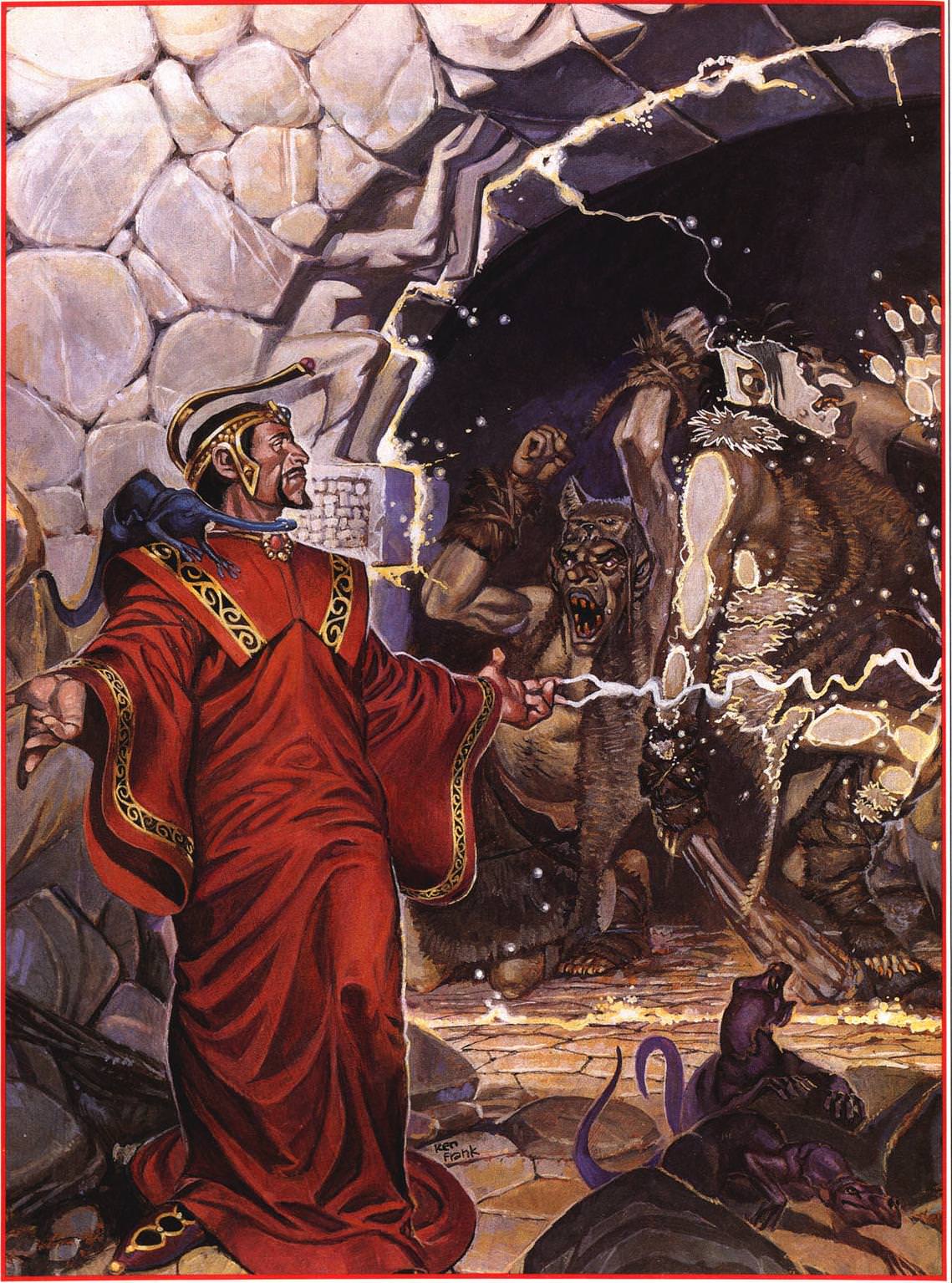
This chapter's not too long or interesting, so have a nice piece of art
This chapter's really just shopping lists, first the "common" stuff, and then weapons and armor. The common lists are... well, a mixture of stuff adventurers would care about, like mounts, rations and the prices of services, and stuff they'd never give a damn about like the cost of 100 eggs and a pound of coarse sugar. I suppose it's relevant if they want to run a trading empire(but then they probably wouldn't be playing D&D), loot some commodities rather than the gold and gems or just for getting an idea of what 1gp is actually worth in common life(for instance, when you know that it costs about 35gp to have a normal standard of living for a month, it gives you an idea of what sort of bribe or payment 50gp is to a commoner), but it's rare I've ever actually found a use for them. Also, unlike 3e and onwards, there really aren't many "useful" items outside of weapons and armor. Sure, there's rations, 10-foot poles and rope, but if I remember my 3e right, the equipment tables there were bristling with a variety of alchemical mixtures and consumables. I mean, I also seem to remember that they were primarily utterly useless thanks to the devs' fundamental failure to understand their own game and its maths, but in theory it added more stuff for the non-magical classes to do in combat.
As it is, all you can do here is buy a ridiculous amount of live swans or geese.
The armor tables are more or less uninteresting, as armor really only has two stats(unless we hate ourselves) which is what they set your base AC to and how much it costs. Also the weight, I suppose, but I've yet to play in a game of D&D where encumbrance was actually being meticulously tracked. The most interesting thing about the armor table is that the cost and weight are on one page, before the weapon stats, and then actual AC is about five pages later, after the weapon stats. The book could've used more editing, is what I'm saying here. There are also multiple suits of armor with the exact same AC, but wildly varying prices, and the only tradeoff being about 5lbs of carry weight for taking the cheaper one. If we wanted more detailed armor, there are optional rules which give each armor different AC vs blunt, slashing and piercing damage, but that's a fuckload of intricate bookkeeping, and most monsters don't indicate what kind of damage they do, really only weapons do, so be prepared for arguments about whether a beast's claws are slashing or piercing and so on. Welcome to the Hell Zone.
As for weapons. EIGHTEEN FUCKING POLEARMS. Eighteen. Fucking. Polearms. When in all my years of running 2nd ed I've never seen a player use any polearm. The reason for this is... there's no real reason to use any but a small number of superior weapons that roll up with better speed factors(initiative modifiers) and damage than the rest. Costs are somewhat forgettable unless you need to replace your weapons constantly because your GM is a fuckface that keeps bombarding you with rust monsters or otherwise disarms your character. So, really, since the weapon stats are simplistic enough that there's not really such a thing as niches and different tactical uses for these weapons(barring a few that can be braced against cavalry or have noteworthy bonus damage against large monsters), what you're going to do is you're going to buy the weapon with the best stats, which you probably also specialized in, and maybe grab a backup just in case a Rust Monster eats the first one and your GM makes you use a looted short sword at a massive non-proficiency penalty.
Also, blunt weapons and axes are explicitly worse than swords, though your GM could be a dickhead and flood the game with skeletons which take reduced damage from everything that isn't blunt damage or some sort of magical attack. So spend one of those spare proficiencies on hitting things with hammers.
Crossbows are also utterly useless, but in this case for multiple reasons. Bows have a superior rate of fire, any kind of bow has a 2x rate of fire compared to light and hand crossbows, and a 4x rate of fire compared to heavy crossbows. Heavy Crossbows cap out at an unimpressive 1d4+1 damage, while bows do 1d6 or 1d8(depending on arrow type) and can benefit from Strength damage bonuses(up to a limit defined by the bow's pull weight, for really high strengths you might need custom jobs or special materials).
These are the sorts of flaws I'd mentally tuned out while playing the game for so long, because of having a small sheaf of house rules intended to deal with them, but Christ, reading this for a review helps indicate just how egregious it really is.
Analyzing Chapters 5 and 6: Proficiencies and Equipment

Chapter 5 is probably the first DMG chapter where I'm unhappy with the tone of the book, because it suggests weapon proficiencies mostly as a way to fuck with the players. "Ah, BUT! What if Longsword Jane loses her longsword and suddenly has to use a shortsword so now kobolds can kick her ass?" I mean, I can see the idea that a hyperspecialized character without their signature weapon might be challenged by the loss of it, but the book specifically calls out that the player will likely be frustrated and start arguing, and establishes an extensive argument for why a Longsword proficiency wouldn't apply to a Shortsword, in order to pre-emptively beat down the complaining player. Really, it's almost an entire half page's worth.
Practically, the game has little room for disarming maneuvers except for AoE stuff blowing up the character's gear or specific monsters like Rust Monsters that can melt stuff out of your hands. So unless the GM fiats some sort of thing that causes it, or there's a good excuse(like a natural 1), it's really rare that a character will be without their chosen weapon barring a vindictive GM out to "teach them a lesson" in some bullshit way.
The tone switches near the end to "don't fuck the players over too badly, use it to add tension, not to make them despair utterly and stop having fun!" but it still comes off really badly from the way the section starts.
Somehow, though, the weird "fuck min/maxers"-attitude even leaks into the NWP section. It suggests, firstly, and reasonably, that you tailor NWP lists to the region(for instance, it suggests, in a fishing town, sea-related skills might be General skills because everyone growing up there has some contact with the industry and the shoreline), but then suggests not showing the players your tailored list, and instead having them submit vague orders for the NWP's they'd like, and choosing the most appropriate ones for them, just so they don't somehow "game" your intricately designed skill selection.
Then the next section whiplashes around and goes: "Heck, if players want to introduce new NWP's, let 'em! Sure, sometimes they might be trying to get one over on you with an OP idea, but give them the benefit of the doubt!" so either someone on the writing team had a Jekyll & Hyde thing going or their editing needs work. What a shocker, right? I really like the writing when it suggests to let the players design their own stuff, and to give them the benefit of the doubt, and explains that NWP's are good because they add some depth to characters and suggest a background to them, and give them new tools to be creative with. That's when the DMG is at its best, not when it's suspiciously watching every player for attempts at min/maxing or seeking ways to take them down a peg.
Chapter 6 in the DMG is mostly advice on worldbuilding if you're not using a pre-made world, being mostly historical trivia about trade, currency and technological availability(for instance, if there's platemail around, it's probably a society at least into the Middle Ages, if players can buy an arquebus, you're probably hitting a local equivalent to the Renaissance, etc. There's also a short section about letters of credit and barter economies, and their roles in the development of the economies we can recognize today. It's really fascinating stuff if it's your first exposure to those facts and ideas), but the focus is primarily on how to add flavour to the game, by turning Gold Pieces and Silver Pieces into some more interesting, local currency rather than a generic item.
It also takes the slightly player-hostile tack again after that by going into what to do if you give your players too much money. Why, clearly you should find bullshit and arbitrary reasons to remove it by having their shit burn down or just plain be stolen! It concedes that maybe you should let your players foil some of these, but you should always be ready with new bullshit shots at their fortune! I just feel like it's a completely alien approach, why not tempt them to lose the fortune instead? Have NPC's come to them seeking aid for dubious investments, or promising to sell them legendary artifacts at a tenth of the asking price. Let the players' own agency determine what goes wrong, and if someone really is just gunning for them and their stuff, always let them have a chance to counter it if they're clever or perceptive enough.
Mechanically, this chapter is the hiding place for a couple of somewhat important rules. One is that this is the only place where you have rules for variant materials to make stuff from, though only one of them actually matters(well, two, but you can't actually buy Elven Steel gear, only find, loot or steal it), as most of the non-standard materials are actually penalized. Why would I even want to know the price variant and AC modifier for making a suit of gold armor if it's literally just me paying extra money for something that's extra garbage? Maybe tell me how much I can sell that trash for instead.
The other important rule is item saving throws, about the only place where you can find info on what happens if a Fireball sweeps through an area, or a Lightning Bolt blasts through someone outside of the damage they do to living things. It is, in fact, another reason why the Fighter is so much more useful than the Mage: He won't blow up, melt or disintegrate the sweet loot they're carrying, which the Mage might well. This table generally serves two purposes, to arbitrate whether a PC's Lightning Bolt can be used to blast a door open or not, and to destroy half a player's inventory when he flubs his Save vs Spell, if you really want to play it entirely by RAW. Getting hit by a Lightning Bolt, in particular, and fucking up your save, has an excellent chance of destroying everything you're carrying that isn't made of ceramics, ivory, bone or wood.
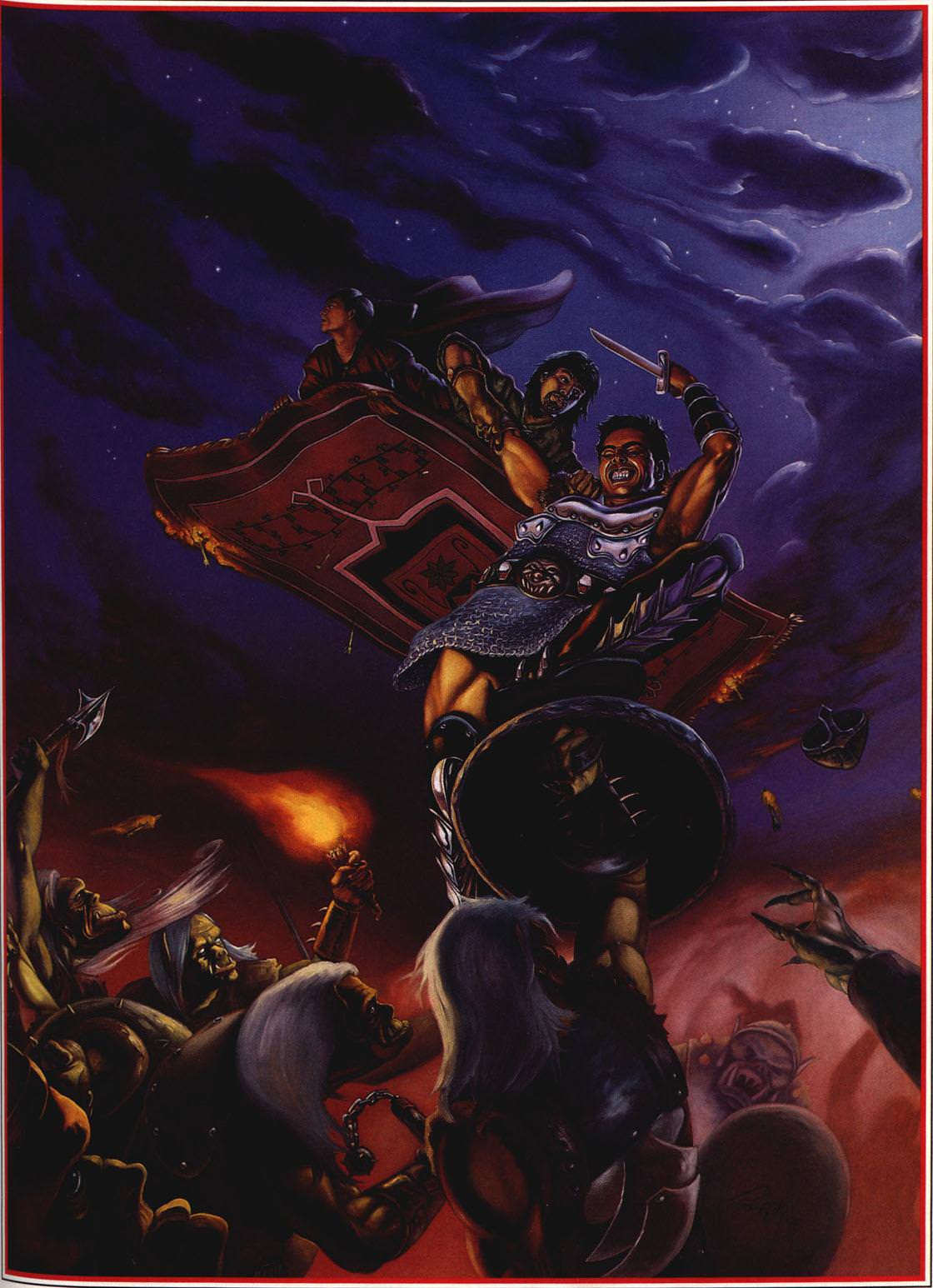
Chapter 7: Magic
Original SA post AD&D: 2nd Edition
Chapter 7: Magic

So the book happily tells us that some of the most powerful tools we have at our disposal are spells. This is both correct and false, spells are pretty powerful, but unfortunately they're wielded by wimps who're busy being bullied by Fighters machinegunning lawn darts across the battlefield. The only place where mages have a clear and inarguable advantage is if we're dealing with literal armies of enemies, or if they're given several days of careful preparation and perfect intelligence on their enemies.
It also tells us that the reason bards can cast spells at all is because they make friends with lonely wizards and convince them to share their magical knowledge. Not doing good at convincing me about the arcane sanctity of the wizardly brotherhood, here, game.
Next, it starts in on what magic actually is in 2e AD&D, which is an interesting topic, because I think every setting's had some sort of variant assumption about it. From the very weird(Dark Sun: Literally eating life energy to shit out fireballs) to settings where it doesn't matter(Forgotten Realms) to something in between(Birthright: Where only elves or godblooded can tap into real arcane magic and everyone else can really only use it for party tricks). The book's answer is... no one really knows. The accepted answer is that we're draining the batteries of some other dimension to fuel our Wish spells, and that wizards just happen to be the savants who can memorize the highly complex and illogical equations, sounds and movements needed to poke a hole in the dimensional barrier and channel it the right way. Most wizards, it hastens to point out, don't actually give a fuck how or why it works, only that it does. Someone remind me what they need that Intelligence score for again?
As something that's more or less a footnote, though, it points out that whenever a wizard re-memorizes a spell, he has to take into account things like seasons, motions of planets, etc. which more or less immediately presents the adventure hooks that comets/asteroids and climate change could fuck up wizards' spellcasting.
Just to add a slight extra bit of "fuck you" to playing a wizard, by the way, the game re-iterates one of the weirdest rule omissions about 2e AD&D... it never specifies how you determine a wizard's starting spells except "you start with a spellbook, your GM decides what's in it." It leaves the GM with some adjudicating that determines everything about a starting mage's power level, so it's surprising there's not in the PHB, or any setting I've seen for it, any suggested method that actually gives you a baseline to operate off of.
There's also an extensive section on illusions, mostly about adjudicating when something's believable, when it isn't, and what effects well-crafted illusions have on enemies and characters. Specifically, if you create an illusion of something that should, believably, kill someone, like a giant rock falling on them? They may just keel over from a heart attack. It's about a 50-50 chance whether it'll kill the average mortal resident of the setting.
A few posts back I mentioned a rule about dual-wielding that I'd never found until a few months back, due to the damn way this book is organized. Here's another thing I never found before: Mages and Clerics lose their Dexterity bonus to AC while casting spells. Which in the Mage's case is likely to be his ONLY defense at all unless he's got protective spells or magic items. This is extremely fuck you to wizards and I wonder if 3E was in part designed by people who got angry that their mages kept getting bullied out of their spells(to recap, in 2e, there are no concentration checks. If you get hit or fail any saving throw while casting a spell, it's instantly a fizzle.).
Analyzing Chapter 7: Magic

To the game's credit, one of the first things the DMG does is it answers the question that I complained about the PHB never answering... by not actually giving a definite answer, or instead giving answers that are all kind of bad:
#1: Have the player list off all the spells he wants, keep rolling to see whether he learns them or not. I love this one because it can end up with a Mage that has no useful spells at all or nothing he wants.
#2: You just enforce which spells the PC should have. Hope you know what he has fun with.
#3: Roll 3d4 to determine how many spells he automatically learns... and then either pick them for him or let him pick them himself. Which is the best of a bad lot even if it can result in a wizard who only knows three spells at chargen. Fuck you, mr. mage.
The next bit then is about how mages get spells during play, which is mostly by killing enemy wizards and stealing their spellbooks, or looting scrolls out of dungeons. The DMG warns us not to let wizards have any spells that would fuck up the campaign, but hey, maybe if there's a spell that could casually fuck up an entire campaign don't have it in the game. Though to be fair, I can't think of many spells that could accomplish that. By the time a wizard gets any of the really nasty spells, the competition should also have ramped up their game.
The remainder is really just rules for how to randomly generate NPC spellbooks and how to adjudicate research of new spells. The latter could more or less be summarized as "don't let players copy an existing spell, changing nothing but letting them cast it way cheaper and easier. Also don't let them have a spell that makes them a God. Have fun figuring the rest out for yourself."
Analyzing Chapter 8: Experience
This is one of the few chapters that barely even exist in the PHB, so tackling the PHB's version of it wouldn't make much sense since there's essentially nothing there beyond, "YOU GET XP, SOMETIMES IT MAKES YOU LEVEL UP," and the DMG's version is the side that has something to actually point at and complain about.
It doesn't start out too badly, mind you, suggesting three metrics for determining XP. Fun, Survival and Improvement. If someone contributed to everyone's fun, they deserve more XP. Not dying that session is a baseline requirement for getting XP at all. And lastly the XP gained is largely determined by whether the characters experienced/tried something new or were challenged. After all, sitting in a cellar hitting rats with a stick might technically be fighting enemies worth XP, but by the 1000th rat, there's no new experience there, and the rats no longer pose a challenge of any kind for the player(the book uses an example with orcs, but it's much the same: enemies' XP values are predicated on them actually being a threat or other challenge to the players). This section is largely okay except for it's exceptional stinginess, suggesting that players should never in a session get more than 1/10th of the total XP needed to advance a level. This might be an okay idea at the higher levels, but if I had to spend 10 sessions as a level 1 character I think I'd start getting exceptionally bored with the pace of the game, because D&D has never been a game that's at its most fun at the earliest levels.
And then there's the part that I outright hate... "Individual Experience Awards," which just seem to encourage micromanaging your actions to gain the biggest XP output and will almost certainly annoy people as a lot of the opportunities for these very specifically-detailed XP gains are unlikely to pop up in equal quantities for everyone in the party(for instance, the Wizard just gets XP for using his spells to kill enemies or solve problems, the Cleric only gets XP for this if it somehow "furthers his ethos," so if no enemies of the faith show up in that session, sucks to be the Cleric!). Plus, giving the party members unequal amounts of XP would just be massacring the sense of team play and team work that these games depend on to be fun.
Though I'd be curious to hear if anyone's ever actually used these rules and been happy with them.
Chapter 9: Combat
Original SA post AD&D: 2nd Edition
Chapter 9: Combat

So, combat, it's more or less one of the most core parts of a D&D game. While successive editions have expanded on the non-combat sections, the crafting, the diplomacy, the skills, etc. combat still remains the most rules-dense part of the game, and the focus of a lot of character stats and abilities. And it's also usually what reviews focus on, as a result: What's good in combat, what sucks shit in combat, what's overpowered in combat, and likewise it's been a large part of my focus so far. When I say that a Fighter is hilariously stronger than a Mage in 2nd ed AD&D, I'm largely referring to the way the Fighter could utterly pants the wizard, how the wizard would be useless without the fighter for defense, and how the fighter will likely contribute more in most battles.
What I don't think I've done so far, though, is actually explain the mechanics behind 2nd edition AD&D combat, so let's do that.
Probably the two most core concepts are AC(Armor Class) and THAC0(To Hit Armor Class 0), THAC0 has a reputation as being a bizarre and confounding system, but that's pretty much false as long as you know how to add and subtract.
All things that can be hit have an AC, and it's never worse than 10(high is bad, low is good. 10 is the default for unarmoured PC's with no Dex bonuses) and almost impossible to make better than -5(conventional armor will cap you out at about 0). All things that can hit other things have a THAC0, which is never worse than 20(again, high is bad, low is good, all PC's start at 20) and outside of gods and demigods, is never better than a 1 or thereabouts.
When you take a swing at someone, you subtract their AC from your THAC0, and then have to roll the resulting number or higher to land your hit. So THAC0 20 vs AC 10 would be 20-10=10 or better to hit. If it's a negative AC, it ends up a bit different, though... say THAC0 15 vs AC -1. Then you get: 15-(-1)=16 or better to hit, because the two minuses essentially reverse each other. Again, simple maths. This should also illustrate why even a simple +1 or -1 is never irrelevant in 2nd ed. It'll always represent a major improvement to your chance to land or avoid hits.
Initiative is also pretty important, one thing that's a notable deviance from later editions is that initiative is rerolled every round, and actions are declared at the start of the round, rather than when your turn comes up, as each action(spell, weapon, misc.) has a speed factor associated with it that impacts your initiative and also because, for spellcasters, you may get interrupted if you get whacked before your spell goes off. It also means that the speed factor is primarily relevant when fighting spellcasters and you want to be faster than their spells, in a fighter vs fighter thing, it's less important unless it's close enough that acting second or acting first could decide whether you get another action at all, or whether you're a corpse. Conceptually I like it better than later editions' initiative handling, but I concede that it creates a lot more rolling for every round of combat, though the PHB suggests just 1d10 for each side in the fight to minimize the rolling, which helps it a lot.
Saving Throws is another important concept to 2nd ed AD&D. Each class has separate saving throw progression, and by and large saves are unrelated to stats.
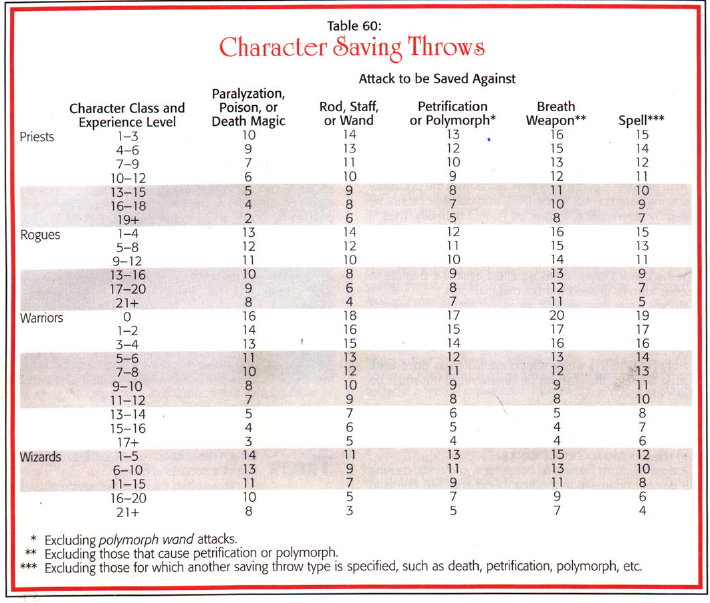
Saves are another one of those cases where you want a number since it's a roll-over, and outside of a few spells that have a set bonus or penalty to a save, or some weird optional variant spellcasting rules from the Player's Option books, mages have no real way of fucking with them. That means that when a Fighter hits level 13, he will shrug off 75% of all attempts to poison him or instantly kill him, no matter whether it's Bob the Apprentice casting something at him or the Dread Lichlord Skullbeard. This is also part of why Mages have a hard time really making their ultra powers stick against enemies at higher levels, while a Fighter just keeps getting more likely to stick his sword in stuff.
A lot of these saves also probably seem a bit esoteric. Like, are players going to be petrified or polymorphed with such regularity that we need a save specifically for it? To some extent, the Reflex/Con/Will save split of 3rd ed and onwards makes more intuitive sense to people, but under the surface naming scheme, a lot of that's already present in 2nd ed.
For instance, the Save vs Breath Weapon is also intended to be used as a general dodge roll(say a giant slab of stone comes out of the ceiling and is about to crush you flat), which makes sense, because really all you can do against a breath weapon is to get the fuck out of the way, so it would have to say something about your reflexes and dexterity. Paralyzation, Poison, Death Magic saves get used for physical and mental endurance checks, so a combination of Con and Will saves, really. Which again, makes sense, because all that prevents your soul getting sucked out is your raw willpower fighting back.
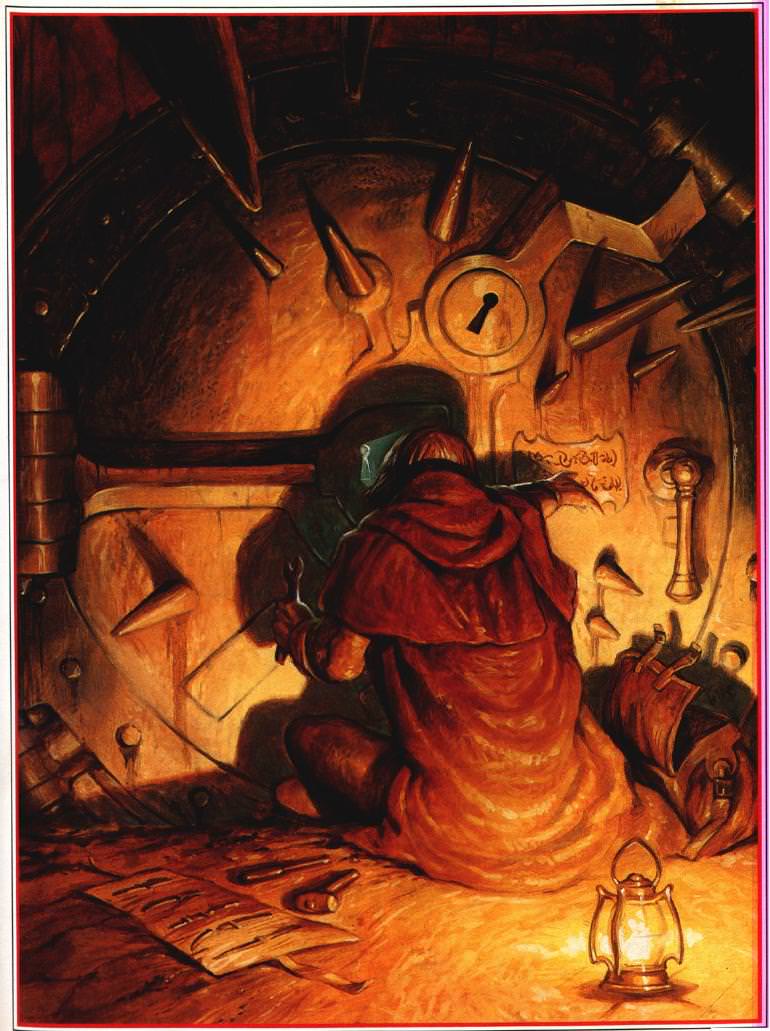
This is also where the book suggests the rule I already mocked a while ago, about having separate AC's for separate damage types depending on which armor PC's are wearing, which also requires the GM to on-the-fly adjudicate the damage type of various natural monster attacks when they aren't using a strictly statted weapon but just a vague "whacks at the players with a part of its body"-stuff.
There's a bunch of other little niche rules, like rules for charging, and speed modifiers for doing various misc. items, and then we get to one of the crown jewels of the combat chapter... the Punching & Wrestling section. Because of course, there's gotta be rules for unarmed combat. "Rules."
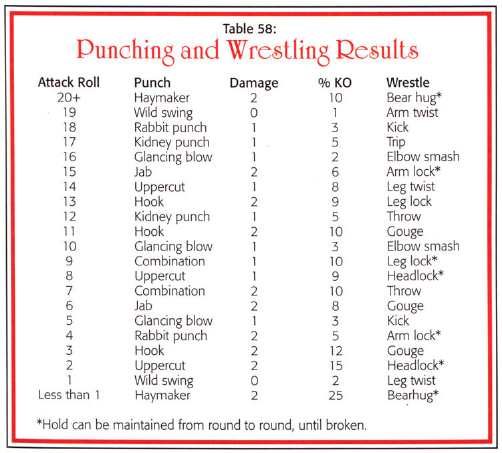
So, everyone's assumed to be proficient with unarmed combat, so no attack penalties for even the weediest loser. The only thing that can penalize you exceptionally is attempting to wrestle while wearing heavy armor. The way it works is you declare whether you Punch or Wrestle. Either way, you roll your attack, and if you hit, you refer to the table to see the damage done and, if you're Punching, the chance of scoring an instant KO which knocks the enemy out for 1d10 rounds. That's right, getting whomped by a mace or warhammer or even giant's maul won't have a chance of knocking you out, but a punch to the jaw will do the trick.
What's extremely important to notice here is that nowhere does the game say this only applies to human or humanoid enemies. In fact it doesn't even limit what you can attempt to Wrestle. So theoretically, and I'm sure someone can crunch the odds harder than me, you just need enough peasants to bum rush the dragon and start throwing punches that enough are statistically guaranteed to roll a nat 20, and then the 10% chance of a KO. On a nat 20 they'll hit no matter how shit their inherent THAC0 and then probably even the most inept adventurers could butcher the dragon before it wakes up again.
Wrestling is a bit less insane, though any sort of Lock will do another +1 damage every round its maintained, as well as your Strength bonus in damage, so you can really rack them up. Especially when you consider that the only ways to break a hold are:
#1: Counter-wrestling and rolling a Gouge or Throw result and hitting with those results.
#2: Having a friend pull the wrestler off you.
#3: Successfully hitting the wrestler with a weapon(which you are penalized at while being in a lock of some sort, preventing you from using any weapons larger than a dagger, so likely something you're non-proficient at because you didn't take proficiency in a sub-par weapon, you foooooooool).
Also the automatic damage every round would completely nerf a spellcaster. So, really, this is the edition of D&D for whoever wants to play a gang of shirtless dudes(or they could be wearing leather, leather armor doesn't penalize wrestling) that suplex wizards and punch dragons on the nose until they go down like a sack of potatoes, then pose on top of the unconscious monstrosity. I mean seriously, nothing here has any sanity checks baked in. I've re-read it ten times, technically you can put a tree or a slime mold into a wrestling hold or punch out a demigod.
The rules for overbearing also don't actually specify when you pull down and pin an opponent by weight of numbers. Can they still fight back? Are they completely paralyzed? Do they take damage by default? They're just "pinned." Presumably it means it can't act until the overbearers fuck up an attack roll, and that one of their friends could come over and stab the pinned guy in the head.
The remainder of the chapter is mostly combat-related miscellany like natural healing rates(long story short: if you don't bring a Cleric, be expected to spend a week or two of bedrest for your Fighter to recover his HP if he's nearly killed), energy draining(ha ha, it's a LITERAL lost level or more. No saves, no way of recovering them, you're just fucked my man. Outside of tournament play, I can't believe any GM ever used energy draining enemies without getting socked by his players, because they're like the capital A asshole thing to bring to the table, even more so than rust monsters or save-or-die stuff) and turning undead, with the odd sidenote that evil clerics can turn paladins like they were undead, effectively mind controlling them if they get a good enough roll.
Analyzing Chapter 9: Combat

For the most part this is oddly enough a copypasted version of the PHB chapter, word for word, even some of the same sidebars and tables. The new stuff is mostly stuff about facing rules(2nd ed AD&D actually assumes the use of miniatures in some sense so you can get your flanking and rear attack modifiers properly, not to mention the various AoE's and ranges of spells), critical hits(which are actually simply an optional rule here, it also suggests a variant where you basically Ulric's Fury it out, and every 20 gives you another free attack, with no upper limit), variant rules for what sort of hit dice a creature needs for its attacks to count as magical(allowing them to hit werewolves and etc. basically it turns out that your average brown bear can casually murder a werewolf. This makes them slightly less dramatic enemies) and NPC morale.
It starts off with some pretty interesting pointers about how most animals and intelligent creatures don't want to die, and will probably surrender or run away before it gets that far, unless they have fanatical beliefs, think they have the upper hand(right until they get cut wide open), are defending their lairs/cubs or something similar. We're encouraged to let intelligent decision decide enemy morale, rather than the dice, but if we do need the dice to make the call, we're given a pretty elaborate table of modifiers to help us decide how likely our enemies are to leg it.
One of the outright advantages of a wizard is here, though, they bolster morale on their side, and hurt morale on the enemy's side, plus blowing up an enemy with magic is one of the things that are supposed to trigger a morale check if you're letting the dice decide those things. By the rules, starting off the fight by summoning creatures to make the enemy feel massively outnumbered, and then sniping their toughest guy with magic could be enough to give even the most fanatical bad dudes a 50% chance of retreating, to say nothing about the more nervous types.
This does also cough up a few odd situations against singular enemies. Let's take your average dragon, for instance, who's likely to be operating alone(dragons aren't really social creatures among their own kind and most don't have henchmen loitering around their lairs). To start with, if he's on the ground, we can easily "completely surround" him, to force a morale check, since he's only one creature and even if he's big, a combination of the size of PC parties and possibly summoned creatures should be able to trigger that condition.
Now, the base morale of most dragons is either 18 or 16, let's be generous and say 18. We outnumber him more than 3 to 1, that's a -4 penalty, and of course the party has a wizard, so that's a further -2 penalty. He's already down to almost 12 morale, and if he hasn't killed any enemies yet by the time we get him surrounded, that's another -2. The morale check itself is a 2d10 roll, a roll greater than(but not equal to) the check TN means the creature(s) will panic and flee or otherwise react appropriately. That's approximately a 55% chance of the dragon flubbing his roll, plus, if he's already fulfilling the conditions for one other morale roll(being surrounded), we can force him to make another by offering him a chance to surrender.
The dragon can get some advantages on this if we're fighting it in its lair, but that would still be a 28% chance of surrender/fleeing, rolled twice, at more or less no cost or effort to the party. And the dragon gets a further -1 penalty to the TN of the second roll because it'll be two morale rolls required in the same round.
Lastly this section also has the rules on underwater and aerial combat, which more or less come up as: "If you fly better, you get more attacks in the air, if you're a fucking rock with wings, you're gonna get few attacks in the air" and "your fireball won't work under the sea, dumbass. also lol at you if you're dumb enough to fucking fast Lightning Bolt down here."
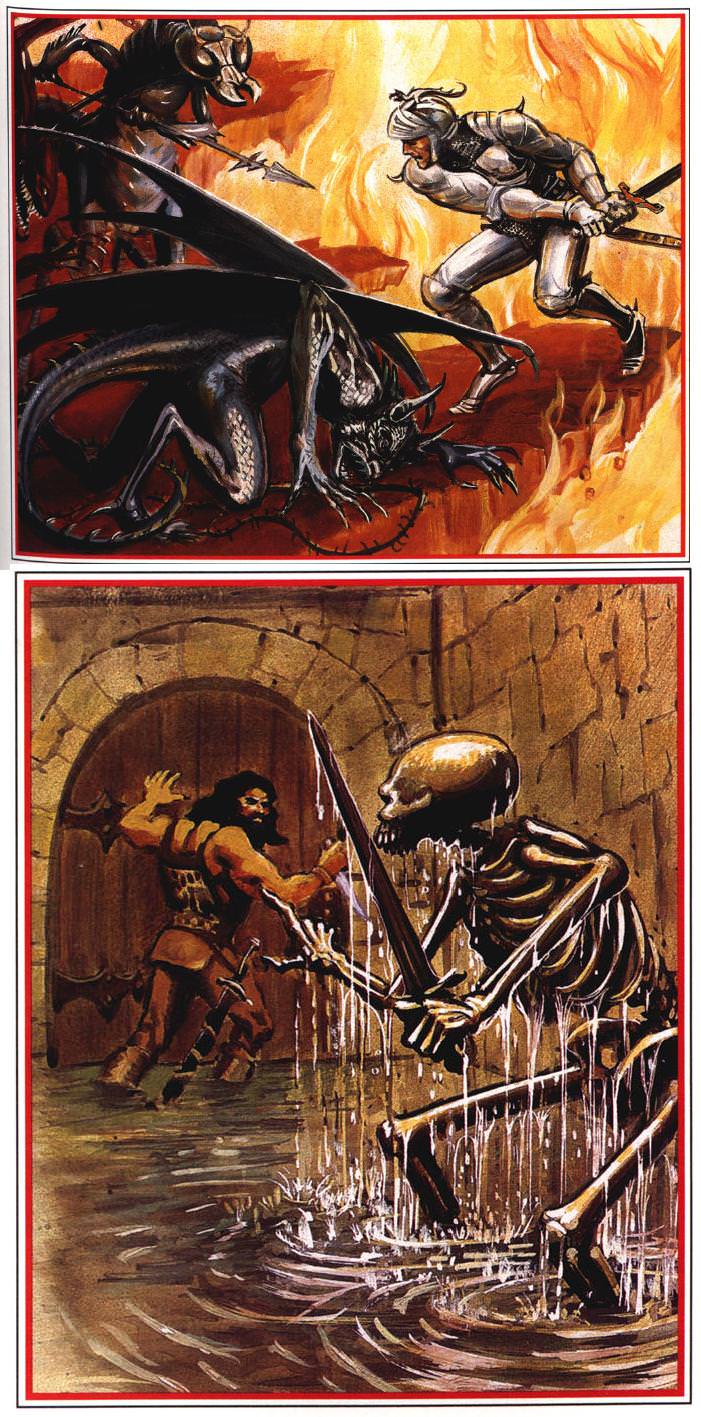
Chapters 10 through 14: Treasure, Encounters, NPC's, Time & Movement, Vision & Light
Original SA post AD&D: 2nd Edition
Chapters 10 through 14: Treasure, Encounters, NPC's, Time & Movement, Vision & Light

These chapters are all extremely vestigial in the PHB and I suspect they only exist so they could have the PHB and DMG chapters neatly mirror each other, because the PHB really doesn't have a lot to add about treasure except "sometimes the GM says you find nice things," for instance, and the NPC's chapter is really just a short list of what you could potentially hire. Movement is a bit more full, including a surprisingly detailed table of climbing modifiers, I suspect there was a lot of mountaineering going on in the devs' personal games(though I've never had any in a game I've run, at least not enough to need to call for any rolls...).
And after this, the book is mostly just spell appendices, Cleric and Wizard respectively.
Analyzing Chapter 10: Treasure and Magical Items

What takes up roughly two pages in the PHB is about six or seven times as much here, because knowing when and how much loot to hand out, and what can be handed out, is pretty important to the GM. The starting section is more or less a call to creativity, to not just hand out X gold coins, but perhaps some commodities(which may take effort to move and sell), deeds(attempt to redeem them or just trade them?), knowledge, etc. which is pretty important. Hell, handing the players something that's valuable, but not something they can just cash in down at the store for a suit of platemail("I'm sorry sir, but I don't 'have change' for a- [adjusts spectacles] -twenty-foot basalt idol of Norpgorp the Bleak, which menaces with spikes of adamantium and has giant emeralds for eyes. Try the fellow down the road.") can often be an adventure in and of itself. First you've got moving the damn thing, then finding a buyer, then dealing with the results of hauling around something so conspicuous.
The chapter also deals with the prevalence of wealth, why there are hoards of it lying around in ancient dungeons, who's got the wealth, how much there is, how common magical items are, etc.
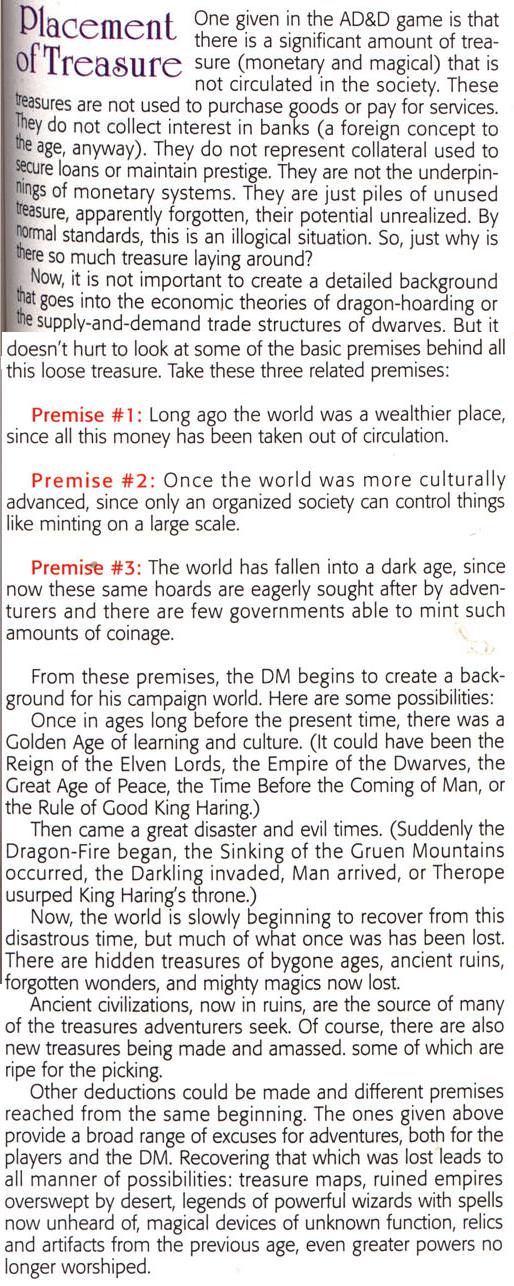
Plus sometimes some of the DMG's intentionally comedic writing still gets a grin or smirk out of me, even if I've read it ten times before.
There are also a few paragraphs on where it makes sense to find treasure, both with regards to animal-intelligence and smarter creatures. In the stomachs of enemies capable of swallowing characters whole, in the refuse piles outside animal-intelligence monster lairs(presuming they're not of the kind of the kind that find fascinating with and hoard shiny things), used to build a monster's nest, etc. while giving some pointers on how and where intelligent creatures may choose to protect their hoards rather than just stashing them under their bed or having them lying around in plain sight.
Of course after all this it then indicates how you should use the random treasure generation tables rather than putting in any hard work and just fuck your game sideways with whatever irrational shit it coughs up.
And then it finally gets to the part that I love about this game, one thing that really sets it apart from the later editions... magic items. Like, from 3.x onwards, magical items have a price point and it's assumed that you'll be able to buy them, or clap them together from a standardized recipe, with relatively little effort. In part because your non-mages are desperately going to need those +'s to stay competitive(and the mages to keep those lowly martials from getting uppity). In 2nd ed, it's a lot different. No magical items have a default price point, because, as the game points out: You're never meant to be able to just go shopping for magical items.
Personally I like it because it keeps some of, well, the magic of magical items intact. They're not just standardized and mass-produced, they're relatively rare, and even finding just a couple of them can be a major gamechanger for the party and its capabilities. Especially limited-use items suddenly become something the party has to carefully consider if they're going to use or hoard when there's an opportunity.
The justification for the dearth of magical items is threefold, in essence: Firstly, no one's selling magical items in large amounts. Player characters certainly aren't, so why would anyone else? They're hoarding that shit as dearly as PC's would. Secondly, magical items aren't being mass-produced, because outside of the simplest potions, their creation is usually bespoke and tends to involve rare components or even rarer accomplishments. Thirdly, even if they could be mass-produced, part of the process is inherently dangerous for the spellcaster: In order to create a permanent magic item, once all the actual enchanting is done, the mage has to cast a Permanency spell on the item, which runs a 5% chance of permanently draining a point of his Constitution. Considering that wizards are rarely the burliest of dudes and dudettes in the first place, that's a pretty considerable risk to run, especially considering that this also eats into the mage's System Shock rolls, which certain powerful spellcasting can also put strains on. So you're unlikely to find a wizard who's willing to just risk eating up part of his own mortality to give you another +1 for a few gold pieces.
Oh and even then there's a percentage chance the enchantment just plain fails even at the end of all that effort.
For PC item fabrication, it's more or less planned that players will create very few items over the course of their lifespans, since they're intended to be adventures in their own right, essentially. Something closer to when the dwarves of the Norse myths forged the chains of Fenris, using legendary and riddle-esque items, or at the very least something that requires long journeys, collecting stuff, actually parsing out what the required items will be, etc.
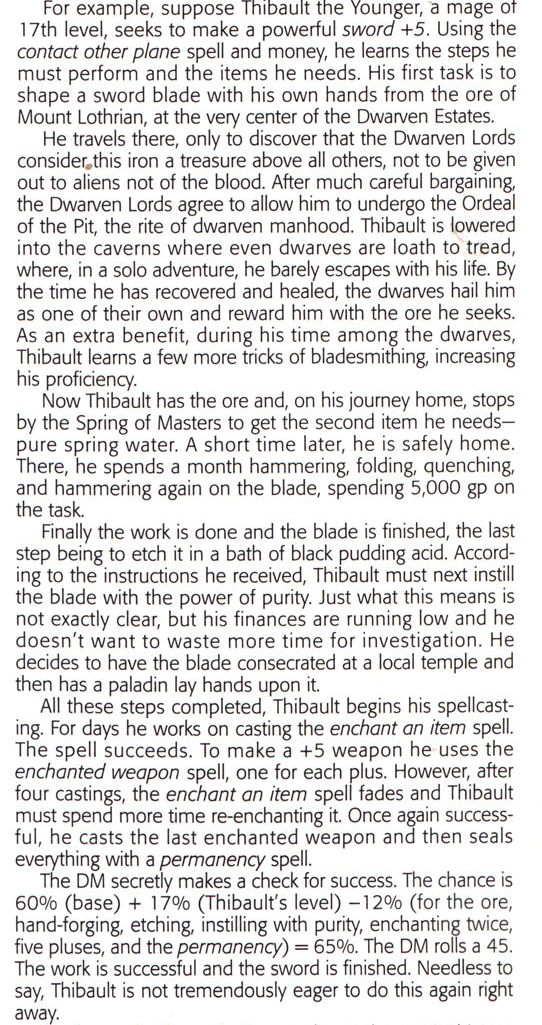
Comparatively, scrolls and potions are easier to make than any other sort of items, being the only ones that don't require Permanency spells and which have more-or-less fixed costs and components. They're still time-and-money consuming endeavours, but the sort of thing a player could conceivably bash together during downtime rather than forging an entire adventure around them.
Next there's a section on Artifacts and Relics which, hoo. AD&D has always had a problem with artifacts. Because they're meant to be these immensely powerful items that also have a commensurately nasty drawback so they're not completely unbalancing. But they more or less never get it right. Either the artifact's LEGENDARY POWERS amounts to a few first-to-third level spells a day, in return for which you turn into a corn cob under the light of the full moon, or the artifact can crack the world in half and the drawbacks are only really drawbacks if you're not enough of an asshole to use the powers in the first place. Whoever originally created the rules also seems to have had a weird obsession with making even fully-statted artifacts wholly or partially randomizable, so congrats, you found the Legendary Hat of Beards, now let's see [rolls, rolls again, confers on sub-table, bites lip, rolls three more times, does mental maths] it lets you sense lies, cast Phantom Stench twice a day, you can also destroy the Sun once per week and every time you wear it, you have to roll a Save vs Death or die.
At least the pre-generated abilities and drawbacks have some attempt at balancing, but once you use the randomly rolled stuff(I believe there was a review of a book with Dark Sun artifacts some years back, it's a good example of it) you may as well give up any pretense of having a well-balanced or thematically sensible item.
Analyzing Chapter 11: Encounters
In what's more or less a running theme for the DMG, the Encounters chapter is a lot of good advice and then stuff that feels like an archaic leftover.
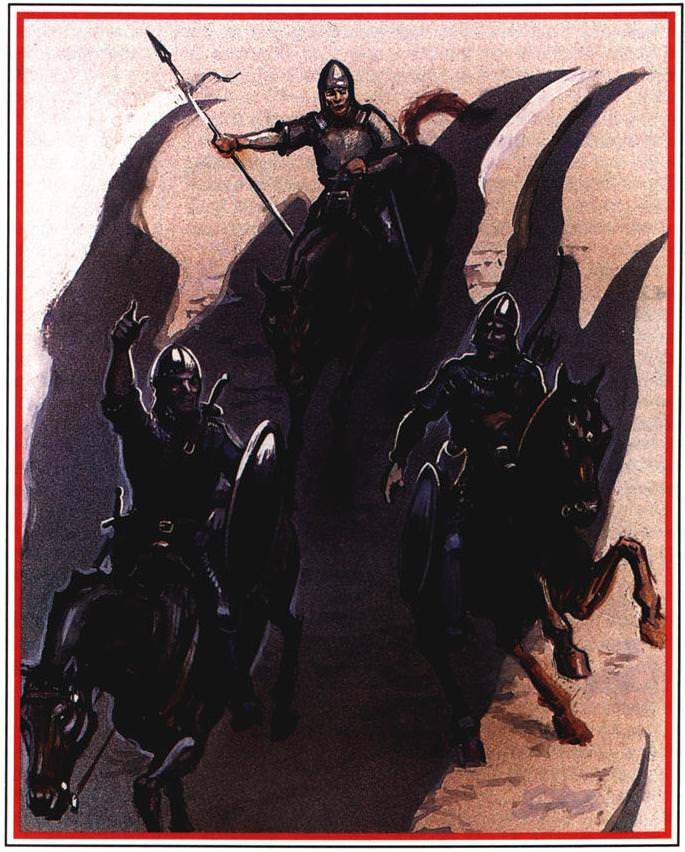
So let's start with the good part! First things first, for the new GM's(and frankly some old GM's could stand to read this bit as well), it describes what an encounter actually is and how it fits into D&D. It defines an encounter as being made of two things: Firstly, the players are dealing with something the PC's have set up, not just interacting among themselves and secondly, it has to be a situation where the players can make one or more choices, and those choices will have an impact. But I'll let the book speak for itself here with the following page.
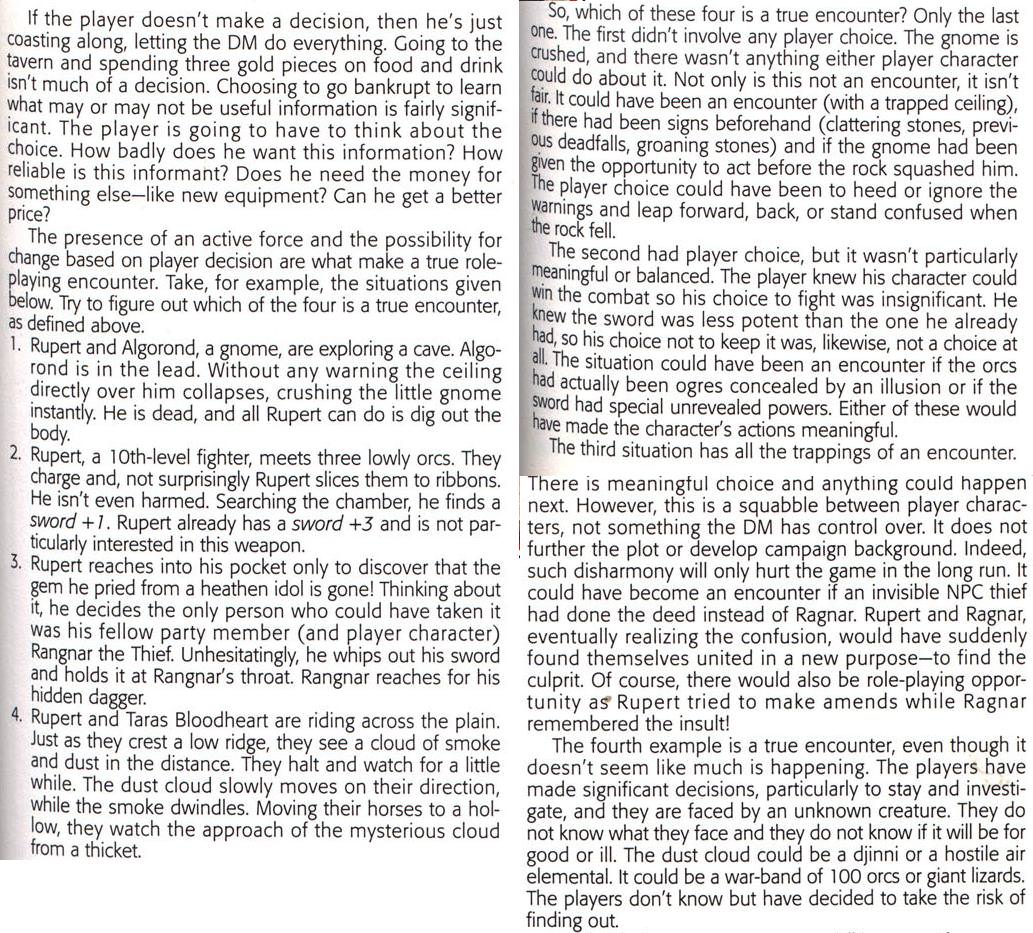
I remember when I first read this section, the first time I picked up the DMG. It blew my mind. Like... just the idea that a situation wasn't a good or interesting situation unless the players had a choice, or had some sort of decision to make. It's probably something we've all internalized at this point, but it's still really important shit. The other cool part is that when it describes how to write up an encounter, the DMG points out: "Hey, you wrote a really cool scene here, but remember that at some point your PC's will probably try to intervene. First figure out the course of events if they just watch while having a smoke, then figure out what things they're likely to do, and then the consequences of those actions." With the example being the PC's witnessing an attempted kidnapping, where the DMG points out that probably the PC's will try to foil it on instinct, so if they manage to do so, be ready to have the victim's story ready.
Then after all this focus on handcrafted, bespoke encounters the DMG tries to sell us on how random encounters are totally the coolest thing ever. I especially love how the random tables provided has everything from "hello this thing will vomit out endless save-or-die checks at the PC's" to "oh, it's something harmless, how delightful."
It always just felt like a half-assed solution to me. I mean, you don't need to keep track of the entire world's population, but a dungeon with maybe ten wandering encounters? It's not that hard to keep a mental map, if not a physical one, of where the enemies are, and who's nearby to react if the PC's make a racket, or who's patrolling/wandering where if the PC's hang out there for too long. For overland travel it makes somewhat more sense, but... I just don't like them. How many people actually use random encounters? To me it just feels like they take away from the thematics of an area by making it random rather than designed.
Maybe if someone really wants some sandboxy old-school-feel adventuring, but at that point they may as well just play a videogame, because if they just want rolling on tables rather than referee calls and design, the GM is kind of pointless.
Player's Option
Original SA post AD&D: 2nd Edition
So what's left? The only remaining parts of the PHB are the spells and the only remaining part of the DMG is the list of magic items. Both are essentially the same as in later editions though, of course, with the numbers adjusted to fit, and we both know that a wizard not cowering behind a meat mountain of a Fighter is never going to get a spell off anyway, so we may as well pretend he has nothing to cast.
But there's still a really important part of 2nd edition left, one part that a lot of people forget:
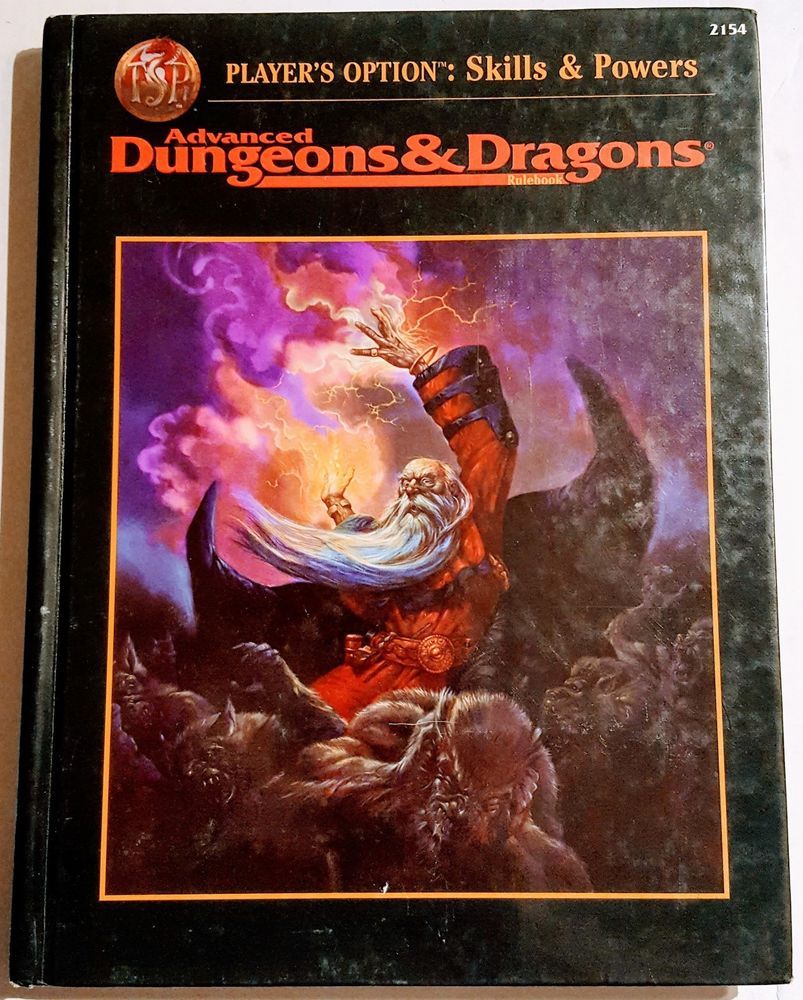
Why is this the only cover there's no such thing as a decent, high-res scan of?
Player's Option
About five years before we got 3rd edition, 2nd edition got an overhaul. It was even bigger than what turned 3.0 into 3.5, amounting more or less to a full rewrite of the entire character generation part of the PHB, not to mention all of the classes. The basic mechanics would still be much the same, and amusingly enough the combat classes would become more powerful than ever, but it was still an amazing overhaul. Sadly it wasn't quite compatible right out of the box with all the variant settings published, since some produced some novel classes and races that Player's Option didn't account for, but it's still something I use every time I run 2nd edition if I'm able. I dare say it was the biggest actual change to D&D until 3rd edition.
It consisted of three books:
Player's Option: Skills & Powers. This was the main overhaul to the core game, which also included making psionics a bit less of a mess(psionics in 2nd edition are their own interesting subsystem that was published separately from the rest of the game. Maybe I should give that a look as well.).
Player's Option: Spells & Magic. This was primarily just a list of new spells for clerics and mages, as well as more variant casters(most of them just different specialists, but it also included Wild Mages, which were some ride)
Player's Option: Combat & Tactics. This is the one PO book I never use, because mostly what it does is make everything fiddlier. If you're the sort of person who enjoys every attack roll involving three table lookups and five rolls on locational and critical hit tables? Go right ahead. But by and large, it was a bit of a miss since it just piled more mechanics on top, rather than overhauling any. It was also either this or Spells & Magic that tried to power up mages a bit by giving them level-based improvements to chances to "crit" with spells.
One thing that's going to be interesting is that a few ideas in Player's Option skipped some generations, disappearing during 3rd and 4th ed, and resurfaced again in 5th edition, in a slightly different form.
Player's Option: Skills & Powers
Chapter 1: Character Points
Oddly enough, despite being what I consider to be the most core of the PO books, the foreword describes it as an addition to Combat & Tactics, not the other way around, and then dives right into the new mechanics. The biggest new thing is that we're given a new chargen currency, Character Points, which will follow us all throughout chargen. Rather than having non-weapon proficiency points, proficiency points, etc. we just get CP's at chargen(defined by our race and class) and CP's at every level-up, and everything has a CP value now. Basic statistics are the only thing that's exempted. We also get to save them as Fate-esque rerolls(blowing your level-up stuff on rerolls always struck me as a terrible mechanic, but it was kinda early days for even having that sort of mechanic).
Speaking of stat points, we're also given a few new stat-rolling methods that get closer and closer to just having us assign points, until one of them is just that. Though I do like the variant of 3d6-down-the-line that gives you 24d6 to spread among your stats(you can assign between 3d6 and 6d6 to each stat, taking the three highest rolled for each stat) and the one where you roll to see how big a point pool you have to assign... but the bigger your point pool, the higher the cap on your individual stats. For instance, rolling the biggest pool lets you only assign up to 16 points to each. There's also one method that lets you use character points as stat points, so you could technically dump some stats to bank more CP's for a later stage of chargen(each stage gives you a pool, and any unspent points are carried over to the next).
Mostly, though, this chapter is just for explaining CP's to us and giving us a table to roll a character background on(none of them have mechanical effects, it's just to explain why you're adventuring, whether it's to find a lost love, because you were falsely accused of a crime and had to leg it from your homeland, etc.).
It's also worth noting that the character points are largely something you don't have to use for the following chapters. It's designed assuming you will, but there's more or less always an option to drop back to bog-standard chargen so you're only doing, say, races or classes by the new rules.
Chapter 2: Ability Scores
But wait! Didn't we just do ability scores? Well yes, we assigned our ability scores. But there's so much more to see and do in PO for every single stage of chargen.
Instead of having 6 base stats... we now have 12. Each stat supplies multiple bonuses, and now they're each split among two sub-stats:
Stamina and Muscle for Strength.
Aim and Balance for Dexterity.
Health and Fitness for Constitution.
Reason and Knowledge for Intelligence.
Intution and Willpower for Wisdom.
Leadership and Appearance for Charisma.
For each stat, the two sub-abilities are limited as always by a max of 18 and minimum of 3(prior to racial modifiers), and must be within 4 points of each other. And I really don't know how I feel about this system. On the one hand, it means players can specialize their characters more. Someone with a middling Dex could still be an excellent archer, but suck goats at dodging, or vice versa. It makes the system a bit more fiddly, though. On the other hand, when calling for stat checks, it also means you can very specifically call for someone's brute strength versus their long-term stamina. Or a rogue with high Aim and low Balance would be an amazing lockpicker and trap disarmer, but less great at stealth.
Another thing of note here is that if we're using Character Points, Intelligence(or rather, Knowledge, if we use the sub-stats) is suddenly a LOT more important for all classes, since rather than simply yielding bonus languages, it proceeds to yield bonus Character Points once we reach the Proficiency stage of chargen. And Proficiencies now also call out to specific sub-stats rather than core stats, if we're using them, and items can boost sub-stats, too(so, for instance, a pair of magic boots could boost your Balance without impacting your ability to Aim, which actually makes great sense.).
In addition to this, now having high stats also grants you rerolls on stat checks. Every point above 15 grants a reroll on a given stat check. So if we have 18 Muscle and try to force open a door, not only do we have a great damn chance at doing it, we also get to roll 4 times until one succeeds.
Chapter 3: Racial Requirements
This is where we really get into what sets Player's Option and its CP model apart from both the earlier and later editions. Not so much in the fact that it notably expands our race options(including some weird ones that don't pop up often, in case you want to be an intellectual yeti) and racial sub-options(what is a game of D&D without ten variants of elf, after all?), but in the way it applies a CP value to every racial ability. Each race and subrace has a list of abilities, humans can carry over ten points from this stage, non-humans 5, and weird variant races can carry over none(because they are often kind of broken). They also forgot to note something important, because for the first time there are core races with a Strength bonus(Half-Ogres and Half-Orcs each get a +1), which means that if their base Strength is 18... it becomes 19. This is titanic, because rather than a smooth step from 18 to 19, there are about five or six separate steps in between(from 18/01 strength up to 18/00 strength) called Exceptional Strength, which would be skipped over here. The sensible approach would be that it just elevates you by 10 points of Exceptional Strength or to the next stage of Exceptional Strength, and likely there's errata which notes this, but by core? Holy shit a Half-Orc or Half-Ogre Fighter is now the most powerful option by a landslide.
So as a dwarf, we get 45CP's, and most of our sub-race packages will cost 40 or 45CP to buy in total, and there's a list of dwarven racial abilities besides. We can either pick a subrace(sometimes the sub-races will have options which are not in the main list, or have better versions than the main-list ones.), then shop from the list, or just beeline for the list and make our own weirdo dwarf option. After all, who says a dwarf needs to have infravision? Some races get some amazing options here, for only 10CP dwarves get to halve all damage from blunt attacks, for instance, for a +1 to the Muscle subability(which determines our melee to-hit bonus and melee damage bonus) and this can also break the 4-point-difference limit between Muscle and Stamina.
We need to pick carefully here, though, as racial abilities can only be bought at chargen and not since. Though, I'll note, that kind of leaves out an interesting system design option for letting players play non-standard, really powerful options like Illithids or dragons, for instance. Simply have the full dragon/illithid package cost more than they get at chargen, let them buy what really matters, and then leave them open to buying the rest over time for CP's instead of spending them on class/proficiency stuff. But you're here to hear what a glorious thing this system is, not to listen to my game design fanfic.
It's generally a good system, also for the first time, humans get racial abilities! They only get 10 CP's for this, so whether to use them or carry them over is a big goddamn choice. Especially since one of their 10-point options is Tough Hide, available only to them and half-ogres, which gives a base AC of 8(or a +1 bonus to AC when wearing armor with better AC than 8). It'd be a huge boost to a thief(since generally all their abilities take penalties if they wear any armor) or a mage(since they can't wear any armor and lose Dex-related bonuses while casting spells).
Player's Option posted:
The races described here include: aarakocra, alaghi, bugbear, bullywug, centaur, flind, giff, githzerai, gnoll, goblin, hobgoblin, kobold, lizard man, minotaur, mongrelman, ogre, orc, satyr, swanmay, thri-kreen, and wemic.
Also this is what you can play if you want to break the game. Mostly, anyway. No attempts were made to balance this list of races in either direction. This is the only place you find bonuses and penalties of +2 and -2(Ogres, Minotaurs, Alaghi and Giff), which are for some reason all to Strength and Con. Any of those four played as a Fighter will make your GM weep bitter fucking tears as you demolish anything he throws at you. Some of these races also have IMMENSE natural AC, an Alaghi has a +2 to Strength and starts with a base AC of 4, Minotaurs can do 2d6 damage with their horns which is more than any other non-magical melee weapon. There's no word on whether the Alaghi's fucking punches(which also do 2d6 damage) utilize the broke-ass unarmed combat rules, but technically I guess they should. Enjoy your auto-KO chances.
A few options, like Goblins and Kobolds, just plain suck, but Minotaurs, Alaghi and Thri-Kreen are probably the stand-out insane choices.
Definitely if you bring these into the game you'd want to give any "standard" races a bonus CP pool so they can keep up.
Aside from the missed thing with the Strength bonuses, and how broke-ass the variant races are, from here on out we're in the Cool Zone where CP's show us how much they improve the system and let us really customize the hell out of our characters rather than Joe the Human Fighter and Jane the Human Fighter effectively being the same character.
Player's Option: Skills & Powers
Original SA post AD&D: 2nd Edition
Player's Option: Skills & Powers
Chapter 4: Character Class
Character classes follow much the same pattern as races in PO:S&P, being suddenly given an extra jolt of customizability, both in terms of being allowed to pick extra advantages, but also extra disadvantages. Some assumed basic abilities are now also stuff you have to pay for, though. For instance, to recreate a generic 2nd ed Fighter you'd spend some of your 15 points on Followers(5) and Weapon Specialization(5), which would still leave you with 5 more points to spend. Though, each also get upgraded 10-point versions, allowing multiple specialized weapons or to gain followers before 9th level if a fortress is built before then.
On the other hand, if your guy is meant to be a lone badass, you could leave off the Followers entirely, and instead invest in, say, having a fucking D12 for hit dice, making you a serious juggernaut, or an innate 2% Magic Resistance per level. A 10th-level Fighter with a 20% chance to just no-sell any kind of magic(ON TOP of still having sick saving throws) is the sort of thing that makes wizards cry. If you wanted to recreate Conan from the movie you could invest in getting a +2AC when unarmoured, the D12 hit die and the ability to Move Silently like a thief, though to get all those you'd need to take some disadvantages(like only being able to use certain weapon categories, armor limitations(which would go well with the +2 unarmoured AC option and either the human-innate AC bonus or just a race with a sweet innate AC), or barring yourself from certain magical item categories).
Paladins mostly just get to junk some of their less-used divine abilities in exchange for being able to specialize like a basic Fighter, which is a good damn deal.
Rangers also get the weapon specialization option(which would go well with dual-wielding two weapons of the specialized type...) as well as being able to become more thiefy, for instance gaining a thief's Backstab ability, which would really let them leverage their Move Silently.
Clerics are interesting in that the custom Clerics the PHB/DMG told us we should be building while only giving us vague hints on how to do it are the basic assumption in Skills & Powers, Clerics get a huge point pool to spend, but the catch is that they spend it on buying access to their various spheres of magic, including being able to buy access to an entire wizardly school of magic(it's really expensive in terms of CP, but having access to, say, Evocation spells like their Cleric spells is massive. Plus, since they're cast as Cleric spells, the Cleric can still wear full plate while tossing around fireballs. It's also worth noting that generally a single Wizard school, excepting a couple that get shafted like Divination and Necromancy, has way more spells than a single Cleric sphere, since the Wizard spells are only split among eight schools while the Cleric is split up among like... 20 Spheres, albeit with some overlap). Everyone getting expensive Weapon Specialization access does steal some of the Fighter's thunder as an incredible badass, but this is close to making wizards irrelevant as a class.
Wizards, meanwhile, get access to Armored Wizard, which means they can cast spells while wearing one type of armor of their choice. It does not, however, say they also actually become able to wear armor, so this ability is useless unless they're multi-classed, but if they are, it's a huge boost. On the other hand, getting access to that means giving up access to three out of their eight schools of magic. So wizards still get kind of shafted. Welcome to 2nd ed AD&D: The "Shove Magic Nerds Around And Bully Them"-Edition, even when they do something that gives mages a boost, Fighters still end up coming out on top.
This entire thing always felt like where D&D should have doubled down. Rather than having 500 different splats, have the classic 8 to 10 splats(Fighter, Paladin, Ranger, Cleric, Druid, Rogue, Bard, Wizard... and then Specialist Mage as perhaps the 9th splat and Psionicist as the 10th if you really wanted to get exotic), and make them customizable. Depth rather than breadth. 5E kind of came around to it in an extremely limited way with its three archetypes for each class, but Player's Option always felt like the superior evolutionary path of D&D that got ignored.
Chapter 5: Character Kits
Kits were always a bit of a weird mechanic, in that they were grafted on in a dozen different ways post-launch, yet never appeared in the core books(PHB, DMG, MM). Instead, almost every supplement on races, classes or something else had a bunch of Kits to glue on to your classes. Most of them would be flavour only("You're a Jester, be sure to pick the Juggling NWP, or don't!"), some of them would be awful penalties("You're a Beggar! You start with the pox, no money, a penalty to all stats, and also the cops broke your knees just before the first session!") and a few were wildly advantageous for no penalty("You're an elf who dances with sharp stuff, have a bunch of bonuses because the writers of this book were the sort of scum who jam ten kinds of elves into all their fantasy. The fuckers."). It was mostly the former, somewhat the second and very rarely the latter, though.
The book recommends either letting players choose freely, or rolling a social class, then picking a kit based on that. Sadly, there's some degree of sanity-checking involved, so we can't end up with a Paladin Jester, though Paladins can, strangely enough, be Spies, Outlaws and a few other unexpected options.
Each kit generally consists of a description, some non-binding roleplaying suggestions, like, "A Swashbuckler's outfits and armor should be really flashy!" or "It'd be great if this Mariner actually knew how to handle a boat." and actual mechanical parts called Benefits and Hindrances. The only parts you're forced to adhere to are the Benefits and Hindrances, as well as any modifiers to the character's starting money. This means you can make a Mariner who has no idea what to do aboard a ship, an illiterate Scholar or a Scout who manages to get lost in his own back yard.
Player's Option is probably the most "mainline" book that presents them. Most of them are thoroughly uninteresting, such as the Assassin, which gets five disclaimers about how evil they are but ultimately their SINISTER ABILITIES just amount to being able to recognize poison more easily. Spooooooky. On the other hand, the Barbarian...
Player's Option posted:
Benefits/Hindrances: Barbarians are intense, and NPCs tend to have very strong reactions to them. People either are drawn by the barbarian’s animal magnetism or repulsed by his primitive qualities. This effect comes into play when NPCs meet barbarians for the first time. If the NPC’s reaction roll result is 8 or less, an additional –2 bonus is applied to the result. For example, if the character is acting indifferently toward a shopkeeper and the shopkeeper’s reaction result is a 7, the shopkeeper is indifferent. However, since the character is a barbarian, the –2 bonus applies, lowering the shopkeeper’s result to a 5—a friendly response. The shopkeeper has been won over by the barbarian’s presence. However, if the shopkeeper’s reaction roll was a 14 or higher, the modifier becomes a +2 penalty, resulting in a 16—threatening—score. For more information on reaction results, see the Dungeon Master Guide.
It's a cute idea, the idea that few people don't care about a Barbarian, either they absolutely love him or they absolutely hate him. It's an interesting take on the concept. I also really like the Peasant Hero, though it's essentially just a roleplaying aid:
Player's Option posted:
A Peasant hero is the “local kid done good.” Whatever his class, whatever his ambitions, this character always remembers that his roots are in the soil of his home—be it a bustling village, a quiet hamlet, or a lone farm miles from the nearest neighbors.
...
Hindrances: As he is viewed as something of a hero, a peasant hero will find the people of his homeland coming to him for assistance. If livestock are disappearing from the pens, or the village elder has been jailed for speaking against the nobles, or if another peasant is accused of crime he didn’t commit, the peasant hero will be called upon to help.
Since I like to imagine that no matter where the player is, even if he's in the Abyss or atop a mountain bargaining with the Gods themselves, some tattered peasant will pull himself over a ledge and go: "Help, help! We've lost a pig!" to this legendary, ultimate hero shimmering with five different auras of power.
Being a Pirate is also awesome since it comes with a pre-made, free hideout, up to and including your own suspiciously skull-shaped island, and apparently the only limits to piracy are racial. You can, in fact, be a Paladin Pirate by 2e AD&D RAW.
The unexpectedly OP kit is probably one you wouldn't expect, since it's called something as innocent as "Rider." In effect all it means is that you start off with a free randomly generated animal that you have a perfect bond with, more or less like a familiar. First it's a 1d6 roll for the type(1-3: "Normal," 4: Flying, 5: Giant, 6: Underwater), then a 1d8 roll for the specific animal. Obviously an Underwater mount would suck for most games, and the Normal results aren't really the ones we want(though we can still get a fucking elephant or a cave bear, and those can kick ass like a PC Fighter and then some for a good part of the game). Just about anything on the Giant list is in the same vein as the bear/elephant, giving you a hug early game combat advantage, and the Flying list is flight, that's huge, especially if you have a decent ranged combat option, not to mention that something like a Giant Wasp is a respectable combatant in its own right, especially for the early levels of the game.
It feels kind of strange, too, that Kits more or less vanished after 2nd edition. They were a cute combination of background fluff and crunch they really should have been kept around, it would have been even easier in 3e, if anything, since they could have consisted of skill bonuses/penalties more or less.
Player's Option
Original SA post AD&D: 2nd Edition
Player's Option
Chapter 6: Non-Weapon Proficiencies
In base 2nd ed, NWP's were kind of vestigial, you were only likely to ever get a couple, and they were super expensive to upgraded compared to how few and how rare points you got. That's no longer quite the case. Firstly, everyone generally starts off with more points to spend on them, as a consequence of rolling with CP's meaning that Intelligence directly contributes. This also means that the Mage's general fragility and questionable utility in combat is supported by probably being the party's skill monkey outside of combat, and that Intelligence is now a meaningful stat for everyone. Getting CP's on literally every level-up also means that upgrading your skills or getting new skills is something you'll probably be doing every level, not just three or four times during your character's 1 to 20 career.
The way proficiencies are resolved is also slightly changed, it's still a D20 roll-under, but rather than having an associated stat as the base target to roll under, each NWP instead has a base difficulty to roll under, which is then increased(or lowered, if you suck at the related stat) by having a good stat attached to it. The table of proficiency +'s and -'s for stats looks pretty D20. The way the math of this works out, is that you're less likely to start with proficiencies that you have a 60+% chance of using(though the book reminds us to only force rolls when there's a genuine chance of failure, not for every little use), but instead you can actually get up to those proficiency levels some time before level 20.
Another addition to the NWP chapter, bought and earned with CP's like everything else, is Traits and... oh boy, Disadvantages. Traits are stuff that doesn't quite fit under racial or class skills, and isn't exactly rolled, so it's not quite a proficiency. Stuff like minor immunities, keen senses, fast healing and ambidexterity. The Disadvantages, like most other games that have them, is where you score free bonus character points if your GM isn't on the ball, at least until a troll whaps you with a garlic sausage and suddenly that Severe Allergy: Garlic is forcing a save vs death.
Most of the traits aren't super game-changing, though ambidexterity is amazing, basically being a slightly worse version of the Ranger's class ability(the Ranger's version is zero dual-wielding penalties, but can only be done in light armor. Ambidexterity is a -2 on the off hand, but can wear whatever armor you like.), poison resistance(a +1 to your save vs poison) is also nice considering how absolutely brutal AD&D poison is if you get hit with it and flub your save.
The Traits are generally of the "the GM can fuck you over for free now"-type(allergies, for instance, or the nebulous "Unlucky" and "Clumsy") mixed in with the bane of the 90's: Roleplaying Disadvantages. Figuring out something you can be fanatical about without it being party-disruptive, or having compulsive honesty and just making sure the party gags your character any time lying is required, and you've got a nice bag of free points. It's by no means as bad as some games, but Disadvantages more or less never work in games. I don't think I can remember a single one where they do.
Nice changes, overall, but the real gamechanger is what comes next. Because you know who needed to be more kickass than in base 2nd ed? Fighters. Fighters needed to be more kickass with updates to...
Chapter 7: Weapon Proficiency and Mastery
So, firstly, any leftover points from the NWP's will carry on to the WP's. So if you want, your Fighter can be an illiterate who has no idea how to ride a horse or do anything useful other than Fight just to drag all his points on to this stage of the game to really party. Not that you'll likely need all that many, unless you invested in being able to specialize in multiple weapons(really not a bad idea), since the Fighter classes get the biggest point pools and the cheapest buying costs here.
Warriors get an additional bonus right from the basic proficiency stage, which is that they can pay a surcharge to learn an entire weapon group as a proficiency at once, rather than a single weapon at a time. It can be either very broad, like ALL SWORDS or more specific like ALL MACES(but not hammers, picks or flails).
Oh and the amount of things you can be proficient with are also increased. Sword & Board Fighters get a bonus by being able to be proficient with shield types for extra AC, and why don't you also learn the Sword & Shield fighting style, so you get another AC+1 and a +1 to attack when in that configuration? At this point the correctly built Human or Half-Ogre Fighter hardly needs actual body armor any longer.
Weapon Specialization remains largely unchanged, except that non-Fighters can now pay points to have access to it at the class abilities stage, while Fighters can pay to gain access to multiple Specializations at this same stage(a melee weapon and a ranged weapon would definitely be a strong combo to specialize in). Aside from that, the main difference is that ranged specializations are now even better and you can specialize in punching people(Combat & Tactics features a new and exciting system for how to beat someone so hard around the head with your mailed fists that his eyes come out of his ears). It's still a badass boost to power, but now it's really just what the Fighter does while waiting to truly eclipse everyone else.
The next thing is Weapon Mastery. Usually, level 5 is a really cool level. It's where Mages and Clerics start to pick up some of their proper signature options, like Fireball, and really start becoming useful as something other than budget Fighters. Comparatively, it used to be a bit of a let-down to the Fighters who were still badass, but mostly it worked as a milestone saying they were halfway to 9th level. Now, 5th level is where Fighters get access to Weapon Mastery, which is a step up from Specialization. It upgrades melee Specialization to a +3 attack and +3 damage, as opposed to its former +1 attack, +2 damage. This is a no-brainer choice for any Fighter as its effectively the same as instantly levelling up twice, adding a bonus +10% chance to hit any target.
It makes Fighters a lot more powerful, but that's about all they g-
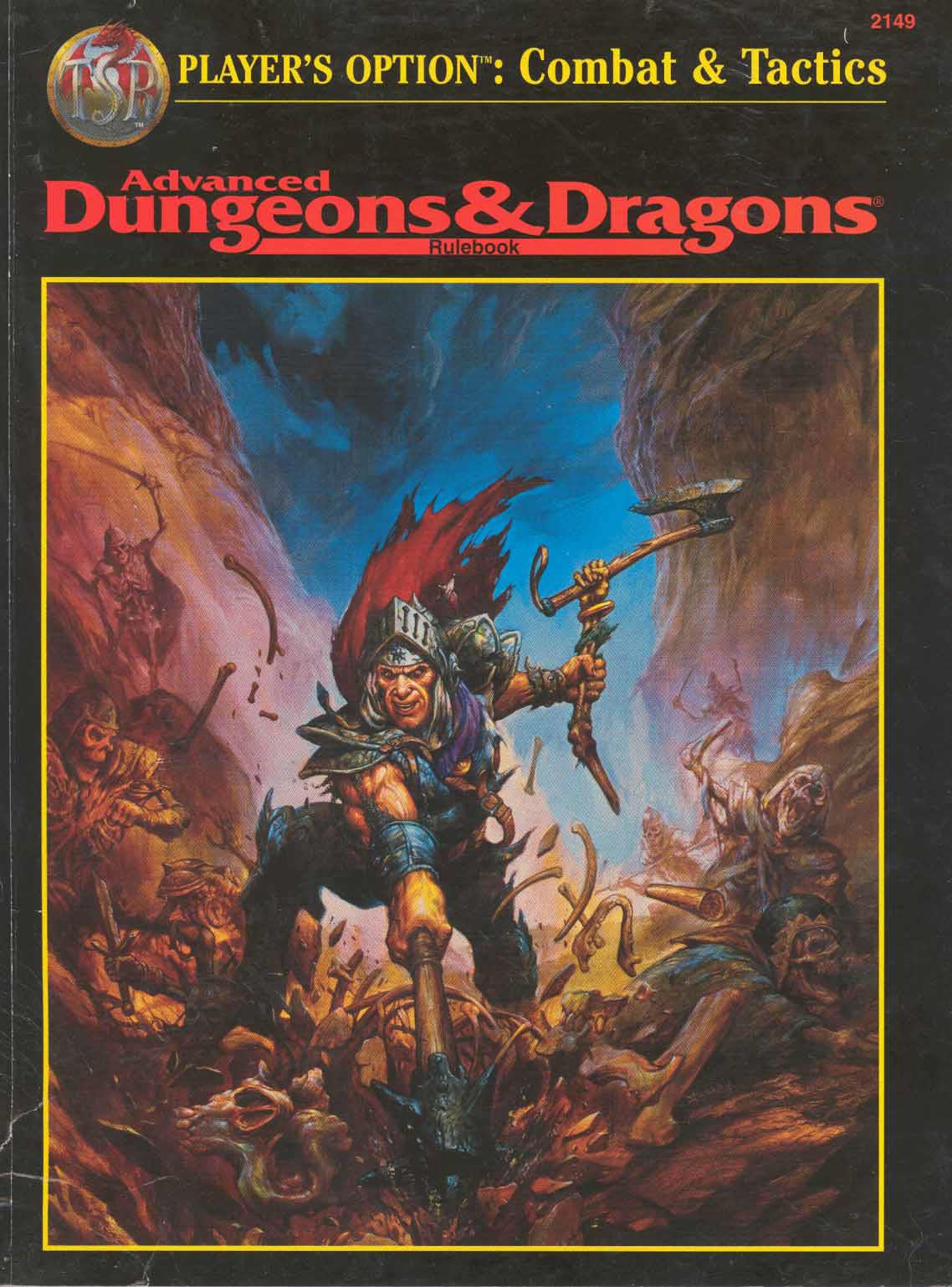
Hold it right there! Badass cover comin' through!
Player's Option: Combat & Tactics
You think that's all Player's Option has for Fighters? THINK AGAIN. By the time he hits 6th level, the Fighter can gain High Mastery, this gains him the ability to crit on an insane 16+(no loner needing natural 20's) as long as he rolls 5 or more than what he minimum needed to hit. There are very good odds he will roll this well. And just for a bit of icing, his weapon also straight up improves in speed factor. The next step is becoming a Grand Master, which you can, if you have the spare CP's, do the instant you become a High Master. This starts by upgrading your weapons damage die(d4 to d6 to d8 to d10 to d12) and then gives you another attack per round on top of what you'd normally get. Obviously, the GM is encouraged to require a quest to find some legendary super badass warrior to train you to High and Grand mastery, but why wouldn't you go on that quest? The rewards are insane.
If you're using Combat & Tactics, on top of that, there will be severed limbs sailing in every direction. But we'll get back to that after Skills & Powers...
Player's Option: Skills & Powers
Chapter 7: Weapon Proficiency and Mastery
Oddly enough, immediately after detailing Weapon Mastery, this chapter launches into a section on how to master capitalism instead, talking a lot about character wealth. It points out how your character may well own several thousand gold pieces, but how is he going to cart that much around? And how can be avoid the messy business of being a jingling mountain attracting every wandering monster for miles? The answer is mostly business and investments. Loan the money out, charge ruinous interest rates, invest it in a business, replace it with lighter high-value trade goods, engage in charity(if you just want to get rid of the damn stuff and cross your fingers the GM remembers that you donated it later on). We're also taught the exact value of an education: 4,000GP per free CP we want. It's not detailed that's how it works, it just says characters can pay 4k GP per CP they want, so perhaps they eat it, or offer it to the gods who grant them power in return.
There's also an updated equipment chapter where Crossbows finally start doing decent damage, enough to be reasonably competitive with melee weapons(though still not really a great choice since bows beat them out due to their higher RoF. Heavy Crossbows in particular hit like two-handers, and then some, against large enemies. So if nothing else, worth equipping henchmen with if you're going big-monster hunting.)
Chapter 8: New Schools of Magic
This is basically just four new specialist wizards. Alchemists and Geometers, whose special thing is that they have lists of spells they can cast without any verbal components, with the Alchemist being more combat focused and the Geometer more utility-focused. Decent if you want to maintain some surprise or just cast a utility spell without alerting anyone. Shadow Mages, whose thing is that they have one of the game's rare few ways of penalizing enemy saving throws: The darker the area, the greater a save penalty their enemy gets. Their big downside is that they miss out on Evocation and thus lose all of the game's biggest blasty spells, but since they actually have some chance of sticking save or die/suck spells, they may not need them. They can, of course, also see perfectly in the dark, so they don't blind themselves with it. Lastly, Song Mages, who are the inverse of Alchemists and Geometers, in that they have a selection of spells they can cast with only verbal components, so in some sticky situations they can literally sing their way free even if another mage would be completely unable to use magic. Like Shadow Mages, they don't have much in the way of direct combat spells, instead their Song Mage spell list is mostly summons and alteration/charm effects.
Chapter 9: Psionics
For this to make sense, I would have to review the Complete Psionicist's Handbook first, because Psionics in AD&D are their entire own system. At core, they have more or less the same gear/combat abilities as a Thief(though nothing really ranged) and then their Psionics. They buy into six separate schools of abilities(Clairvoyance, which sucks, Telepathy, which adds yet another subsystem on top of the psionics subsystem, Psychometabolism, which only kind of sucks, Psychokinetics, which have a few awesome powers, Psychoportation, which also have a few useful things, and Metapsionics, which super sucks), buy abilities from those schools, power them with PSP's(Psionic Strength Points, it's just brain mana) and roll to hit with all their powers(it's like a proficiency check, a stat roll-under, and it can both crit succeed and crit fail).
Conceptually it's alright, but they peak around level 3 and then its all downhill, because the original Psionicists never actually improved their abilities. They were entirely bounded by their starting stats, and all they got was more PSP's and HP over time. On the other hand, very few of their abilities had level limits, so you could Disintegrate enemies or teleport them miles away(or up, if you were cruel) by the time you were a couple of levels into the class. But aside from that, they had no solid attack options, no solid defense options, no powerful buffs, etc. Psychoportation was super useful because it gave you access to stuff Mages wouldn't get until level 7 or 9 right off the bat, but once they got there, they had the advantage that they were a lot less likely to crit fail and teleport the entire party into solid rock, even if they could only do their trick once a day and the psionic could accidentally kill the party like ten times if he wanted to.
Telepathy technically similarly gave you access to powerful charm/dominate options, but did so without the enemy getting a conventional save. Instead, it took between one and three rounds of psionic attack checks(assuming they all passed) to hook into their brain, and then you also had to successfully use the dominating power, by which point the party's Fighter had likely already minced the entire encounter. Since all psi powers had no real "tells" when used, you could, technically, use them in ambush to mind control someone and make him start stabbing his buddies, causing trouble before the Fighter cleaned up, but it was an awful lot of rolling for relatively little result. It also had its own little telepathy combat minigame for use against psionic enemies when, again, your Fighter could just walk up and stab the shit out of them.
Generally the only place Psionics was useful was as Wild Talents. In Dark Sun, all characters, more or less, had Wild Talent psi powers alongside their normal class(which translated to them having one or two psionic abilities and a PSP pool for them, without having to fully invest in being a Psionicist and still having an actually useful character class to use 90% of the time, but with one new utility trick). In every other setting, you can visit a psionicist who tries to unlock your DEEPEST POTENTIAL. For most characters, this means a 90% chance of nothing happening, about a 5% chance of gaining a Wild Talent and a 5% chance of your character irrevocably becoming a drooling vegetable with 3's for all his mental stats.
So, what does Skills & Powers do? Not enough, really. Primarily it unfucks the Psionics' power usage by making their success chances actually scale with level, with the drawback that at early levels the chance of fucking up is all the greater. Which means that the TRUE ULTIMATE POWER psionics eventually gain, they can't really reliably use until they've already been eclipsed even by weedy wizards. Psionic critical successes and failures were also removed. Ultimately, even this couldn't unfuck psionicists, and there's a good reason even hardcore 2nd ed fanatics like myself wouldn't touch them. Pretty much everything useful they can do would only be useful in a setting without common wizards and clerics, with much higher mortality than most 2nd ed and more of a requirement for subtlety. Maybe in a game where everyone was playing either a Rogue or a Psionic they'd be a cool choice. Fat chance of that happening, though.
That's about it for Skills & Powers, though, which remains in my mind an absolute must-use for anyone running 2nd ed AD&D. And if you ever played Baldur's Gate 2, you probably recognize parts of it: The changes from BG1 that weren't weirdly lifted from 3rd ed and jammed into 2nd ed were instead lifted from Player's Option(some of the kits, essentially and the crazy higher levels of weapon skill). I'll also do a post or two on Combat & Tactics, because it really makes combat a mess of rolls, at times, and I never really use it myself, but it tried to change things up.
Player's Option: Combat & Tactics
Original SA post 2nd Edition: AD&D
Player's Option: Combat & Tactics

I FUCKING LOVE SMASHING SKELETONS, this cover just deserves reposting.
Okay, so, Combat & Tactics, this is a book I've always avoided because every system it touches, it fundamentally improves... but usually in a fiddly, messy way. For instance, the entire first 80 or so pages out of a 200-page book are concerned 100% with making combat just a bit more fiddly. The ultimate result is satisfying in terms of system, and if it was a videogame I'd love every bit of it, but there are just way too many optional maneuvers and passive modifiers(for instance, on top of rolling to hit and damage with every attack, all attacks now also have a chance of proccing a knockdown effect, which the target then has to save against or get thrown on its ass) for me to ever keep track of at the damn table. It also does the thing where it goes: "No no, we wouldn't want to get too realistic! That would ruin the game and detract from the heroic atmosphere!" and then has rules for pike squares and compares their effectiveness to their historical equivalents. There is some tone confusion, especially when we get to the art.
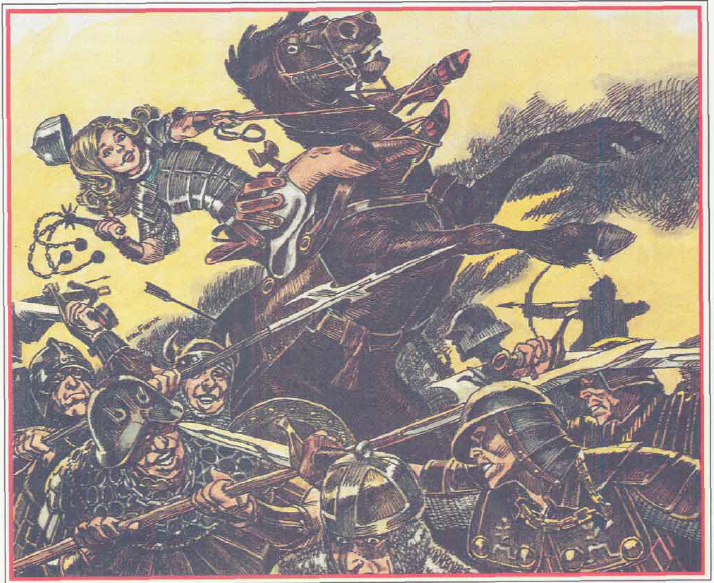
It's a bit more cartoony than the original 2nd ed art. Not bad, just a different feel and doesn't really jive so much with the gory content.
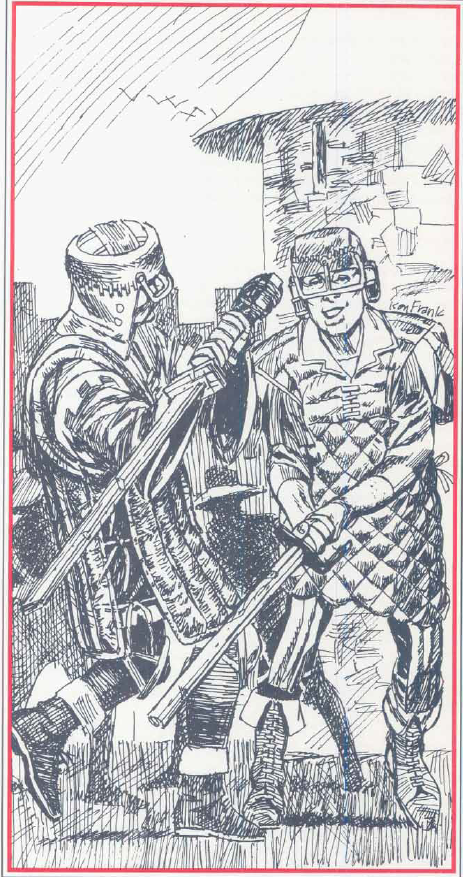
This is just a witty subtitle from being outta Paranoia, really. I wonder if Ken Frank ever did any art for that?
They go deep enough into the mechanics to completely overhaul initiative as well, making it less granular(rather than numbered speed ratings, weapons are now just Very Slow, Slow, Normal, Fast, Very Fast, etc.) which detracts a bit, in my opinion, but also commit the cardinal sin of making it a poorly-worded mess. As I read it, now each side rolls init, and an entire side wins init at once... but init is still split into phases depending on the action taken. For instance, say the players win Init, all Very Fast players will act before all Very Fast monsters, but all Very Fast monsters will still act before anyone else, and so on down through the speed categories. At least, that's my reading of it, but holy shit did they never quite figure out how to write things coherently in this book.
This is especially obvious when we get to the grappling rules.
Now, I went over the basic 2nd ed AD&D PHB grappling/unarmed rules. They were super rough, like, extremely basic, but resolved reasonably simply. Now they're Advanced Grappling Rules. Punching is still just decking someone(but also includes improvised weapons like hitting someone with a chair or a table, for some reason), but grappling is, as is appropriate, its own subsystem, and it's also utterly broken. Like mercilessly broken.
Basically, any Fighter who's not incompetent at grappling, will succeed at grappling except against very strong enemies, and once an enemy is grappled, really the only way they can break loose is to win a grappling roll or crit you with a natural attack/small weapon(most of which they can't use if you grapple them from behind, reasonably). At this point, you can then crush them like a tin can. And you could also argue that wrestling damage ignores damage immunities, since the text several time points out when damage immunities count, you could argue that in cases where it's not specifically mentioned, they shouldn't. This means you can smash a werewolf or a lich into paste by the power of sick headlocks.
But even without that, once you've grappled an enemy you can: Throw them off cliffs or into hazards, disarm them casually or neuter their natural attacks(and you can negate one natural attack per attack, and if you specialize in grappling... you get more attacks, so enjoy warding off all a monster's natural attacks while also tying it up), force them to save vs being KO'd for 3d10 rounds(again no mention of anyone being immune to this. You just chokeslammed that lich into a pillar and now you pull him apart like a baked chicken before he wakes up) or do a "Press" attack which does 1d6+1 damage with another +1 damage for every subsequent attack. All of your Grappling attacks in a single round can be Press attacks.
Just picking up a longsword and going to town is probably more efficient overall, especially against groups of smaller enemies. But grappling is absolutely the best way to neuter a single enemy. The only way for them to be immune is really to be excessively huge or to have an immense Thac0 that lets them counter-grapple their way out. So mages are doubly fucked, since they're usually not huge and often have terrible Thac0 and Strength both. Once again, Fighters win at AD&D, suck it, nerd mages.
So the system is a bit complicated in the reading, but unlike 3rd ed or similar grappling systems where the payoff is negligible, here it's really a Fighter's win button after a few levels, especially since it effectively lets the Fighter ignore non-magical, non-Dexterity armor entirely and just assume an AC of 10.
I mean... hmmm... I wonder how hard it would be to wrestle a dragon.
Trying to run the math(which I probably fucked up at some point due to all the modifiers to consider), Thrownan the Bashbarian, 7th-level Fighter who's also a Master Wrestler, has a 7% chance of scoring a round 1 lock on an average Red Dragon(a 15HD enemy, thus essentially being twice Thrownan's level), at which point the Dragon is basically making two Save or Die checks every round to avoid getting KO'd and murdered while its unconscious. This is assuming Thrownan is rushing right at the dragon. If he somehow manages to come up from behind, perhaps if he had some sort of... adventuring party... acting as a distraction... the dragon would lose its dexterity bonus and Thrownan would gain a +2... at which point its a 24% chance of forcing a save-or-die on the dragon, and then two on every subsequent round. And even if Thrownan doesn't insta-KO the dragon, this still means the dragon basically can't fly or otherwise use any of its abilities except to try and break free. So it can either choose to focus on the greased-up naked maniac trying to wrestle it, or it can focus on the rest of the party, either way, Thrownan has single-handedly thrown a spanner into the GM's game more or less permanently any time the GM wants to hurl large, single enemies at the party.
2nd Ed Fighters are awesome.
Player's Option: Combat & Tactics
Original SA post 2nd Edition: AD&D
Player's Option: Combat & Tactics
CRITICAL HITS
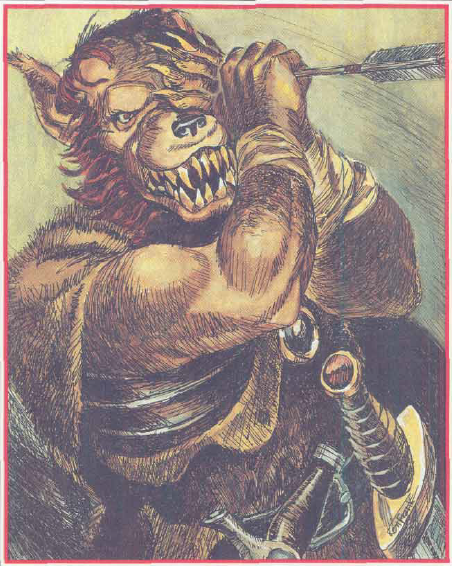
So, crits. In standard AD&D, you roll a nat 20, you do double damage. C&T offers two new systems, one of them means that any 18+(16+ for Grand Masters, which is why it's so fucking insane to be a GM with any weapon) result that does 5 more than necessary to hit, is a double damage crit. This is okay, really, especially since with the armor-ignoring powers of grappling, we'll more or less always be rolling 5 more than we need to hit. But it's not immensely useful, since our main raw damage dealer for grappling doesn't require any rolls to hit(outside of the roll to first establish a Press-style Lock, and the first round of that does the least damage anyway), and therefore can't really crit.
What we want is the second crit method, where crits proc the same way, and do double damage, but then roll for location and severity, causing all sorts of horrible mangling and severing. Because these effects proc any time we land a critical result with an attack roll, by the wording. So even the weak-ass damage we do when first establishing our Hold, before we start twisting off the dragon's head, can do terrible things.
Rolling location is only affected by called shots and stuff like height advantages, we can't do called shots as a Grappler(at least not in a way that requires an attack roll), so our only way of improving our chance at headshots is to leap on enemies from above. Guess we're gonna get some use out of jumping off the turnbuckle.
Severity's what really matters, though, and it's only affected by one thing: The size of our weapon vs the size of our target. Now, here's the thing: It never says what size grappling/unarmed combat in general are as weapons. For punching and kicking you could argue that they're Small weapons, because it's just hands and feet. But Grappling? I mean, we're technically using our entire body, which is bigger than the biggest man-carried weapon(polearms and two-handers), so we definitely qualify for the Large category of weaponry. This means that against man-sized enemies we're rolling 2d6 for severity, and against smaller, 2d8.
This is very good, because crits start getting fun at results of 10 and above.
Basically, 1 to 3 is no effect, 4 to 6 is minor boosts, 7 to 9 is weakening effects, and 10 to 12 is more or less instant death. 10 with most weapons and hit locations renders the enemy unable to move or fight back, 11 reduces them to 0 health, 12 just outright kills them. Now, our opponent gets to save vs death against these effects, but as a GM Grappler, it's not unreasonable to be handing out two or three crits in a round against a target, and each of those has a ~15% chance of getting a 10 to 12 crit(against man-sized targets). So sooner or later one of those crits will get through and our enemy will either be weakened and easier to kill, or we'll just outright fucking crush his skull or tear out his ribcage or something.
Sadly, weapon sizes cap out at Large, at least by the book, so even playing a half-Ogre grappler will not, by RAW, get us any better at critting(though it will give us a +4 to landing wrestle attacks in more or less all cases since we're now Large rather than Man-Sized), unless we can argue to the GM that since our body is larger than a two-handed sword by a considerable factor, we should get to upgrade our weapons size to Huge. So sadly, the much-vaunted 2d8 crit severity is only gonna be against Small enemies(13+ results just replicate the 12 result, but with triple damage, in any case). But I feel like an average 15% chance per grapple to tear off a human-sized opponent's leg and choking them with it is already pretty hardcore.
Obviously some of this reading depends on the individual GM(though I checked with a good number of fellow GM's and they agreed with my logic on the grappling weapon size, so I don't think my logic is too absurd), though even with a worst-possible-reading with Grappling as a Small weapon, attacks that crit(and they regularly will) still have a chance to proc stuff like disarms, stuns and knockdowns at random.
One thing to note here is also that the crit system for C&T actually helps elevate crossbows to quite useful weapons, since Heavy Crossbows(aside from a vital damage boost earlier in the book) count as Large weapons for purpose of crits, so this makes them real damn scary things to get hit by.
The Complete Psionics Handbook
Original SA post AD&D: 2nd Edition
The Complete Psionics Handbook
Unfortunately it turns out that remainder of Combat & Tactics was much drier than I remembered, really only consisting of tables full of siege weapons and more variant weaponry all largely suffering from the same issue as the rest of the 2nd ed AD&D weapons on display: There are a few really optimal choices you'll make, and then the rest will be irrelevant except as flavour.
So instead, I've decided to close off the 2nd ed AD&D review with Psionics, because someone(I forget who, sorry) suggested that I show off why they're such a shitshow. Before this Nerd Court I present Exhibit A: The Complete Psionics Handbook. Which doesn't even have any good cover art! In fact it has none at all! How hard do you have to fuck up to not have good cover art in 2nd ed?
The interior art is a mixed bag, half of it looks like it was ripped from a book about expanding your mind through meditation and peyote:

The other half makes Psionics look cool and awesome if you don't actually read the text and the rules:
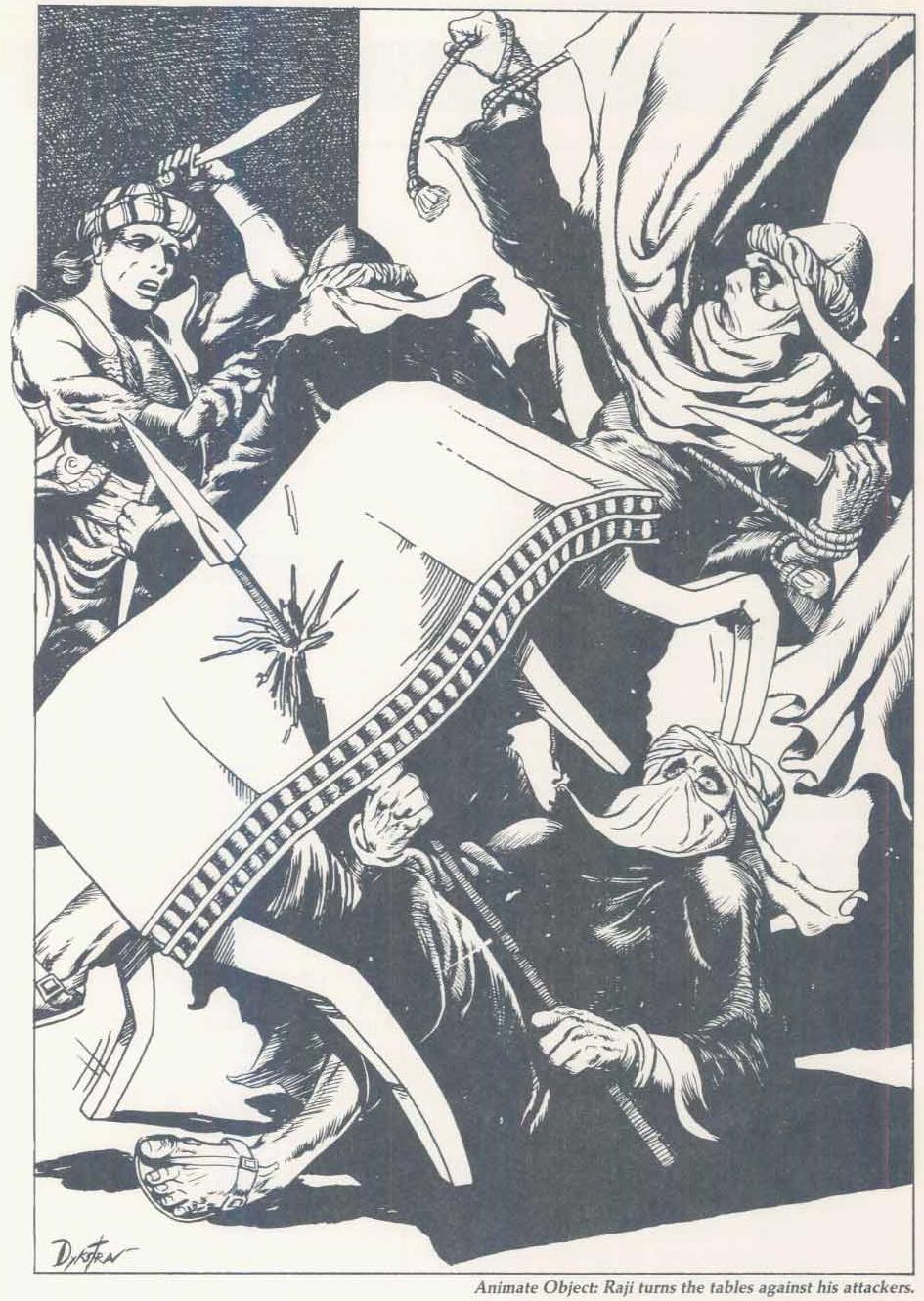
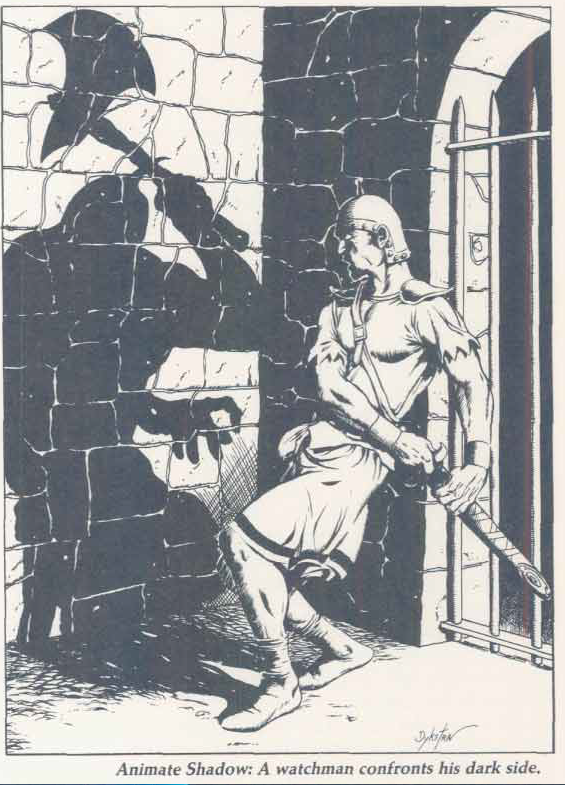
Anyway, let's get started. What are Psionics and what is a Psionicist?
Chapter 1: The Psionicist
Psionics are essentially the third branch of "magic" in AD&D. You've got Arcane and Divine, which function on broadly similar rules, and then Psionics which are wildly different. As mentioned, they function more like NWP's, being that they require checks to use, and those checks are based on stats and do not improve with level(at least until Skills & Powers overhauls them) and instead of having spell memorization and spells per level per day, they run off power points, like brain mana. Powers also generally do not improve with level either. The outcome of this is mostly that Psionicists are quite capable and powerful at low levels(if they have good stats, anyway...) but rapidly get left behind by literally every other class since they only broaden the scope of their powers, and never increase the intensity of them. So the murder they can hand out per action never increases. Also unlike spells, their powers can both crit fail and crit succeed. The crit fails have a decent chance of killing you or completely ruining your day for the more useful powers.
This wouldn't be so bad if every other class didn't do the exact opposite, having a much smaller bag of tricks and getting better and better at it with every level, only rarely adding wholly new tricks.
Outside of his powers, a psionicist is most similar to a thief, having somewhat-similar Thac0 and armor selection(right down to getting worse at his schtick if he wears heavy armor) but considerably worse weapon selection. Once again, outside of the first couple of levels, psionicists engaging in non-psionic combat are going to very rapidly be left behind. You could multiclass them with a Thief or a Fighter to get them something to do outside of their other abilities(they might work very well as thief-psions since psionics are by default silent, meaning they merge well with stealth, or using psionic movement powers as a Fighter to have supreme battlefield mobility if your GM rolls with Combat & Tactics and all the ways it rewards flanking and rear attacks), but then you're stuck being a Dwarf or a Halfling.
At 9th level the psionicist also starts attracting an infinitely refilling number of 1st and 2nd-level psionicist students up to either half his Cha score(if he's wandering) or equal to his Cha score(if he's settled) in exchange for 10 hours of lecturing a week and will "serve in any capacity the master chooses." Good thing you never have to risk any of those crit fails yourself, after this point. Risky power? Make the student use it.
Similarly to how arcane casters have schools and divine casters have spheres, psionics has disciplines. Clairsentience(Divination stuff, truly terrible), Psychokinesis(Telekinetic powers, great if you're fighting a single goblin who's suffered a stroke, otherwise terrible), Psychometabolism(body-changing powers, they're... also bad), Psychoportation(being able to teleport more or less from level 1? Sign me the fuck up. The only objectively "good" discipline), Telepathy(I mean, sure, if you want to drag the game to a halt as you play psychic rock-paper-scissors with someone just to read their mind and learn that their deepest fear is turning into a corb cob, go ahead. Technically has some good powers, but is way too fiddly) and Metapsionics(has one ability that can kind of break the game, and a lot of abilities you will never, ever want to use, by which I mean all the rest of them).
There are also Wild Talents, which can be any character or any class and any race. In the Dark Sun setting, the only one that I know of that really engages with Psionics and makes them part of the setting, all PC's have Wild Talents. In every other setting, any player can choose to be tested for it. This gives you, at best, an 11% chance of having Wild Talents(you're a human non-caster of level 9+ with 18 in your Int, Will and Con) and always has a 4% chance of losing 1d6 Wisdom, Constitution or Intelligence permanently OR having all three stats reduced to 3, permanently. If you do get a Wild Talent, though, you have a chance to have literally any psionic ability(including any prereqs it may have) as well as a few wild card rolls that give you more rerolls or free non-random picks. And of course you also get the power points needed to use it several times per day.
Kinda risky, but sometimes worth the gamble, I guess?
So anyway, I mentioned Telepathy sucks, and this is why.
Chapter 2: Psionic Combat
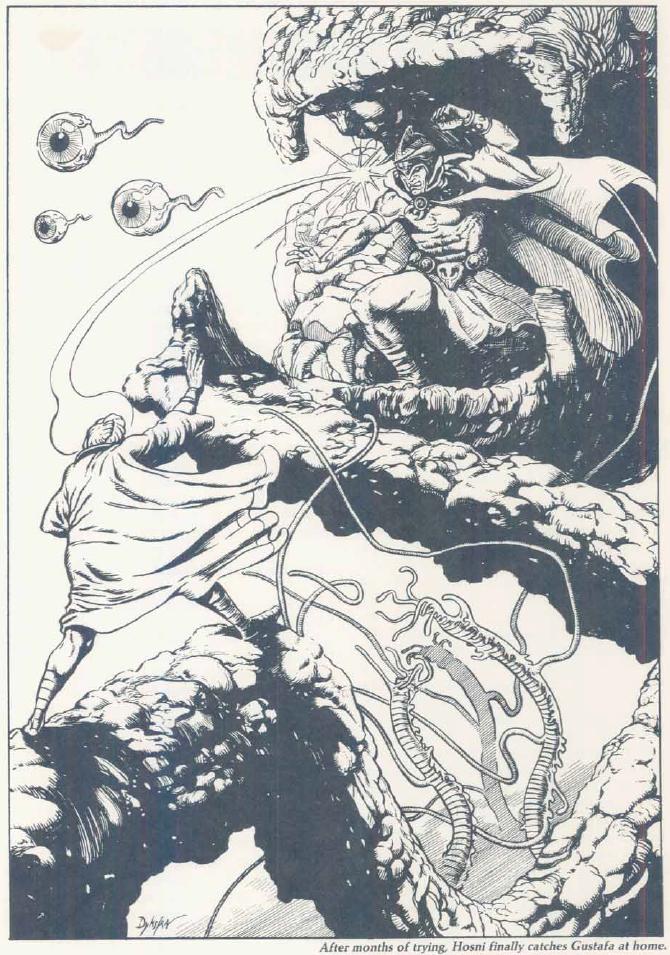
this is not in this chapter. this is not in any chapter at all
So most powers are just "roll your check, it works, maybe the dude gets a save, maybe he does not." Telepathy works differently.
All Telepathy is based off the Contact power. It needs to be stuck once on non-psionicists, and three times on psionicists, for them to be accessible to Telepathic powers. After this, all powers still need to succeed at their roll and be used, but there are no saves against them. Against enemy psionicists there's also a variety of psionic defense powers, which are better or worse resisted by a variety of psionic attack powers, most of which have no real use beyond establishing Contact hits on your enemy.
This means that technically all Telepathic powers require between two and four whole rounds to take effect, rather than a mage or cleric's spell which usually goes off in the same round it's used. Again, it'd be great as a Thief/Psion who doesn't have a party that also wants to play, who can just sneak around and mind control innocent suckers and brainwipe them and stuff. But in the heat of combat, it's considerably less useful.
Now, the actual powers. Because some of these have got to be good, right? Yeah, some of them are. But none of them which are in this next chapter.
Chapter 3: Clairsentience
This is supposed to be the psionic version of Divination. Which it kind of is, except Divination has plenty of spells that give you relevant info. Clairsentience lets you boost your senses to unimaginable, interplanetary levels of reach! Except they're still limited by line of sight, so that's kind of pointless. Also almost the entire discipline has -4 or -5 to its checks, so even with maxed out Wisdom, you're only landing your powers on a roll of 13 or less, and you probably don't have 18 Wisdom, because if you did, you'd be too clever to pick Clairsentience as a discipline.
But some of these are technically useful. How about... Hear Light? Or Feel Sound? Those sure are great powers to have and use.
Literally the only two marginally useful powers are the one that gives the party a -1 bonus to Initiative and the one that lets you read people's alignments(since you can do it subtly without a spell, no one's likely to get offended and you could get some good info that way). But literally those are the only things you'd ever want to invest in, since anything else this school can do can be replicated by a compass, a spyglass or a dose of LSD.
Chapter 4: Psychokinesis
Conceptually, this one starts off strong, with letting you Create Objects from raw materials in a matter of seconds(unfortunately limited by present materials and the size/weight/dimensions of the object) which could have uses, and letting you turn any non-animate matter into a bomb that goes off instantly(this includes being able to blow up plants and non-sentient undead or golems). This does negligible damage to everything nearby, but could be used to blast holes in doors, trigger traps and mechanisms or just completely annihilate certain enemies while laughing. It could also be well used to blow up an enemy's weapon or armor in his face, it's actually a great low-level power since it lets you effortlessly annihilate weak enemies.
Similarly, Disintegrate is also sweet since you can access it at a ridiculously low level, you get to psionically forge weapons or punch enemies with Project Force(since it does 1d6+AC damage, it's useless quickly, but does very strong guaranteed damage against weaker enemies, more or less sure kills in every case if it lands), and of course you can telekinetically lift things, throw things, animate objects(even shadows, for some reason), telekinetically puppeteer enemies(they get a save, and another if you try to make them suicide, but still fucking cool), create defense fields, levitate, melt and ignite things, etc.
All powers that are extremely strong in the first three levels and/or objectively cool as concepts, they just forgot that everyone else is gonna outstrip them. Disintegrate and Detonate really remain as the only two powers that stay sweet and useful outside of the earliest game.
Chapter 5: Psychometabolism
Intended, really, to give the psionicist some body horror and healing abilities. Complete Healing heals literally every point of damage the psionicist has taken and even has a relatively easy barrier to cross, only requiring a non-penalized Con check. Sounds sweet, right? Ha ha no. It takes fucking 24 hours to function. Animal Affinity binds you to one normal animal from the Monstrous Manual permanently, allowing you to temporarily take on one of its stats. Good if it's, say, a bird and you can take on its movement mode(wings), sucks if it's, like, a wolf, or some other animal that offers marginal stat boosts(to, say, Thac0 or AC) at level 1, and then nothing afterwards.
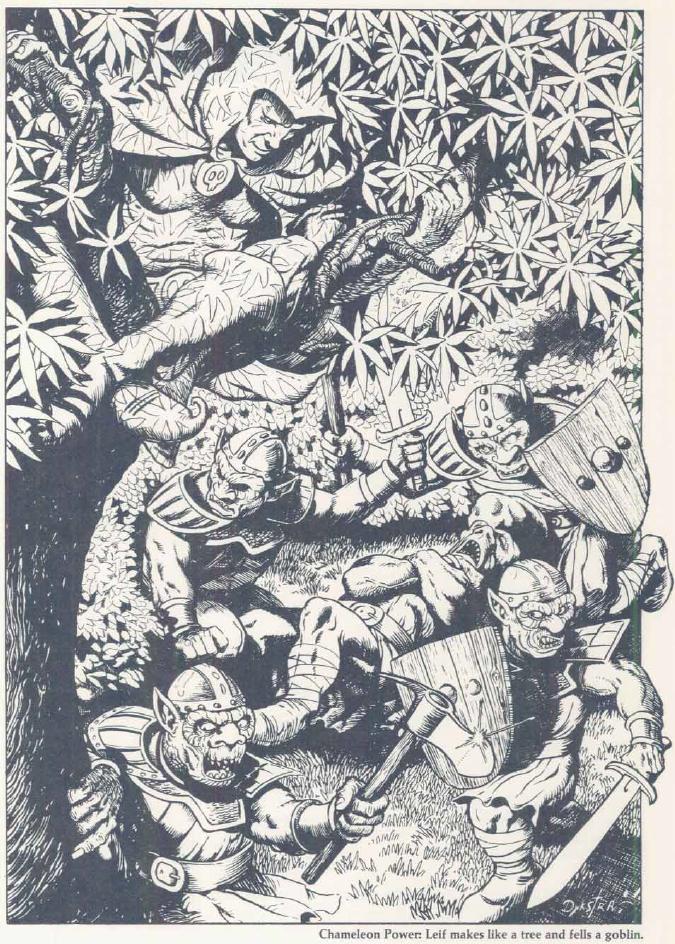
without trying, the book's art "gets" the problem. the psionicists are always fighting weak enemies and they're more or less always by themselves, since their more elaborate tricks wouldn't really work while journeying with normies
You can make a dreadful DEATH FIELD which melts everything inside... and does just as much damage to you, the scrawny guy with a thief's Hit Dice. Whoops. Hope those are goblins you're fighting. Or ants. Let's not get too ambitious. You can also polymorph into anything with roughly the same mass, but you get none of the advantages except movement and physical attacks. Sadly, most human-sized monsters you could transform into have more or less the same stats as humans, and anything that makes them really dangerous is usually magical or their high Thac0.
Ah, but wait, there's more! You could bust out Aging! And if you pass that absurd Con-7 roll to use it you... age the victim by... 1d4, maybe 1d4+1, years. Which will make no difference whatsoever in 99.99999% of all situations. Good use of a combat round, my man. I mean, just think about it, Con-7. That puts the TN for a roll-under check at between 3 and 11, for anyone qualifying to be a psionicist in the first place. Also keep in mind that almost every offensive power in this discipline requires a touch attack, for a class with a thief's Thac0 which has Con, Int and Wis stat reqs, and thus likely hasn't been able to invest much into Strength.
It does have a couple of gems, like Double Pain, which, if you land it, makes an enemy take double damage for 10 combat rounds, with half the damage being "imaginary," thus the enemy only passes out when they drop to 0HP(at which point you can then tie them up or just beat them to death with a rock while they're out cold) or Displacement which can grant a +2 AC bonus on top of all other bonuses, great if you're a Thief/Psion or Fighter/Psion and thus can do more things in fights than rolling up into a ball and crying.
He's got like seven different buffs which each provide a +1 to various aspects of melee combat, and have a maintenance cost in PSP's, meaning if he actually took the time to whip them all up before a fight, he'd be running out of PSP's when he got to the fight. Or if he was using them in the fight, it'd be over by the time he activated them all. And even then a Fighter or Cleric of equal level would still outpace him.
Chapter 6: Psychoportation
So this is the one chapter where Psionicists are objectively a Good Class, because most of the stuff they can do here doesn't interact with hit points or damage done, which become harder hurdles to pass with level, or with saves, which are equally troublesome. The very first power listed, Banishment, just pulls a target out of the world for as long as the Psionicist keeps paying the cost. You could yank an enemy mage away, have the entire party surround the location where he disappeared(after mangling whatever support he had), then initiate a beatdown party or an overbearing attempt as soon as he returns. You could Banish a kidnapping victim or hostage so enemies can't use them as leverage, then bring them back when the situation is resolved. You could Banish a critically injured party member to keep them safe until the enemies are defeated. You could have a Fighter jump off a building, Banish him in mid-air, lure enemies below him and then dispel the power so he drops right on to them and gets chopping, or otherwise use it to set up an ambush. And you know what? It only takes an Int-1 check to pull off. Sure, it's expensive in terms of PSP's, but that's actually one of the hurdles that do improve for psionicists with level.
In addition he can Dimension Door, travel to the Astral Plane, summon planar creatures(picks the plane, but has no control, but, say, a summon from a Lawful Good plane is unlikely to worsen the situation in most cases unless it's an evil party), pop himself into the future and thus gain extra(non-attack) rounds to act(like running away, drinking potions, setting up traps, maneuvering for position which gives a massive +4 to hit not counting any potential flanking/rear bonuses, etc.).
It's not a very varied discipline, but it has the only powers that both a 1st level and 20th level psionicist would be equally likely to make use of.
Chapter 7: Telepathy
So, Telepathy. Technically, it has some good options, you can Dominate people, turn Invisible, etc... except everything takes at least two rounds(Contact and THEN using the power) and enemies do get traditional saves against some things(like Domination), which means you can really just do what Mages can do, except in a worse, clunkier way. Additionally, we're back to -4 to -6 modifiers for using every single vaguely useful Telepathy power(like Mindwipe, which temporarily reduces the target by 1 level or 1 hit die as it locks off part of their memories and experiences). Even when there's a technically badass power, like Switch Personality, which would allow you to swap your fragile wimp psionic into a better body if you can just get close and pass a couple of tough rolls... they nerf it by making bodies that aren't "yours" slowly rot away to the tune of 1 point of Con every day, which means that all but the most badass of hosts would barely last you a couple of weeks. And also in the meantime whoever you stole a body from is likely holding your own body hostage or something, so you might not even have a decent body to return to at the end of it.
Strangely enough, the most consistently useful Telepathy powers are the ones intended primarily for scoring Contact points so other powers can be used. If they're used on someone already Contacted, they have different effects, like Ego Whip, which lashes an opponent with a massive -5 to all things and an inability to cast spells of level 4+, Id Insinuation which paralyzes the target for 1d4 rounds or Psionic Blast which instantly reduces the target to 20% of his max health(again, like Inflict Pain, only in his mind, but it's still useful, as noted there).
At this point, all the actually useful powers could be rolled into one single Discipline and you'd still have less powers than, say, Psychometabolism.
Chapter 8: Metapsionics
Metapsionics really only has two powers that are actually worth anything: Empower, which allows you to create psionic "magic items" which are sentient and can basically use powers for you, and Split Personality, which allows you to take one extra Psionic action per turn. Both of these are also the only way to make a Psionicist competitive in any way, because when their individual powers have a very strict power ceiling, the only way to keep up is to use more powers in a given span of time. Project Force is great at first level, okay at second and third. Beyond that, it's forgettable. But if you could hurl three of them every round, it could remain a competitive way of doing damage.
Unfortunately, he can't even dream of busting these out until level 10, some of the few things for Psionics that are actively level-gated(rather than just being gated by requiring crazy amounts of PSP's). There's also Magnify, at 6th level, which multipliers the effects of powers, but that lets you do stuff like a grand total of 2d10 damage at level 6, in exchange for a massive amount of PSP's... and spending two rounds, because of course Magnify requires you spending a full round to activate it. That means you're still doing 1d10 damage per round to one or two targets while a Mage does 5d6 damage to potentially a large number of targets.
Conclusion: Psionics? More like Suckonics, lol
But in all seriousness, Psionics is more or less the only real departure from Vancian casting outside of 4th edition D&D(unless 3rd ed also played with psionics, I never touched them and I never experienced anyone else who actually used them. So I assume they're in the same hellish state as 2nd ed psionics), and they just bungled it hardcore, creating a class that can dominate the game for two levels and then gets bullied by even the wimpiest wizard.
All they had to do was let the powers scale somewhat with level and also make the powers easier to use as psionicists levelled up, and it would've been an okay class. Still no Fighter, but at least playable.
Goddammit TSR, you hacks.